
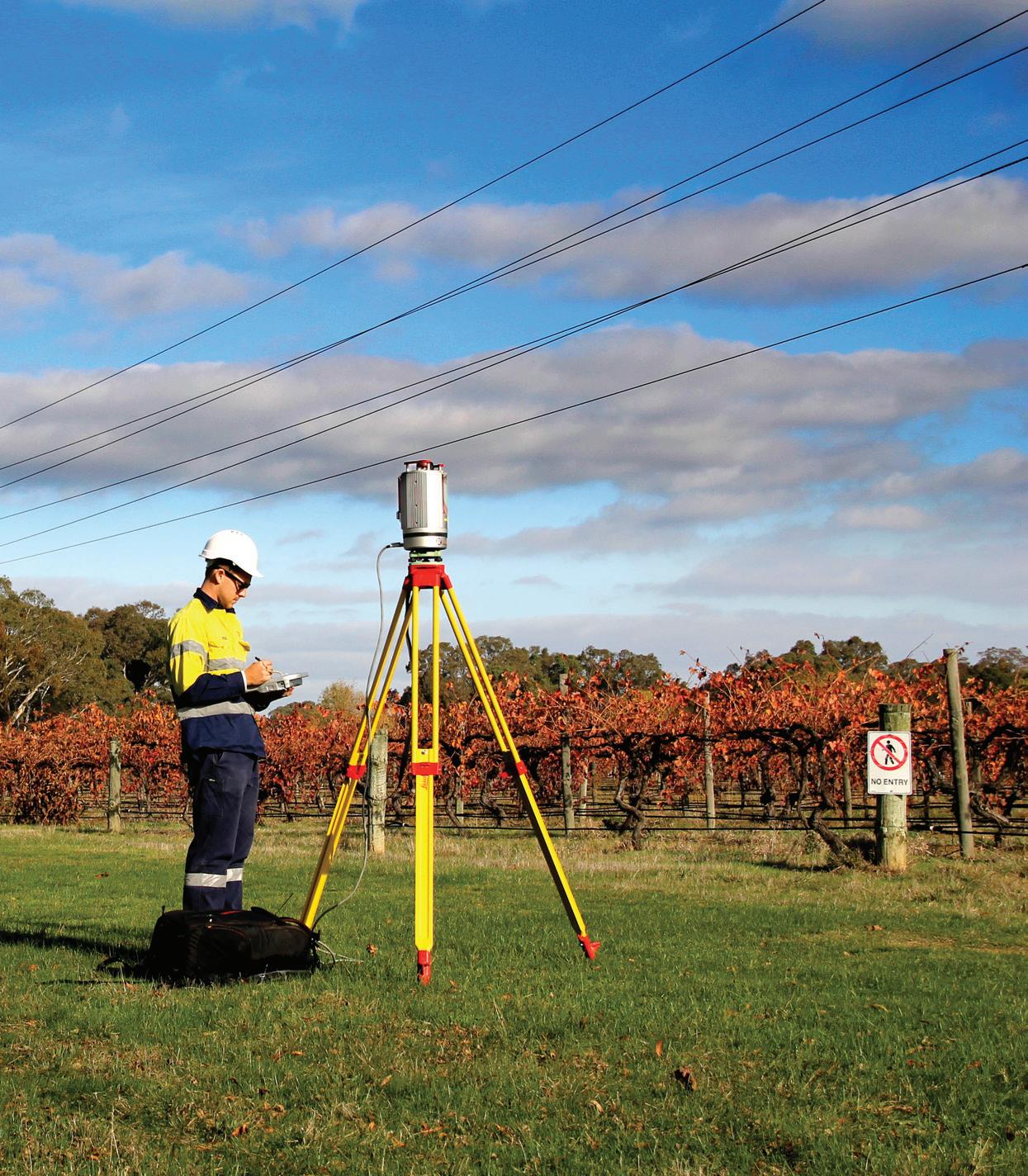
IRRIGATION INNOVATION: PUTTING WATER BACK IN THE MURRAY MAKING METERING SMARTER ON DIGITAL UTILITIES KEVIN HUTCHINGS
WATER | SEWER | ELECTRICITY | GAS | NBN Engineering, Construction & Maintenance www.utilitymagazine.com.au Issue #10, May 2016
WITH SPATIAL SURVEYING FIGHTING FIRES





Monkey Media Enterprises
ABN: 36 426 734 954
PO Box 3121
Ivanhoe North VIC 3079
P: (03) 9440 5721
F: (03) 8456 6720
monkeymedia.com.au
info@monkeymedia.com.au
utilitymagazine.com.au
info@utilitymagazine.com.au
ISSN: 2203-2797
FROM THE EDITOR
Innovation seems to be the word of the moment, ever since late last year, when Prime Minister Malcolm Turnbull unveiled his government’s National Innovation and Science agenda, with a focus on creating a modern, dynamic, 21st century economy for Australia.
Innovation has been a key focus for utilities in recent months as well. Coming off the back of one of the most disruptive years the industry has ever seen, utilities are realising that the answers to the challenges they currently face lie in innovation. With innovation, challenges become opportunities, and the closing of doors leads to the opening of others.
The energy sector faced its share of disruption in 2015, and this will only continue to be the case in 2016 and beyond. Distributed generation options are proving to be more popular, more effective and more efficient than ever before, and recent improvements in battery storage have been the key catalyst for this change. While these changes present a challenge for the energy industry, they also present opportunities. Mark Coughlin, PwC Australia’s energy, utilities and mining leader, argues in this issue that there’s never been a more exciting time to be an Australian energy provider. He also states that the core capabilities for the utility of the future will be an ability to influence the agenda; and to respond quickly to the ever-changing needs of customers.
One of the industry’s biggest champions of these ideals has to be Kevin Hutchings, Managing Director of South East Water in Victoria. Kevin is passionate about the opportunities new technologies, new ways of thinking and
new ways of engaging with customers present utilities, and he is forging a path for South East Water to establish itself as a truly digital utility. It’s been a privilege to gain insights into Kevin’s thoughts and ideas on this topic in this issue, and I hope you enjoy the opinion piece he’s provided as much as we have.
Whether it’s water or energy, there’s one key element that will bring these industries closer to the innovative, digital future we’re striving for, and that’s smart meters. Advanced metering gives utilities the tools to better respond to their customers’ needs, and provide the kind of information customers now expect access to. In this issue, we take a closer look at how the rollout of meters around the country is progressing; and consider some of the reasons why utilities need to act now and take advantage of the benefits this technology can provide. This is the biggest issue of Utility we’ve produced to date; and I’m thrilled that we will be sharing a magazine of this high standard with delegates at a record nine industry events around the country. Through our ongoing partnership with WIOA, this magazine will be distributed at WIOA’s Queensland event in June; and we also have partnerships with the ENA, Irrigation Australia, GITA and the Energy Storage Council which will see this magazine distributed at their events. You’ll also be able to find copies of Utility at OzWater and Australian Energy Week. The Utility team, including myself, will be attending all of these events, and we look forward to seeing as many of you as possible over the coming months.
by ISSUE 10 May 2016 Cover image shows Geomatic Technologies surveying the Powercor AusNet Services network. WATER SEWER ELECTRICITY GAS NBN Engineering, Construction & Maintenance IRRIGATION INNOVATION: PUTTING WATER BACK IN THE MURRAY MAKING METERING SMARTER ON DIGITAL UTILITIES KEVIN HUTCHINGS WITH SPATIAL SURVEYING FIGHTING FIRES
Published
Chris Bland Publisher and Editor Publisher and Editor
Bland Managing Editor
Associate Editors
Goldsmith
Journalist Jessica Dickers Marketing Director
Kennedy
Harbinson
Designer
Creative Director
by
Chris
Laura Harvey
Michelle
Emily Thomas
Amanda
Marketing Consultants Aaron White Jordan
Graphic
Alejandro Molano
Sandy Noke Monkey Media Enterprises ABN: 36 426 734 954 PO Box 3121 Ivanhoe North VIC 3079 P: (03) 9440 5721 F: (03) 8456 6720 monkeymedia.com.au info@monkeymedia.com.au utilitymagazine.com.au info@utilitymagazine.com.au ISSN: 2203-2797 Published
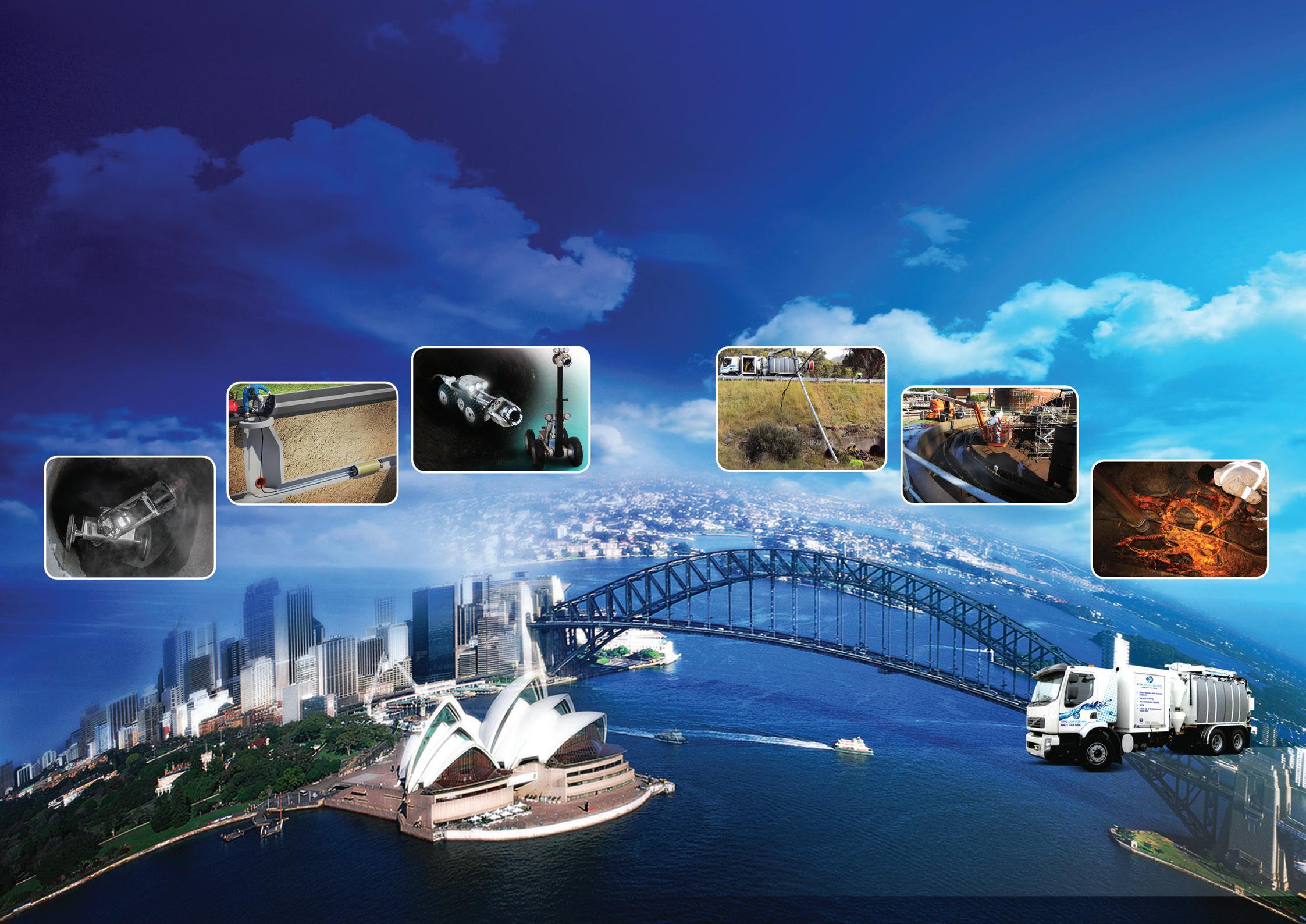



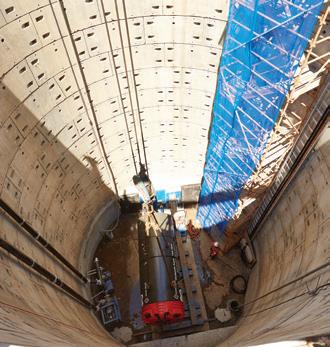



6 CONTENTS 20 30 42 72 82 88 MAPPING, GIS & SURVEYING Managing Victoria’s bushfire risk with spatial surveying 20 The new hub of water utility innovation ................................... 24 Enhancing value and confidence through accurate asset location data .............................................. 26 SMART METERS Plotting a path to digital success ........................................ 30 Making metering smarter .......... 34 How the cloud is helping utilities cope with the smart meter data deluge .......................................... 38 Setting the agenda for smart meters in Australia 40 MICROTUNNELLING Breaking records in long drive microtunnelling........................... 42 Safety from the ground up ........ 44 CONDITION ASSESSMENT How are utilities banding together to manage assets? 88 IRRIGATION Irrigation innovation: putting water back in the Murray ................................... 92 M2M AND MOBILITY Digital utilities: adapting to consumer expectations and operational realities .................... 82 Taking the first step towards smarter mobility: making utility service more reliable 86 i STORAGE EV2G – imminent reality or electric fiction? 72 Energy storage: the path to reaching critical mass ................. 76 DISTRIBUTED GENERATION What will drive the power sector in 2016? ........................................ 78




NBN Ramping up the rollout 96 VEGETATION MANAGEMENT ActewAGL takes flight to inspect its network 100 ISSUE 10 7 46 58 64 WATER Odour control at Gold Coast Water 46 Modelling catchments, managing risk ............................. 48 Reliability, efficiency and superior performance ................................ 52 Increasing the efficiency of our water assets 54 Smart rain: tracking inflow and infiltration .................................... 56 PROJECTS Drilling for a sustainable future ........................................... 58 Smart sewers: revolutionising the way utilities manage wastewater networks 60 72 In each issue Editor’s welcome .................................................. 1 A word from the ENA .......................................... 6 A word from WSAA ............................................ 10 News briefs ......................................................... 12 Advertisers’ index ............................................ 108 Editorial schedule ............................................ 108 96 106 Utility magazine is bringing together experts on various fields to answer all your questions ENERGY NETWORKS The evolving role of power utilities in Australia: placing paramount importance on customer experience ................................... 64 Levelling the playing field for local energy through tariff reform ...... 68 Proactively managing networks 70
A WORD FROM THE ENA
JOHN BRADLEY CHIEF EXECUTIVE OFFICER – ENERGY NETWORKS ASSOCIATION
Henry Ford, pioneer of the assembly line, is famously quoted as saying his customer could have “…any colour he wants, so long as it’s black”. In practice, there were a few of the great Model T Fords made in grey, green, blue and red.
Our technology today permits consumer choice and the customisation of products and services on a global, 24/7, peer-to-peer sharing scale. While the customer was always king, their royal command is increasingly anticipated by a learning algorithm with a personalised experience.
Customisation looks set to become the ‘new normal’ in energy, where the low-engagement commodity is being replaced by a services market focused on customer needs, drivers and aspirations. The Internet of Things is converging, with distributed energy resources and digitisation transforming the energy system, which was originally designed for the one-way flow of energy from large-scale producers to consumers. Today, the system is becoming a two-way exchange network, enabling the exchange of energy and information, and increasing consumer choice.
While the grid is still critical to the safe and reliable supply of electricity, a multiplicity of options for customers to interact with the system have been added to the mix: rooftop solar panels, energy storage systems, electric vehicles, home automation, energy management systems, and advisory services. With over 14 million customer connections, energy networks are the platform for enabling this customer interaction with energy services and technology.
The Consumer Engagement Handbook is an initiative under the ENA and CSIRO Electricity Network Transformation Roadmap. It builds on the Roadmap’s Interim Report released at the end of 2015, which recognised that there is no single energy customer, but rather they are increasingly diverse.
The Handbook has been developed with input from consumer representatives and informed by CSIRO social science expertise. It aims to complement existing guidance, such as that from the Australian Energy Regulator (AER), and the leading work of key customer advocates, including Energy Consumers Australia. It is not the final word, but a living document designed to foster continuous improvement and information sharing, tailored specifically to engagement in the energy sector.

Australia’s energy sector has increased effective engagement in recent years. Energy network providers now undertake significant engagement with customers in the development of five-year plans and proposed tariff structures, to inform network planning and maintenance and vegetation management, and in recovering from natural disasters. These activities are already guided by the Consumer Engagement Guideline for Network Service Providers released by the AER in 2013. The AER’s Guideline aims to help network service providers develop consumer engagement strategies and approaches, and also help them prepare spending proposals that reflect consumers’ long-term interests.
With so much experimentation underway in new engagement methods, and with so much time and investment by customers, stakeholders and energy providers, the Consumer Engagement Handbook seeks to share insights. The goals of the Handbook are to:
• Provide best practice guidance to ENA member businesses for engaging with consumers
• Strengthen relationships with consumers and consumer groups
• Support the use of performance measurement and indicator tools in engagement activities
• Provide the opportunity for continuous learning and evolution of engagement activities
• Leverage and expand the relationships between networks.
The Handbook features practical examples of engagement practices across the utility sector to provide guidance on the coordination of future engagement activities between energy network businesses, energy institutions and consumers.
It is recognised by energy network businesses that effective evaluation requires reliable and valid measurement of key indicators. Similarly, as part of their five-yearly assessment of energy network businesses’ revenue proposals, the AER considers the extent and quality of community engagement. However, despite the clear importance of consumer engagement and the value in continuous improvement, there are few standard measures to evaluate success.
The Handbook identifies a set of Key Performance Indicators and how they could be measured. It also identifies the importance of establishing an engagement culture incorporated into business planning and strategic goals.
8
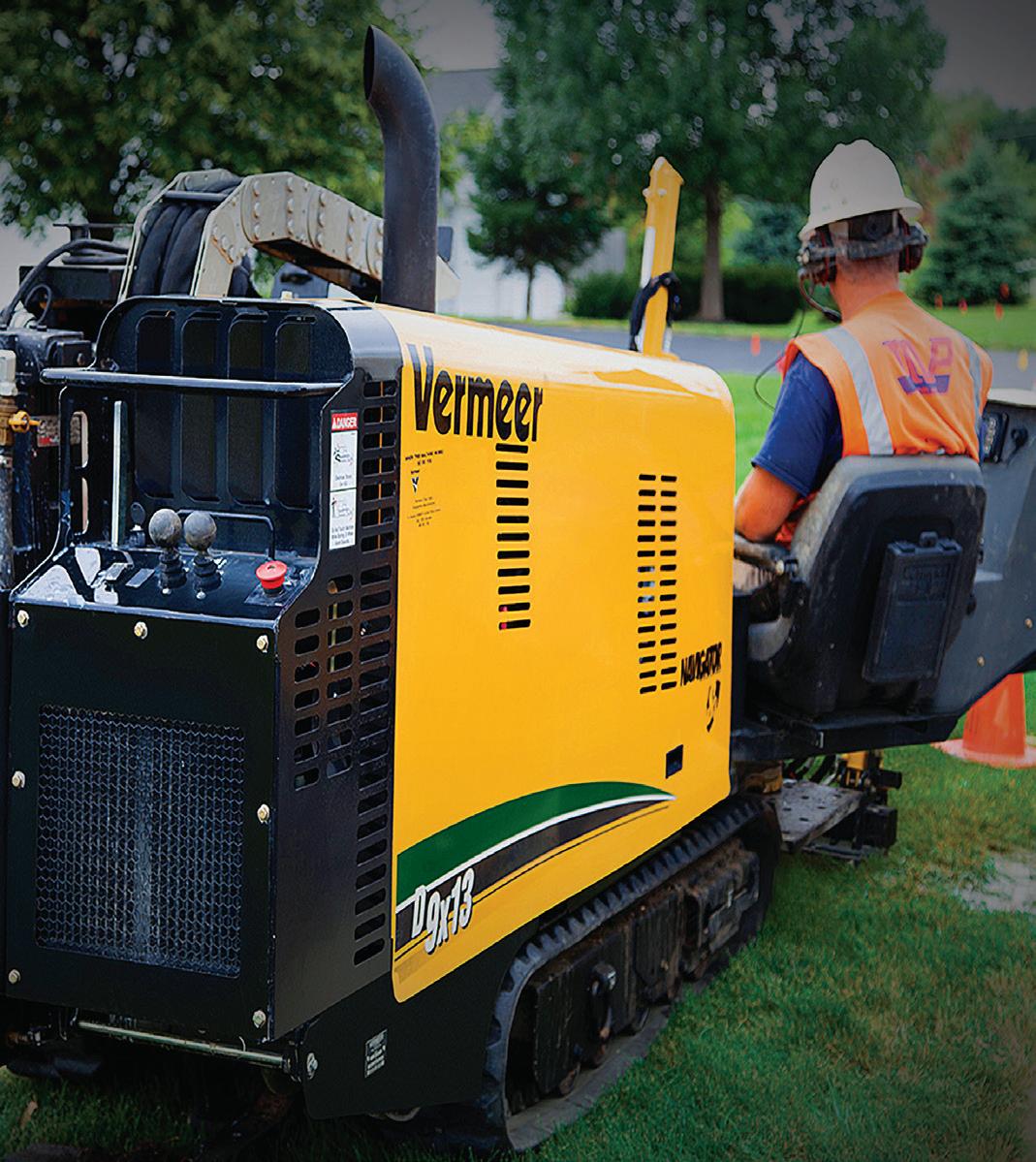
Combined with extendable track width for side-hill stability, a durable one-piece hinged hood, and Vermeer’s legendary build quality and unmatched local dealer support, you’ve got the ideal partner for today’s fibre installation environment.

Same familiar controls More metres in the ground Gets there faster Access all areas Vermeer and the Vermeer logo are trademarks of Vermeer Manufacturing Company in the United States and / or other countries. © 2014 Vermeer Corporation. All Rights Reserved. D9X13 NAVIGATOR ® S3. GET EQUIPPED. / VermeerAustralia WWW.VERMEER.COM.AU | 1300 VERMEER WWW.VERMEERWA.COM.AU | 1800 195 558 (WA & NT) VERMEER’S D9X13 NAVIGATOR® SERIES 3 THE NEW LEADER IN LEAD-INS GET
THE NEW
THROUGH MORE SHOTS EVERY DAY WITH
VERMEER D9X13 NAVIGATOR® S3. Featuring a 26% increase in carriage speed, a 37% increase in ground drive speed, and a narrow profile to get to the most confined job sites, the Series 3 D9x13 Navigator helps you fit more metres into to the working day.
A WORD FROM THE ENA
During the development of the Consumer Engagement Handbook, clear feedback from both network businesses and stakeholders was that, for consumer engagement to be successful, network businesses must:
• Demonstrate how a particular piece of engagement fits into the overall engagement plan
• Attempt to include views from all relevant stakeholders, including hard-to-reach groups, and ensure those engaged are representative of the entire community
• Be clear about the goals of the engagement and the performance measures
• Be clear about “wriggle room” – if there are limits to what the response to engagement outcomes can be, these need to be clear up-front
• Ensure those who are engaged can identify where and how their feedback has been taken into account.
Customising energy services is now possible in ways
that Henry Ford would never have imagined. The customer experience can now be shaped not only by traditional retailers, networks and new providers, but by each customer themselves. This will create as many new challenges for supporting vulnerable customers as it will opportunities for better engagement.
An investment in effective, genuine engagement can unlock not only better outcomes for our customers, but the long-term sustainability of our own businesses.
Find out more about the Electricity Network Transformation Roadmap and the Consumer Engagement Handbook from the ENA website, www.ena.asn.au.
John Bradley Chief Executive Officer Energy Networks Association

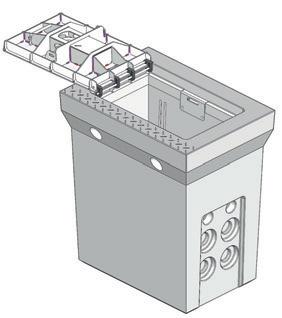


10
378 BVCI Utility Half Page ad final out.indd 1 12/11/15 10:22 AM
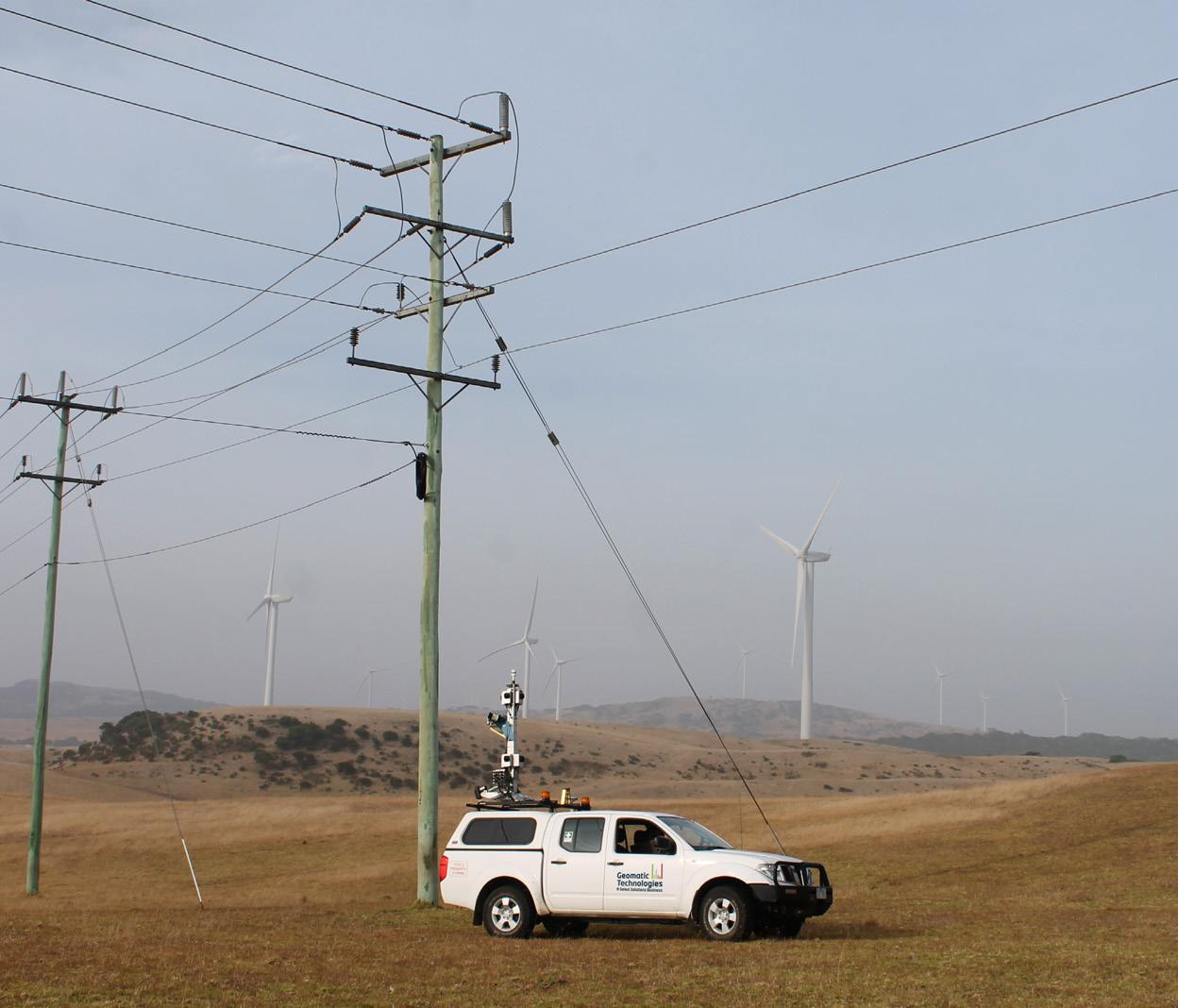
MAKE INFORMED DECISIONS ABOUT YOUR ASSETS
DEVELOPING ADVANCED MOBILE AND SPATIAL TECHNOLOGY SOLUTIONS TO SOLVE COMPLEX ASSET AND DATA MANAGEMENT CHALLENGES IN THE UTILITY, TRANSPORT AND GOVERNMENT SECTORS.
For more than 20 years, Geomatic Technologies have worked closely with essential infrastructure owners, operators and maintainers, meeting their unique needs with technology solutions that capture, assess, manage, and report on asset condition and performance.
As a division of Select Solutions, our key strength is in creating solutions that deliver ‘Asset Intelligence’. Empowering infrastructure businesses to make truly informed decisions about their network.
TO FIND OUT ABOUT OUR MOBILITY AND SPATIAL SOLUTIONS
email: enquiry@geomatic.com.au
www.geomatic.com.au
www.select-solutions.com.au
your partner in metering & asset intelligence
A WORD FROM THE WSAA
ADAM LOVELL EXECUTIVE DIRECTOR – WATER SERVICES ASSOCIATION OF AUSTRALIA
Compared to other infrastructure and essential service sectors, the urban water sector is often overlooked. Nevertheless, the fundamental requirements of having world class urban water systems and infrastructure (with assets with a value of over $160 billion as at 1 July 2015) delivering the necessary public health, liveability and productivity outcomes of our cities and communities cannot be understated.
Urban water in Australia has been ‘self-funded’ and corporatised since the early 1990s, allowing newly formed businesses to seek new innovations and private sector partners to drive efficiencies without loss of service. The industry delivers high quality water and wastewater services, as measured independently in the National Performance Report. It recovers the costs of these services from customers, and does not rely on budget funding or large announcements to construct infrastructure. While bills to our customers have increased to fund water security, satisfaction levels remain high and complaints (as recorded by various state ombudsmen) are significantly lower than many other sectors. All of which means, in some policymakers views, urban water lacks a burning platform for reform.
However, to avoid urgent and costly decisions in the future, there is a strong case for renewed national policy leadership.
Last November, WSAA, in partnership with Infrastructure Partnerships Australia (IPA), released the report Doing the important, as well as the urgent: reforming the urban water sector. Launched by Treasurer Scott Morrison, the report calls on the Commonwealth Government to drive a new five-year program of reform across the states and territories, supported by meaningful financial incentives and including a new National Water Initiative.
Australians continue to enjoy world class water and wastewater services, and water utilities are focusing on driving increased customer value and affordable bills. But to continue to do that, the regulatory and governance structures they operate in need to be refreshed to promote the long-term interests of customers.
Over the last few years there have been a series of reports by federal bodies, such as Infrastructure Australia, Harper Competition Review, the now abolished National Water Commission and the Productivity Commission, that all point to an emerging need for a renewed commitment to national leadership in water management, coordinated infrastructure planning for the built environment and a focus on new ways of regulating the sector to focus on customer value and provide the right conditions for more innovation. With existing settings, we are poorly equipped to meet this need.
Most recently, on 17 February 2016, Infrastructure Australia released its Australian Infrastructure Plan. While media reporting focused on transport and roads, there were also recommendations in the plan relating to urban water, including a recommendation for better independent economic regulation of the sector and the establishment

of a national water framework. Specifically, recommendation 6.12 states that the Federal Government should work with state and territory governments to establish an independent national body to deliver a National Water Reform Plan.
WSAA supports this recommendation. In our report on reforming the urban water sector, we call for a permanent national champion for urban water reform. We believe now is the time to position the urban water sector so that it can better meet the challenges ahead, at the least cost to the community.
To address these challenges we recommend that Australia needs national leadership in urban water policy. Although urban water is owned, operated and regulated by sovereign states, there is a strong case for renewed national leadership in urban water policy, in the interests of customers, the environment and national economic productivity.
As we look to the future, urban water needs to be better integrated in to city planning, including coordinated integration of stormwater services to meet community expectations of our highly valued liveable cities and communities. Urban water utilities play important roles in providing everything from clean beaches and waterways, through to contributing to public health and national economic priorities. At present, opportunities to improve liveability are forgone due to unclear roles and responsibilities between policymakers and corporatised water utilities.
Beyond that, water utilities are well placed to harness the benefits of the digital transformation currently underway in the economy. Utilities collect millions of data points, demonstrating the growing benefits of artificial intelligence; utilities with thousands of kilometres of pipes and hundreds of facilities are ripe to reap the benefits of the Internet of Everything; and finally water utilities deliver essential services 24/7, 365 days of the year. The explosion of wet wipes as an issue in the past two to three years has shown that immediate and grassroots engagement with customers using Facebook and Twitter can rapidly bring an issue alive and drive change very quickly.
Water utilities in Australia and New Zealand continue to develop and undertake significant benchmarking programs. This year the Asset Management benchmarking program (the Asset Management Customer Value project) will be delivered. Together with the highly successful collaboration with Isle Utilities (based in the UK) to assess pre-commercialised technology and innovations across the entire urban water cycle, utilities are working hard to be as efficient and effective as possible, while looking over the horizon at emerging technologies.
WSAA will continue to advocate for renewed national policy leadership – backed with meaningful incentives – to elevate the consensus about the importance of good water policy into an actionable national leadership initiative.
Adam Lovell Executive Director Water Services Association of Australia
12
METASPHERE TELEMETRY PROVIDES ROBUST ASSET MONITORING:
WATER, WASTEWATER & STORMWATER - IP68 RTU’s
SMART METERING - Analogue, Digital, Pulsed and Serial Inputs
GAS & MINING SECTORS - Intrinsically Safe RTU’s
ENVIRONMENTAL MONITORING & REPORTING - River flows, Flooding, Rainfall
OPERATIONAL LICENSING & REQUIREMENTS
ROAD & MARITIME APPLICATIONS




BENEFIT FROM OUR 4Cs:
1
2
COLLECT
Telemetry Data; Alarms; Trends
CONNECT
2G, 3G
Secure IP; PSTN; Radio & Satellite
Collect data from remote assets and meet regulatory compliance
email info@metasphere.net.au
or call 1300 785 681
www.metasphere.net.au
3
palette palette palette
4
COMMUNICATE
Visualisation & Reporting Decision Support
CONTROL
Assets; Network; Performance
AEMO WARNS OF GAS SHORTAGE
Developed gas reserves in eastern Australia will only meet demand until 2019, a report from the Australian Energy Market Operator (AEMO) warns.
Market data from the AEMO’s 2016 Gas Statement of Opportunities (GSOO) shows gas reserve development is required by 2019 to maintain long-term gas supply adequacy in eastern and south-eastern Australia.
AEMO Managing Director and Chief Executive Officer Matt Zema said that while there are no gas supply shortfalls forecast until 2029, the 2016 GSOO shows that developed gas reserves in eastern and south-eastern Australia are only sufficient to meet forecast gas demand until 2019.
Mr Zema said, “This means that currently undeveloped gas reserves, including those reported as contingent resources and possible reserves, will be required to ‘come online’ to meet forecast demand as early as 2019 when
developed reserves are forecast to start to deplete.”
Mr Zema said that the need to convert undeveloped gas reserves and resources into working gas fields from 2019 reflects forecasts from AEMO’s 2015 National Gas Forecasting Report (NGFR), which projects that total annual gas consumption in eastern and south-eastern Australia will double over the next five years to 2020 as Queensland’s liquefied natural gas (LNG) export facilities ramp up production.
The 2016 GSOO uses the demand forecast scenarios from the 2015 NGFR, and production and supply information provided by industry, including wholesale gas contract information, to assess the adequacy of gas infrastructure and resources to meet demand in eastern and southeastern Australia to 2035.
The GSOO is based on data provided by industry participants up to 10 December 2015.
“The need to convert undeveloped gas reserves and resources into working gas fields from 2019 becomes clearer still when we take export LNG demand out of the picture,” Mr Zema said.
The Australian Petroleum Production and Exploration Association (APPEA) said governments in eastern Australia must pull out all stops to encourage the investment needed to address predicted gas shortages highlighted by AEMO.
APPEA Chief Executive Dr Malcolm Roberts said, “The information released by AEMO is a sobering reminder that the east coast needs rapid development of new gas reserves to guarantee supply.
“We have long argued that if we wish to achieve a more competitive market, put downward pressure on prices and ensure stable, adequate supply, we must bring more gas to market.”
TRANSGRID APPOINTS NEW CEO
The former CEO of Western Power has been announced as the new Chief Executive Officer (CEO) of TransGrid.
TransGrid has appointed Paul Italiano as its new CEO, effective from mid-2016.
Having recently completed its 99-year lease transaction from a state owned corporation to private ownership, TransGrid is focused on providing a safe, reliable and efficient electricity transmission and related services, in an increasingly challenging and competitive market.
Mr Italiano is a transformational leader who has turned around the performance and service standards,
safety culture, operating framework and financial results of Western Power (WA) during his four-year tenure as CEO.
When Mr Italiano takes up his position midyear he will replace Peter McIntyre, who has led TransGrid since 2010.
In the interim, Ian Stirling will act as CEO. Mr Stirling is most notably known for his successes as CEO over a 12year period with the South Australian electricity transmission business ElectraNet.
TransGrid Chairman Rick Francis said, “On behalf of the board and NSW Electricity Networks as the new owners, I want to both acknowledge
and thank outgoing CEO Peter McIntyre for his stewardship of the business over his many years of service.
“Peter was instrumental in building a successful corporatised business in a state-owned environment and facilitating an extremely successful outcome from the NSW Government’s privatisation process.
”I am very much looking forward to working with Paul to take TransGrid to its next level of development. His dynamic leadership style, commercial acumen and proven ability to transform a business in the face of significant challenges make him an excellent choice for the role.”
NEWS 14





Contact us today for a quote NSW 02 9605 4723 QLD 07 5573 2694 | www.pmaus.com.au
and resource projects
MICROTRAXX CCTV
MAINTENANCE
Pipe Management Australia is a professional, capable contractor preferred on many of Australia’s largest construction
HYDRO EXCAVATION
PIPE INSPECTIONS Utility Maintenance Contractors DRAIN

VIC GOVERNMENT ORDERS DESALINATED WATER
The Victorian Government has placed an order for 50 gigalitres (GL) of desalinated water to be delivered in Summer 2017 to help Melbourne’s low water levels.
Melbourne’s water storages have been declining steadily for the past two years and have dropped by 152GL in the past year.
Victorian Premier Daniel Andrews said “We’ve always said the desalination plant is our insurance policy to secure our water supply and boost the amount of water available in the water grid – now it’s in Victoria’s best interests that we call on that insurance.
“As our population continues to grow and our state faces drought, we need to secure water supplies for Victorian communities – and adding
desalinated water will help us meet these challenges.”
Advice provided to the Government by Melbourne Water, in consultation with the three metropolitan retailers, recommended placing a water order of 50GL.
The advice is based on a detailed analysis that considers current water levels in the storages, the likelihood of low inflows, dry conditions in the short term, and forecast demand.
Victorian Minister for Environment, Climate Change and Water, Lisa Neville, said, “The Government has responded to the advice of Melbourne’s water corporations and will place an order to help provide Melbourne and our region’s water security.
“We’re taking action so that kids don’t have to play on rock hard ovals,
NEW ENERGY RETAILER ENTERS AUSTRALIAN MARKET
Australia has a new energy retailer, aiming to help consumers use more renewable energy.
The Australian Renewable Energy Agency (ARENA) and SBCVC have backed a $5 million Southern Cross Renewable Energy Fund investment into new retailer, Mojo Power.
ARENA CEO Ivor Frischknecht said “Mojo Power supplies electricity to its customers at cost and charges a fixed monthly fee. This allows Mojo to focus on working with customers to unlock cheaper energy bills through solar, storage and energy efficiency.
“Australians have embraced
residential solar in big way, with a world-leading 20 per cent of households so far installing panels on their roofs.
“Using state-of-the-art smart metering technology, Mojo will be able to analyse customer usage data with a view to optimising energy use and demonstrating how households could benefit from renewable energy technologies.”
Mr Frischknecht said customers will be able to access more information about their energy usage, making them better placed to take the steps needed to run smarter homes.
“If Mojo successfully taps into the
so gardens and sporting ovals are green and will ensure a secure water supply for schools, hospitals and homes from Melbourne to Ballarat.”
The order will increase the amount of water that could be moved through the water grid – which assists water security for Ballarat, where storage levels currently sit at 52 per cent, Geelong, which is sitting at below 40 per cent, and other regional communities.
The cost of the order will add $12 a year to the average metropolitan water bill, however a Melbourne Water proposal being considered by the Essential Services Commission could reduce water bills by more than that amount.
Australian market, it could encourage even more households to invest in solar, which in turn will help drive down costs.
“It also has the potential to accelerate the growth of Australia’s emerging battery storage industry as consumers look for more value from their rooftop systems.”
The investment from the Southern Cross Renewable Energy Fund will help Mojo with market-entry and business expansion activities.
Mojo founder and CEO James Myatt said “Mojo’s model is a real game changer and it will benefit those households that currently face high electricity bills. We are absolutely aligned with the customers’ primary objective, which is to pay less for the electricity they need.”
NEWS 16
THE ORDER OF DESALINATED WATER WILL SECURE MELBOURNE’S WATER SUPPLIES AND HELP KEEP THE CITY GREEN.

INMARSAT SERVICES AVAILABLE ON AUSTRALIAN SATELLITE NETWORK
Pivotel Satellite has launched Inmarsat voice services for its customers, providing Pivotel customers with access to Inmarsat’s reliable global L-band voice connectivity throughout Australia.
Pivotel is well known for uniquely providing standard ‘04’ Australian mobile numbers across its entire range of satellite voice services, but until now, Inmarsat satellite voice customers in Australia have been unable to take advantage of this facility. Now, with a Pivotel Inmarsat service, users benefit from simple, domestic dialling, and callers pay only the rate of calling an Australian mobile phone which in many mobile bundles is free. An 04 mobile number also allows companies with satellite phone fleets to use multiple satellite technologies and call between them at standard mobile call rates.
“Inmarsat services are a great addition to Pivotel’s Licensed Australian Carrier Network,” said Pivotel Group CEO
Peter Bolger. “With over 30 years’ experience, Inmarsat, like Pivotel, is renowned for its high quality network, so a partnership to deliver Inmarsat voice services over the Pivotel network is a great outcome for both companies, and for Inmarsat’s existing and prospective customers in Australia and New Zealand. We expect the increased value and simplicity from using the Pivotel Inmarsat service will result in a large increase in the number of Inmarsat users in our part of the world.”
“It is partnerships like these that will drive Inmarsat’s present and future business successes,” said Greg Ewert, President, Inmarsat Enterprise. “Our mission of powering global connectivity can only be realised through the efforts of our innovative partners. I’m pleased to work with Pivotel to bring Inmarsat’s reliable voice connectivity to its customers.”
JEMENA’S EASTERN GAS PIPELINE EXPANSION NOW OPEN
Jemena has opened its Eastern Gas Pipeline (EGP) expansion, which connects gas from Victoria’s Gippsland Basin to the east coast market.
The expansion has increased capacity of the pipeline by 20 per cent, and will provide for the growing demand for natural gas on Australia’s east coast.
The EGP is a 797km pipeline transporting gas from Victoria’s Gippsland Basin to Sydney, the ACT and regional New South Wales.
The EGP was commissioned in 2000, and the recent $150 million expansion involved the installation of two new midline compressor stations at East Gippsland and Michelago, plus additional delivery facilities at Wilton.
The EGP can now transport at least 22PJ more gas each year into NSW, which is enough to supply around one million NSW homes for a year.
The EGP supplies more than half the gas consumed in NSW, and on many occasions this year has transported 100 per cent of the gas used in the state.
The EGP feeds into the company’s distribution network,
which delivers natural gas to more than 1.2 million homes and businesses across Sydney and regional NSW.
Jemena Managing Director Paul Adams said demand for gas in NSW remained strong, despite a challenging outlook in the short term driven by tighter domestic supply.
“We expanded the EGP so we can keep gas competitive by moving more much-needed supply into NSW,” Mr Adams said.
“Last year, we connected more than 44,000 new customers to gas. Over the next five years, we expect to add more than 185,000 new customers to our network, so they can also enjoy the benefits of affordable, reliable, responsive and low emissions natural gas.”
Mr Adams said Jemena had committed to invest nearly $1 billion in its pipeline assets over the last few years, increasing capacity and establishing new delivery points to offer customers even more competitive and reliable transport and storage options.
18 NEWS
CENTRALIZER & SPACER SYSTEMS FOR THE DRILLING & CIVIL CONSTRUCTION INDUSTRIES HDX Series Spacer
Meet the challenges head on
• Handles Steel, DICL, MSCL, Concrete & HDPE pipe plus contents 4” up to 63” OD and beyond
• Positions pipe within casing for customised centering or restraining
• Minimizes running friction and drag on very low co-efficient of friction wear pads with superior abrasion resistance properties
• Resists chemical and oils and maintains strength even if immersed for long periods of time


• Arrests vibration transfer from outer casing and reduces point loading via unique load sharing runner system
• Contains no lead or metal parts, fully compatible with municipal water applications
Warehouse locations:
Sydney NSW, Australia
Bunbury WA, Australia
Dallas TX, USA

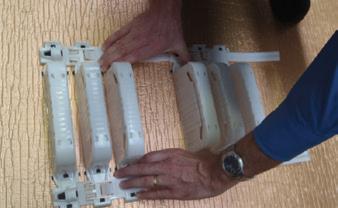


www.kwikzip.com
& restrained Spacer comprised of the same HDX 65 segment (65mm runners) Non-centered & restrained Spacer comprised of HDX 125 segments (125mm runners) above the pipe and HDX 65 segments (65mm runners) below pipe
& restrained Spacer comprised of HDX 65 segments (65mm runners) above pipe and HDX 125 segments (125mm runners) below pipe
Centered
Non-centered
Australian & International Customers +61 8 9725 4678 sales@kwikzip.com USA Customers +1 972 790 0160 usa@kwikzip.com
Utility Partner Solutions
THE UTILITY CHALLENGE: CONSOLIDATION OF ENTERPRISE APPLICATIONS



What if I told you that most Australian utility companies and utilities service providers could improve asset utilisation and maintenance, increase efficiency, and reduce risk if their enterprise systems were better integrated?
By Rob Stummer, Managing Director, IFS Australia and New Zealand
It might cross your mind that utilities and utility service providers have already invested in enterprise software. While that’s true, the structure of the industry has been a barrier to integrating systems across supply and value chains.
In IFS’s experience, utility companies that excel at asset lifecycle management and efficient service and maintenance have a significant competitive advantage.
As a result, most enterprise solutions cannot deliver the benefits of cradle to grave asset lifecycle management, for example. There’s also a question mark over whether they are modern and agile enough to fully benefit from disruptive new technologies like the Internet of Things.
If you think that sounds like bad news, think again. The good news is that the potential to improve efficiency, lower costs and reduce risk is still enormous.
STRUCTURAL BARRIERS TO INTEGRATION
Most asset-intensive industries tend to operate in an isolated or siloed manner. In utilities there is poor information exchange between business units at two levels. The first is within larger enterprises, and the second is between asset owners and service providers.
Asset owners have traditionally invested in Enterprise Asset Management (EAM) systems. Companies or business units that build or install assets, however, usually employ specialist design or bestof-breed Project Management solutions. Service companies or divisions often use standalone Workforce Management or Field Service Management (FSM) solutions.
Enterprise Resource Planning (ERP) systems are the main enterprise solution in most industries. They are often perceived as a poor fit by asset-intensive utilities, however, because they may lack a full-blown, integrated set of EAM modules. As a result, utilities often use ERP only for financials and don’t integrate it with other enterprise systems.
POTENTIAL TO IMPROVE EFFICIENCY
What we’ve mostly ended up with in utilities is a fragmented mix of software, with ERP used for financials, EAM and/ or FSM for maintenance and service, and standalone tools to manage projects. With little integration, information flows between business units or companies are usually poor. Better integration could greatly improve coordination of business processes across different areas – with huge potential to improve operational efficiency.
Connected, real-time information systems also reduce operational and financial risk. If financial or ERP systems are not integrated with operational systems they cannot share information in real time. The bottom line impact of operational decisions only becomes apparent after producing end of month reports. It’s a bit like driving a car while only looking in the rear-view mirror –definitely not recommended.
In IFS’s experience, utility companies that excel at asset lifecycle management and efficient service and maintenance
“

have a significant competitive advantage. To be successful, however, they need enterprise software capable of supporting operations and maintenance, not just financials.
With major capital projects, there also has to be a focus on the project management of the initial asset design. The integration of design and Project Management systems with ERP and EAM solutions has a massive payback. The effective handover of new assets from design to construction into operations leads to a raft of benefits. These include greater uptime and reliability, and leaner supply chain and procurement processes.
DATA-DRIVEN COLLABORATION
Service and maintenance are among utilities’ biggest costs. Any lack of transparency into standalone systems throughout the service supply chain must also be addressed. Taking all the elements into account, an integrated combination of ERP, EAM, Project Management and Enterprise Service Management (including FSM) is the ideal solution.
Enterprise solutions providing transparency and collaboration between business units or companies can over-
come the structural barriers to greater end-to-end productivity. They can provide a platform to drive industry consolidation or enable more collaborative, data-driven working models.
Utility industry executives I have spoken to say that it’s possible to deliver the right value chain if you get the right stakeholders around the table. In particular, you can create new value propositions around managing assets from the cradle to the grave. That is a real benefit for both asset owners and service suppliers.
BETTER WORKFORCE MANAGEMENT
Some of the greatest synergies can be achieved through better workforce management. Skilled resources are always in high demand, and rises in the cost of labour have driven up project, maintenance and service costs. The smart use of technology can improve labour utilisation to restore or achieve even greater levels of productivity.
With visibility into both tasks and available labour across the supply chain, you can make better use of employees and contractors. If you can see which maintenance workers are trained, compliant and available, for example, you can inject them into a project. That can speed up delivery, improve labour utilisation and offer contractors more consistent work.
Ultimately, modern enterprise technologies like Enterprise Service Management, mobility support for real-time data capture and access, and real-time business intelligence systems will revolutionise the way that utility services are provided.
Real-time data access and capture for projects or service and maintenance operations is already possible with solutions like IFS Mobile Work Order. Both employees and sub-contractors can access and update relevant information on site. Workers can use the mobile device of their choice, improving coordination, productivity and transparency.
Rob Stummer is the Managing Director, Australia and New Zealand for global enterprise applications company IFS. He has held this position for the past 8 years, continually achieving significant growth annually in both revenues and EBIT. Rob holds several degrees, including a Masters from Melbourne University. See: www.ifsworld.com/au
FUTURE TECHNOLOGY BENEFITS
In the very near future a host of new technologies – like Enterprise Operational Intelligence, 3D Printing, wearable devices and the Internet of Things – will boost efficiency even further.
At IFS, we have been developing Enterprise Operational Intelligence technology to turn a company’s “Big Data” into something useful. We can create a real-time map of the entire value chain and link it to enterprise software to monitor processes via key performance indicators to deliver on strategic goals.
Integrating new technologies with existing systems will be crucial, which means your enterprise solution must also be modern and agile enough to adapt. Implementing systems in isolation – without linking them to a big picture solution – may lead to disappointing results.
Ideally, you want all information about your assets, people, finances and projects to be in the one place – a single source of truth.
The fewer enterprise systems and databases you have, the more effectively you can analyse operations and act on business intelligence. Ideally, you want all information about your assets, people, finances and projects to be in the one place – a single source of truth. That is why IFS offers a comprehensive, modular and adaptable solution for utilities.
IFS got its start in the nuclear power industry in Sweden, and is a recognised leader in enterprise asset management for utilities globally. We’ve built a very strong base of customers in Australia, and we’re working hard to show how modern, agile enterprise systems can optimise the operations of more utility companies in the future.
For more information visit: www.IFSWORLD.com
Phone: 1300 791 200
AGILE BUSINESS
FOR
“
ABOUT THE AUTHOR
MANAGING VICTORIA’S BUSHFIRE RISK WITH SPATIAL SURVEYING

Mitigating the risk of fire associated with certain electricity assets is vital in Australia’s bushfire prone climate. However, traditional methods of surveying large electricity networks are costly and time-consuming. Recently, Geomatic Technologies completed works surveying parts of the Powercor and AusNet Services electricity networks in Victoria using an innovative method that greatly reduced the time and expenditure required.
MAPPING, GIS & SURVEYING

REDUCING THE RISK OF FIRE
The award-winning Bushfire Safety Clearance Program was undertaken by Geomatic Technologies. The program employed a combination of positioning technology, LiDAR scanning and image processing to measure conductor clearances and identify sections of the networks requiring remedial action to prevent poorly spaced conductors potentially sparking fires.
Following the Black Saturday bushfires in February 2009 and subsequent inquiry, the Victorian Bushfire Royal Commission made 67 recommendations to reduce the likelihood of a similar disaster recurring. These included a recommendation that spreaders be fitted to any electricity lines with a history of clashing or the potential to do so.
Conductor spacing is an important aspect of electricity asset management and bushfire mitigation due to the fire risk posed when lines are too close to each other, or to vegetation, the ground or other objects.
“During windy and hot conditions, conductors may sag and make contact causing ‘arcing’, which significantly increases the risk of a fire ignition,” said Mathew Croft, Business Manager (Power and Telco) at Geomatic Technologies. “Therefore, maintaining safe conductor clearances on electrical networks is important for bushfire mitigation and, ultimately, public safety.”
Following the adoption of the Royal Commission’s recommendations by the Victorian Government, Victorian electricity utilities were required to assess conductor separation throughout their networks. Recognising the need for a more efficient method of measuring powerline clearances throughout their large networks, AusNet Services and Powercor engaged Geomatic Technologies (GT) to develop a custom solution.
FINDING A BETTER WAY
The Bushfire Safety Clearance Project required the integration of multiple sensors, as well as a custom software application to process and model the conductor infrastructure to meet
the Australian distribution conductor modelling standard.
Having undertaken infrastructure clearance studies using LiDAR in the rail industry for over a decade, GT’s team was experienced in developing custom solutions to meet complex compliance requirements of this type.
Accurately and effectively measuring conductor clearances throughout the Powercor and AusNet Services networks and identifying potential clearance issues required various different data types to be collected. These comprised:
• LiDAR data (a surveying technology using pulsed laser to measure distances, also known as 3D laser scanning)
• GPS coordinates
• 3D Panoramic street-level imagery
• Inertial data (mobile survey only)
• Weather data – air temperature, wind speed, wind direction.
“The previous method of collecting this data was via a traditional survey team,” said Mr Croft. “The surveyors would normally use a total station to collect measurements at the pole and several points along the conductor. This method would normally only achieve a handful of points on each conductor and beneath each span. Using LiDAR we can generate a complete point cloud of the entire span with hundreds of measurements along each conductor.
“Due to the number of spans required to be surveyed by the regulator (Energy Safety Victoria), traditional survey methodology was not practical from cost and time perspective.”
SURVEYING EXPANSIVE NETWORKS EFFICIENTLY
Throughout the project, GT surveyed large sections of the electricity networks, requiring effective management of the survey teams to ensure the works were completed as efficiently as possible.
For instance, the AusNet Services conductor clearance survey consisted of approximately 15,000 spans, which were progressively completed in successive stages. “Each stage is broken up into general regions and
MAPPING, GIS & SURVEYING 23
then split into sites of approximately 100 contiguous spans or less,” said Mr Croft.
To efficiently survey such large spans GT employed its GT AIMS 3D (Asset Inspection Management System), which incorporates 3D panoramic imagery and LiDAR sensors, mounted on a survey vehicle.
“The mobile survey can capture many spans in fast succession – it takes as long as it does to drive along the length of the span,” said Mr Croft. “If the span is not traversable by vehicle, then the terrestrial survey method is required, where GT surveyors will use a Riegl VZ400 3D laser scanner to generate a point cloud to fill in the gaps that the mobile vehicle cannot traverse.”
GIS technology played a large role in managing the deployment of the survey teams.
“In terms of managing the two teams and the spans required to be surveyed, we heavily utilised GIS to manage the status of every required span. GT used AIMS Karta, its in-house field capture software, to manage the field teams’ progress. The mobile field crew would mark off which spans were captured and which spans would require the terrestrial survey team to visit. The terrestrial survey crew would then mark off which spans they had captured. All of this data was sent back to a server, which could be viewed from the office. Each time the field crews would sync the data the office team would get an update on which spans had been captured and which spans remained.”
PRECISION CLEARANCE MEASUREMENT
As well as this survey method being significantly quicker and cheaper than traditional methods, it also enables very precise clearance measurements, the accuracy of which were verified by AusNet Services through a separate auditing exercise.
Once the collected data was processed, special software, GT AIMS Catenary, was used to manage desktop-based data analysis, feature classification and catenary modelling.
This software integrates 3D imagery with LiDAR, conductor loading information
and weather data, and then automatically reports any clearance violations. Additionally, it also allows equipment to be mapped and asset condition to be assessed.
While the inspections were primarily focused on clearances between conductorto-conductor, conductor-to-ground and conductor-to-structure, GT also analysed conductor-to-vegetation clearances.
As the system does not rely on any existing engineering design packages, it could be tailored to the specific requirements of the application.
OVERCOMING THE CHALLENGES OF THE VICTORIAN LANDSCAPE
The Victorian landscape posed an array of different challenges that had to be overcome by the survey teams. These challenges related not only to the variable terrain and requirement for off-road driving, but also extreme hot or cold conditions, landowners, environmental concerns, logistics, livestock and wildlife.
“The mobile field team were almost constantly challenged by terrain,” said Mr Croft. “The vast majority of high bushfire risk spans are located in rural areas, which are often traversing farm paddocks. Spans cross creeks, rivers and gullies really well – 4WD vehicles don’t. AusNet Services distribution area covers a lot of hilly terrain and a lot of farmland. All field crew members were trained in correct and safe 4WD operation and vehicle recovery.
“During the warmer months the team were faced with dangerous fire conditions and were instructed to avoid driving on private property during days of severe, extreme or catastrophic fire danger days or days of total fire ban.
“Driving from farm paddock to farm paddock added an environmental complexity, where crews had to maintain vehicle cleanliness standards and ensure that mud or seeds were not transported from farm to farm,” said Mr Croft.
“The terrestrial team were often carrying survey equipment across the terrain that the mobile vehicle cannot drive on, and often involved hiking into inaccessible areas.
“Snakes, spiders, wasps, cattle and dogs were all various issues dealt with on a daily basis.”
At one stage the teams also needed to
access the Hazelwood mine, requiring them to undergo the relevant site inductions before they could gain access.
Nevertheless, despite these obstacles, the surveys were completed well ahead of schedule.
“GT has been working through the stages since November 2012 with an end goal of completing all HBRA (High Bushfire Rated Area) spans by December 2015,” said Mr Croft.
“GT successfully reached this target in September 2015.”
A NEW BENCHMARK IN CONDUCTOR SEPARATION ASSESSMENT
The success of the Bushfire Clearance Safety Program was recognised at the 2015 Victorian Spatial Excellence Awards, winning the Award for Innovation and Commercialisation.
The judges cited the innovative combination of technologies, as well as the efficiency, accuracy and cost-effectiveness of the project as the aspects which made it stand out and which “clearly establish it as an industry benchmark”. This also puts the project in the running for the Asia Pacific Spatial Excellence Awards (APSEA).
The benefits realised through GT’s custom clearance survey solution demonstrate a highly effective and efficient method of assessing condition across large networks. As a result it is likely that there will be a much larger uptake of similar solutions in the future to detect different network defects.
Mr Croft said “Electrical utilities are faced with a continual challenge of reducing cost while maintaining network safely. GT envisages being able to assist network owners to reduce the cost of inspection and assess the network by enhancing our solution to be able to complete a ‘single pass’ with several sensors to capture data that can be used to determine various network defects, where traditional methods have required several visits via manual inspection ‘on foot’.”
All in all, the Bushfire Safety Clearance Project is a successful example of utilising technological innovation in a way which not only reduces expenditure, but also contributes to better asset management and has the potential to save property and lives.
MAPPING, GIS & SURVEYING

Expand your skillset in this rapidly developing industry with a postgrad in Geographic Information Science from Curtin University. Curtin offers fully online GIS courses, giving you the flexibility to continue working while you study. Plus our courses are designed in collaboration with industry so they’re highly practical and relevant.
Find out more at spatial.curtin.edu.au
CIRCOS Provider Code 00301J/ MF CU-SE000089A Curtin University is a trademark of Curtin University of Technology
tomorrow better. Be at the forefront of a changing world. Get an online postgrad in GIS.
Make

A $5 billion infrastructure network, 20,000km of water and sewerage mains and 1.4 million customers distributed across South East Queensland: you could safely say location is at the heart of Queensland Urban Utilities’ (QUU) operations.
Driven by a commitment to operational and customer service excellence and innovation, QUU has taken its spatial capability to the next level with the development of the award-winning portal, Q-Hub.
By ingeniously combining data from a range of disparate legacy systems into a common operating picture, Q-Hub has united and focused the organisation.
From operations personnel, to field workers, to the customer service team, each QUU employee now has access to the same comprehensive, real-time view of the entire network.
QUU Chief Information Officer (CIO)
Nina Du Thaler has been central to the innovation’s development and

implementation. Over several months, Ms Du Thaler and members of her team worked with Australia’s leading Geographic Information Systems (GIS) company Esri Australia to develop Q-Hub.
Such was Q-Hub’s success, Ms Du Thaler was named iTnews’ Utilities/ Media CIO of the Year, edging out several highly-rated contemporaries to win the award, including those involved with the Telstra Air wi-fi network and a $20 million asset management system
replacement at Melbourne Water.
Rightly, Ms Du Thaler is proud of the spatial ‘awakening’ the technology has brought to Australia’s fourth largest water distributor.
“There is no doubt that Q-Hub has bound the organisation together,” Ms Du Thaler said. “Understanding location and accessing a pictorial representation of what’s happening in our business is always very powerful.
“Spatial has been part of our world since QUU’s beginning, but until
26
Utility Partner Solutions
Q-Hub’s implementation we hadn’t really harnessed its full potential to drive innovation and decision-making, particularly at an operational and customer service level.
“The power of Q-Hub lies in being able to bring together different information sources via an integration hub, to provide a single spatial representation that many areas of the organisation can view at the same time.
“Whether it’s a field worker using their tablet to view a map of the network, a control room operator coordinating the activities of a maintenance crew in the field, or our customer contact personnel delivering emergency update information; they are all able to speak the same language.”
Ms Du Thaler said significant improvements in operational efficiency and customer service are at the top of the list of Q-Hub’s successful outcomes.
“By viewing information spatially, we can draw out inferences in data and enquire in ways we were never able to using spreadsheets and tables,” Ms Du Thaler said.
“For example, Q-Hub allows staff to visualise hotspots in the network: areas where there are multiple jobs affecting multiple customers, indicating a potentially wider issue that requires further action. They can then also see where the closest and most suitable crew is – based on proximity, skill sets and equipment on board – and dispatch them efficiently.
“In some instances, our customers experience water outages when parts of the network are turned off for repairs. Previously, because we could not be certain which customers would be affected, our staff would have to doorknock the entire street or even suburb. Now our operators can use Q-Hub to trace back from the impacted asset that has been switched off and identify the exact customers that need to be notified.
“Similarly, for planned work, we can proactively contact customers and explain what needs to be done and how they’ll be affected.”
Ms Du Thaler said having information
available in real-time was crucial to Q-Hub’s success.
“In the past there could have been a 24-hour or even week-long lag between events in the field and details becoming widely accessible back in the office.
“Now this information arrives in real-time. Our contact centre has instantaneous access and can again communicate with affected customers immediately.”
Esri Australia Utilities specialist Chris Hogan said Q-Hub helped Ms Du Thaler address a core headache for many CIOs: how to ensure legacy systems don’t weigh down company growth.
“Utilities typically have a number of separate legacy systems for areas such as operations, planning and asset management,” Mr Hogan said. “For CIOs that can present problems, particularly if these systems become outdated or incompatible as the business grows.
“However, using spatial technology as an integration platform allows organisations to bypass those concerns. Rather than simply replace the systems, they can weave them into a new spatial environment. It is a different approach but a highly successful and far easier one.”
Mr Hogan said a similar approach by QUU illustrated their commitment to innovation and commercial sustainability.
“QUU is at the forefront of a shift among water utilities – away from traditional system architectures to more integrated and responsive programs backed by real-time, spatial technology.
“What QUU has done with Q-Hub is truly innovative. They have shown how the key element of location can provide a platform for staff across the enterprise to access and share information.”
Ms Du Thaler said QUU’s staff are also becoming increasingly engaged with the spatial environment.
“To extend enablement and capabilities in an organisation requires a balance of push and pull. At times, my ICT team is educating staff and promoting technologies. At other times staff are pulling us to do more,” Ms Du Thaler said.
“The exciting thing about Q-Hub is
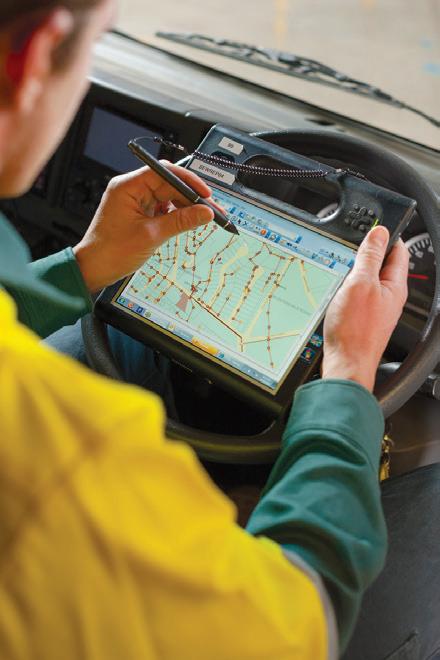
Q-HUB, DEVELOPED BY QUU IN CONJUNCTION WITH ESRI AUSTRALIA, GIVES THE UTILITY ACCESS TO A COMPREHENSIVE, REAL-TIME VIEW OF THE ENTIRE NETWORK.
that it has created an awakening within the organisation. Our staff, many of them non-traditional spatial users, can now see its value. We are getting a strong buy-in and being challenged about where to go next with spatial. Certainly 3D capabilities, both for training and identifying issues in the network, are high on the agenda.
“We also have plans of applying both historic and current spatial data in a more strategic planning forum, to see what it tells us about the way we support and maintain the network.
“So, while Q-Hub is driving better decision-making in our everyday operations today, it could also play a key role in planning new infrastructure and organising and delivering services to our customers in the future.”

27
MAPPING, GIS & SURVEYING
ACCURATE ASSET LOCATION DATA Enhancing Value and Confidence through
Knowing the precise spatial position of assets, especially those buried underground, allows utility operators to rapidly locate their assets when required, enhances planning and helps prevent costly, dangerous and all-toocommon incidents of accidental asset strikes.
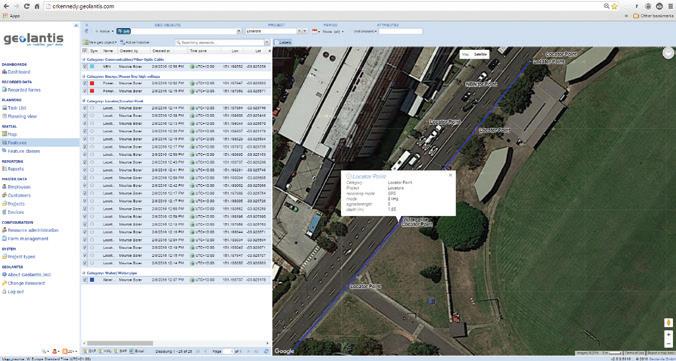
The location data stored in a utility’s GIS is vital for asset management, public and workplace safety, emergency planning and response, and for maintenance activities to be undertaken efficiently and effectively.
This article presents an integrated solution, featuring handheld hardware devices capable of accurately determining the location and depth of buried utility assets, and powered by a smart mobile and cloud-based GIS, which enables an almost fully automated workflow from field to office.
UNLOCKING THE POTENTIAL OF GIS
Geographic Information Systems (GIS) are invaluable to modern utility companies. Among other things, GIS enables operators to effectively manage assets throughout their large, complex infrastructure networks so that they can continue to provide vital services to the public.
Yet to fully unlock the functional possibilities of a GIS, the spatial data detailing the location and nature of assets must be spatially accurate,
reliable and comprehensive.
Additionally, asset owners face significant challenges associated with assets that were constructed decades ago, where location data was never recorded, or was recorded inaccurately. This lack of data contributes to utilities having to spend millions of dollars each year to repair assets that are damaged through accidental excavation. This often occurs where high power or pressure assets are involved. The consequences of accidental excavation is much more than monetary costs, but lost lives as well.
Considering its importance, traditional methods of acquiring accurate asset location data are challenging, time consuming and open to error. It requires data to be handled and transcribed multiple times before being incorporated into the GIS, which creates the potential for human error.
C. R. Kennedy, SmartNet Aus and Geolantis, three leading companies in the geospatial industry, have joined forces to provide a comprehensive solution for locating both above and below-ground assets with centimetre accuracy.

AN IDEAL INTEGRATED SOLUTION
The traditional workflow of asset location typically involves the field crew using utility service locators to detect underground utilities, then marking the location with spray paint and recording (often on paper) measurements such as frequency, signal strength and depth. In a separate process, a surveyor is required to accurately survey the point location. Later, the two sets of data are combined in the office and added to the asset owner’s GIS.
The solution presented by C. R. Kennedy, SmartNet Aus and Geolantis integrates the process and simultaneously captures all data digitally. This combined solution is highly accurate, data rich and provides a streamlined workflow that is substantially quicker, less costly and, most importantly, it avoids many of the opportunities for error inherent in the traditional methodology.
A REVOLUTIONISED WORKFLOW
The centrepiece of the solution is the mobile data collection platform. The Leica
Utility Partner Solutions MAPPING, GIS & SURVEYING 28
INSTANT MAPPING AND VISUALISATION OF UTILITY SURVEY.

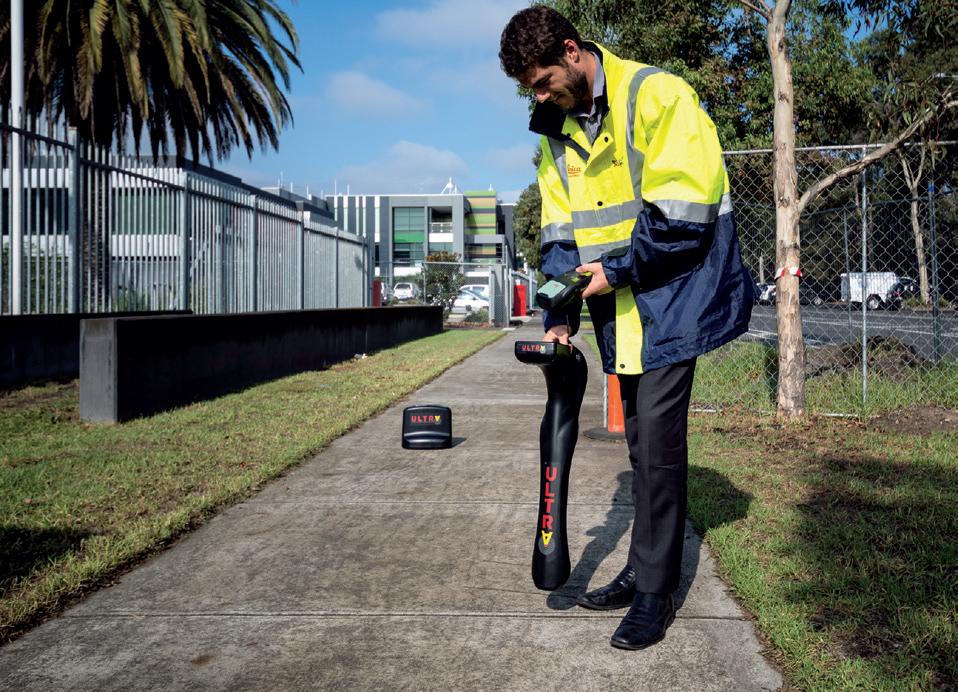









































Zeno 20 GNSS/GIS handheld device is an extremely accurate and intuitive data collector, which enables field users to navigate to assets easily. Its additional benefits include the ability to record various attributes about infrastructure, including technical, maintenance and condition details for each asset in customisable forms, and easy importing and exporting of shape files for processing in ArcGIS or other GIS/CAD programs.
In this integrated solution, the Zeno 20 hardware platform is powered by the cloud-based GIS software suite from European software house Geolantis GmbH. This provides a streamlined data flow, from full digital data capture in the field when an asset is located, to instant upload and display of the data in a cloudbased mapping and data management system.
Running the handheld GNSS mobile device with Geolantis’s powerful mobile application provides accurate locations against the backdrop of customer uploaded utility maps, design data, OpenStreetMap or satellite imagery, all of which provide the field operator with helpful guidance. Existing utility information can also be queried interactively via the map display to determine an underground asset’s characteristics.
Critical to the solution are the GNSS real-time kinematic (RTK) corrections provided by SmartNet Aus’ comprehensive Continuously Operating Reference Station (CORS) network, which addresses errors inherent to all GNSS satellites and thus enables centimetre accurate positioning in real-time. The SmartNet Aus base stations receive positioning signals from GPS/

GNSS satellites to calculate extremely accurate RTK corrections (down to +/- 2 centimetres) and broadcast them to GPS/ GNSS receivers.
After navigating to the recorded location of the asset, the next step involves determining and confirming the position of buried infrastructure using a subsurface service locator. The solution described supports Leica’s series of locators, including the Digicat 650i and the industry leading ULTRA model and other brands. The 650i is the ideal tool to confirm the existence of underground utility assets, while the ULTRA will enable accurate detection of both the location and depth of the assets.
Measurements from the locator are then automatically transmitted to the Zeno 20 via Bluetooth, enabling the asset information to be integrated with the GPS position and GIS feature details. The GPS position and GIS feature details are then instantly mapped on the mobile application as well as on the GIS mapping portal.
Information sharing across an organisation and beyond becomes a seamless process. The mobile software operates in online as well as offline mode and the synchronisation occurs in the background without any interruptions to the field work.
The easy-to-use online portal provided by Geolantis allows all aspects of documenting utility location tasks to be effectively managed, including personnel and equipment resource planning. The user can switch between street view, satellite imagery and cartographic street maps. Field acquired survey data is instantly available and can be accessed

by users anytime and anywhere. For areas where GPS reception is problematic or where assets are inaccessible, the Leica S910 laser distance meter can be paired with the Zeno 20 handheld GNSS device. Once combined, the platform is transformed into a remote point measurement solution, known as gamtec. This package turns the Zeno 20 into something akin to a traditional Total Station that records GIS data.
THE ADDITIONAL BENEFITS OF GOOD DATA
In addition to the previously mentioned benefits, collecting data that is comprehensive, GIS ready and as accurate as possible, also ensures usability and interoperability with other, new and future technologies. As regulations continue to tighten, ongoing adoption of best practices helps an organisation stay ahead of the curve and maintain a strong foundation for the future.
For instance, technology that allows workers in the field to visualise the positions of buried assets in 3D in an augmented reality environment is already available, and is just one of many innovations that rely on location data.
An integrated spatial data capture process, such as that provided by C. R. Kennedy, SmartNet Aus and Geolantis, can greatly improve confidence in the accuracy and completeness of spatial data. This provides a wide range of benefits, from mitigating the risks of accidental excavation, to enhancing asset management, empowering planning and preparing an organisation to take full advantage of technological innovation.
Enhancing value and confidence through accurate asset location data MAPPING, GIS & SURVEYING 30
A WELL DEFINED WORKFLOW UNDERPINS THE APPLICATION IN THE FIELD AND OFFICE.
Aqua-Assets Pty Limited
Aqua-Assets Pty Limited
Sydney: (02) 9708 0800
Newcastle: (02) 4940 0410
Email: enquiries@aquaassets.com.au www.aquaassets.com.au


Industrial Cleaning Solutions
Environmental Solutions
Emergency Response
Waste Management
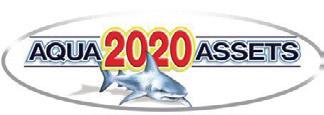

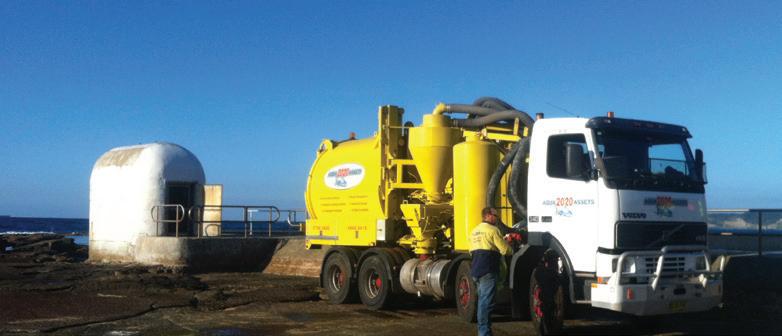

• INDUSTRIAL VACUUM LOADING
• 40,000psi ULTRA HIGH PRESSURE WATER BLASTING
• COLD CUTTING & TUBE BUNDLE CLEANING
• HIGH PRESSURE WATER BLASTING
• COMBINATION – VACUUM/WATERJET
• NON-DESTRUCTIVE DIGGING
• WATERBLASTING & HYDRO DEMOLITION
• CCTV PIPELINE INSPECTION
• TRENCHLESS TECHNOLOGY
• PATCH LINING, PIPE CRACKING, CIVIL, HYDROGEN SULPHIDE, PIPELINE GAS ATTACK CONTROL







Asset Training is a Division of Aqua Assets
RTO Code: 91255
RTO Code: 91255
Email: info@assettraining.com.au
www.assettraining.com.au
HIGH PRESSURE WATER JET
• HIGH PRESSURE WATER JET OPERATOR (MSAPMWJ301A, MEM09002B, MSAPMOHS200A, MSAPMER200C, MSAPMOHS110A)
MSAPMOHS110A)
HIGH PRESSURE WATER JET ASSISTANT
• HIGH PRESSURE WATER JET ASSISTANT (MSAPMWJ201A, MSAPMOHS200A, MSAPMER200C, MSAPMOHS110A)
• CONFINED SPACE ENTRY (1 & 2 days) (RIIWHS201D, RIIWHS202D, MSAPMOHS216A, MSAPMOHS217A, MSAPMOHS200A, MSAPMPER205C)
• CONFINED SPACE REFRESHER
• CONFINED SPACE REFRESHER
• WHITE CARD General Construction Induction (CPCCOHS1001A)
• FIRST AID (HLTAID001, HLTAID002, HLTAID003)
• FIRST AID
• CPR (HLTAID001)
• WORKING SAFELY AT HEIGHTS (RIIWHS204D, RIIWHS201D)

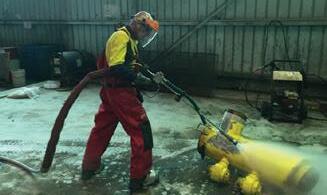








and proud partner, Aqua Assets Pty Limited, have secured an Australian Master Agreement with Boydel Technologies for their patented Electrocoagulation / Electro Advanced Oxidisation reactor range. This technology removes the need for costly chemical, biological and mechanical pre-treatment technologies providing a single pass coagulation process to all conductive elements whilst disinfecting to 99%+ through the Fenton’s development zone of the single reactor. This technology coupled with Carbon Filtration and Reverse Osmosis will provide a fully scalable continuous flow treatment from raw sewerage to drinking water in 12 minutes.
Inovin
Plotting a path TO DIGITAL SUCCESS
by Kevin Hutchings, Managing Director, South East Water

The water industry has many individual examples of digital technologies delivering more sustainable, cost-effective and flexible water solutions for customers, but its overall adoption of emerging technologies could be greater. Engagement, collaboration and a bold mindset are essential if the water industry is to take full advantage of the next wave of opportunity technology is creating.
SMART METERS

SMART METERS 33
f we had the technology to deliver more flexibility and cost savings to water customers, increased asset utilisation for water authorities, and a reduced impact on the environment, we’d jump on it, right?
I’d like to think so. But despite the advances we’ve made in communications, battery technology and analytics, the water industry’s adoption of emerging technologies could be greater. Today I want to call out the technologies that are already unlocking value across the water supply chain, and identify the key ingredients for their successful, industry-wide adoption.
The fact is, we already have technology embedded in our networks that is producing huge volumes of data across a range of indicators, including water quality, pressure, and wastewater flows. However, we are only just beginning to harness the value of this data.
Technology isn’t the only driver of change – customer expectations, government policy and regulation, competition and economic climate all have a major influence – but we mustn’t lose sight of the opportunities before us.
When Sir Joseph William Bazalgette convinced authorities in 19th century London that a gravity sewer system was the only way to tackle the capital’s ‘Great Stink’, he established the design standard for urban sewer systems that is still upheld today.
Gravity has served us well, but technology now exists that can completely transform the way we manage wastewater, with benefits across the board. Let me give you an example.
South East Water is currently connecting 16,500 homes on the Mornington Peninsula with a pressure sewer system. At each property, the septic tank is replaced with an 850-litre storage tank and pump, which discharges into a pressured sewer network.
The system is built around an intelligent, SCADA-connected system

designed by South East Water called OneBox, in which each property’s sewer connection is remotely managed on a real-time basis, depending on a range of local and network factors.
The benefits to South East Water as the asset owner are huge. Because we can regulate flows of waste into the network, we can remove diurnal peaks and reduce the size of the infrastructure needed to transport and process the wastewater. For example, the reticulated network is made up of pipes with an internal diameter of just 63mm. Without the need for trenches and manholes, construction costs are slashed, and occupational health and safety risks involved in system maintenance are dramatically reduced.
What’s more, we’re able to monitor for illegal connections, inappropriate waste disposal, and water leaks such as leaking toilet cisterns. And that’s where the customer really benefits.
Last month our operations team picked up a continuously running wastewater pump at a customer property, a holiday home. Real-time data from the pump, which was transmitted back to South East Water on a second-by-second basis, suggested a water leak on the property, and we were able to notify the owners before damage occurred, and without significant impact on the water bill.
The environmental benefits have been significant also. The pressure sewer scheme’s smaller specifications
enabled the use of horizontal directional drilling (HDD) during installation, which minimised surface disturbance in what is recognised as an environmentally sensitive area. In addition, the low pressure network design reduced the number of power hungry and expensive transfer main pumping stations from seven to two.
The benefits are clear and wideranging, but how do we extend technology such as this more broadly across our industry, so that more customers can benefit?
To make progress, I believe there are three critical success factors: community engagement, collaboration, and a bold mindset.
Within our industry, many of us have long recognised the benefits in digitising and automating our water networks, but what of our customers and other stakeholders? Where do their interests lie? How can technology help to meet their needs? And how can we engage with them to demonstrate the value of digitising the network?
A key element in South East Water’s customer assistance program is the water audit, in which we supply customers experiencing financial stress with a handheld device that enables them to monitor water usage in real-time and receive alerts when daily water usage targets are reached.
Over summer, an elderly couple in Melbourne’s south east successfully used the device to make a number of behaviour changes, such as shorter showers, less hose-watering and fewer washing loads. The result was a reduction of $900 from their annual water bill and unsurprisingly, the couple are reluctant to return the device to South East Water. How many others would jump at the same opportunity to better manage water usage?
Planners and policymakers also have much to gain through network digitisation. By digitising our networks, we can make better decisions, more quickly, about how water is managed across a population.
Again, a real-world example. Together with Yarra Valley Water and City West
I
SMART METERS 34
a path to digital success
KEVIN HUTCHINGS.
Plotting
Water, South East Water currently has an end-use study underway across a variety of residential accommodation types, ranging from inner-city apartments to dual-pipe houses in the suburbs. The difference with this study is that data loggers have been replaced with digital meters, which provide an unprecedented view into water usage at the appliance and household level.
The high-resolution data will help water authorities to plan like never before for future water demand, and to make more informed decisions about infrastructure sizing, and how to invest in long-term water security. It’s a vital capability as we enter a period of increased climate uncertainty.
The end-use study also highlights a second critical ingredient in the successful adoption of new technologies – collaboration. Industry-changing technology initiatives need industry collaboration if they are to succeed. Few organisations have the knowledge
and expertise to go it alone. We need to work as an industry, whether engaging policymakers on legislation, or suppliers on product design. Quite apart from the adage that two heads are better than one in solving a problem, it comes down to dollars. Work together, and we can maximise the economies of scale.
Collaboration has a second dividend: it creates momentum. By working with industry peers, government and suppliers, Australia can build a worldleading capability in digital water utility transformation. An ecosystem where skills in design and implementation can flourish, and where partnerships across the supply chain can deliver proven technologies and processes from which other markets around the world can benefit.
It’s a grand aspiration, which leads me to my final ingredient – boldness. Developing new solutions will inevitably involve overcoming major challenges along the way.
For example, we need to keep working on a solution to the problem of how to power digital water meters without the need for regular battery replacement. And there’s more we can do to deliver real-time water usage information through the high-quality mobile app experience our customers expect.
The challenges aren’t just technical either. The explosion in data that digitised networks generate require skills that most utilities haven’t accounted for. Data integration and analytics, systems integration and telecommunications are just a few – there will be others we may not have even thought of yet.
Provided we take a bold approach, step up our collaboration, and continue to engage with customers to ensure we are focused on meeting their needs, our industry can transform at a pace like never before.
I’m confident of that, and we look forward to playing a big part in it.

SMART METERS 35 · Industrial UAV inspections, structural/mechanical · Surveying and Digital Elevation Modelling · Infrared Thermography · Construction progress monitoring & reporting · Dilapidation reports · Full engineering support – mechanical, structural, asset management, certified thermographers info@veloxaviation.com.au www.veloxaviation.com.au Tel: 1300 135 542 Supported by www.veloxengineering.com.au
METERING SMARTER Making
Smart meters have the potential to provide a wide range of benefits to both electricity utilities and consumers, including empowering end users with the information to engage more actively with their energy consumption, and enabling innovative demand management initiatives and cost-reflective pricing options. However, in recent years, how best to deploy smart meters across Australia and encourage consumer uptake of their functions have been contentious issues. In light of this, the Australian Energy Market Commission (AEMC) has implemented rule changes aiming to spur a market-led smart meter rollout by opening up competition in the metering market. In this article, we investigate the implications of this ruling and examine the current state of smart metering around Australia.

In 2012, the AEMC’s Power of Choice review presented a range of recommendations to state and federal governments aimed at enabling the National Energy Market (NEM) to meet consumer needs over the next 15-20 years and provide consumers with a wider range of options in regards to their energy use. These recommendations included measures to expand competition in metering and related services, in order to spur smart meter uptake and encourage competitive metering suppliers to
provide services at an efficient cost and consistent with consumer preferences.
In response to the review’s recommendations, the Council of Australian Governments’ (COAG) Energy Council proposed a number of changes to the National Electricity Rules.
After extensive industry consultation and consideration, the AEMC released its final rule determination, which will see significant changes to the metering market apply from 1 December 2017.
WHY THE CHANGES?
Smart meters, or advanced metering infrastructure, are a key enabling technology for smarter electricity networks.
Depending on the functionality of the meter, the ability to send and receive data remotely enables data on electricity consumption, electricity outages and other information on the performance of the distribution network to be obtained almost instantaneously. A variety of services such as remote meter reading, remote
SMART METERS 36
access to appliances and cost-reflective pricing options also require smart meters.
Advanced metering can empower consumers with the information they need to monitor, manage and adjust their electricity consumption in a way that better meets their usage and price preferences. Furthermore, a wider uptake of smart meters and related energy products and services can enable measures to facilitate more efficient operation of the network.
For instance, demand management initiatives can be instrumental in enabling network providers to defer building costly extra infrastructure purely to cope with peak demand periods, meaning they do not need to pass on these costs to consumers.
However, despite the benefits of advanced metering, only a relatively small number of advanced meters for small electricity customers have been deployed outside of Victoria, where a smart meter rollout was mandated.
According to the AEMC, the current National Electricity Rules contribute to discouraging smart meter deployment by allowing and potentially encouraging the continued installation of outdated accumulation meters instead.
This inhibits innovation in the NEM and means that many consumers and utilities are missing out on the benefits smart meters can provide.
The rule changes intend to combat some of the obstacles preventing smart meters from being deployed more widely, and facilitate a competitive market-led rollout.
MAKING METERING MORE COMPETITIVE
The AEMC’s final ‘Expanding competition in metering and related services’ rule changes provide a new competitive framework for metering services, designed to promote innovation and investment in advanced meters that deliver valuable services to consumers.
Once the new arrangements come into effect on 1 December 2017, any suitably qualified party will be able
compete to provide metering services to retailers, subject to registration requirements. Previously, only retailers and distribution network service providers (DNSPs) could do this for small customers.
Metering services covered include making sure a customer has a working meter and providing the necessary parties with metering data for billing. The rules also set out the minimum capabilities a new or replacement meter must provide.
In order to meet the minimum services specification, a meter must be capable of:
• Remote disconnection
• Remote reconnection
• Remote on-demand meter reading
• Remote scheduled meter reading
• Meter installation inquiry
• Advanced meter reconfiguration.
The meter must also be connected to a telecommunications network that enables remote access to the meter.
Additionally, the rule facilitates the commercial provision of services enabled by advanced meters, such as access to voltage and other data in real-time, to distribution businesses and third parties, while putting in place safeguards to protect consumers from unauthorised access to their metering data and services provided by their meter.
Under this market-led approach, advanced meters will be deployed where new and replacement meters are required, or where energy businesses and consumers want access to advanced metering services. However, the rule also provides certain provisions for consumers to opt out of having an existing working meter replaced with an advanced meter.
Key features of the new rule include:
• The final rule changes who has overall responsibility for metering services under the NER to promote competition in the provision of metering and related services by:
• Transferring the role and responsibilities of the existing ‘Responsible Person’ to be
provided by a new type of Registered Participant – a ‘Metering Coordinator’
• Allowing any person to become a Metering Coordinator, subject to meeting the specific requirements
• Permitting large customers and non-market and exempt generators to appoint their own Metering Coordinator at distribution connection points
• Requiring a retailer to appoint the Metering Coordinator, unless another party has appointed its own Metering Coordinator.
• It requires a Metering Coordinator to take on roles additional to those currently performed by the Responsible Person so that the security of, and access to, advanced meters and the services provided by those meters are appropriately managed.
• It specifies the minimum services that a new or replacement meter installed at a small customer’s premises must be capable of providing.
• It provides for the circumstances in which small customers may opt out of having a new meter installed at their premises.
• It clarifies the entitlement of parties to access energy data and metering data in order to reflect the changes to roles and responsibilities of parties providing metering services.
• It provides for DNSPs to continue to get the benefit of network devices installed at customers’ premises that allow them to monitor, operate or control their networks for the purpose of providing network services, provided there is sufficient space to house both the metering installation and the network device.
• It permits a retailer to arrange for a Metering Coordinator to
SMART METERS 37
remotely disconnect or reconnect a small customer’s premises in specified circumstances.
• It permits a retailer to arrange for a supply interruption at its customers’ premises for the purposes of installing, maintaining, repairing or replacing an electricity meter.
THE STATE OF PLAY FOR SMART METERS AROUND AUSTRALIA
In light of the impending changes and their hopeful implications, it is worth investigating the current state of smart meters around Australia.
While Victoria mandated a full-scale rollout of smart meters, which is now complete with around 2.8 million meters in place, their deployment resulted in substantial controversy and consumer backlash. Among other things, this was caused by the itemisation of metering costs to consumers and a lack of effective consumer engagement, meaning consumers were unaware of the potential benefits offered by
smart meters.
Partly as a result of the Victorian experience, the process of rolling out smart meters in other states has been gradual, as utilities and state governments seek to avoid similar issues, combat public distrust and misinformation, and increase the awareness of consumers to the benefits of the technology.
Nevertheless, a number of network providers and state governments across Australia have been undertaking smart meter trials and deploying advanced meters to some customers on their networks.
The NSW Government recently passed the Electricity Supply Amendment (Advanced Meters) Bill 2016, which supports a voluntary, market-led rollout of advanced meters in NSW. This legislation also includes provisions to support the market transition to a competitive metering framework and support the new national metering arrangements provided by the AEMC rule change.
Civil Infrastructure Solutions


According to NSW Minister for Industry, Resources and Energy, Anthony Roberts, around 40,000 smart meters have already been installed in NSW. The new policy will help that number grow, by enabling competition and increasing the pool of available meter installers from 2,000 to potentially around 35,000 qualified electricians.
The market-led rollout of smart meters is also intended to help more than 130,000 Solar Bonus Scheme customers transition to a more appropriate tariff arrangement with their retailer when the scheme closes at the end of 2016.
So far, a number of providers in the state have been undertaking programs to increase the number of smart meters in their networks. For instance, Origin Energy intends to begin an expanded rollout of smart meters in the coming months and AGL is currently rolling out advanced meters, accompanied by a smartphone app enabling customers to easily view and engage with their energy use, in NSW,



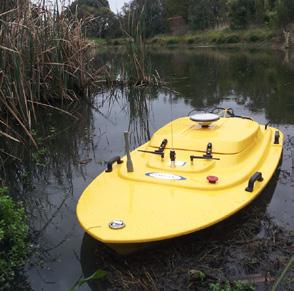
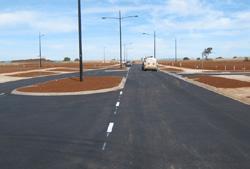
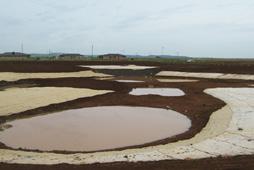
SMART METERS 38
With a wealth of experience in the design of civil infrastructure, Taylors offers solutions focused urban development consulting and project management, from project inception to design, approvals, construction and delivery.
taylorsds.com.au At the forefront of ‘big data’ technology, Taylors can deliver fast, accurate and cost effective customised solutions for a broad range of projects and market sectors including water and sewer, waste management, local government, transport (road and rail), pipeline, resources and telecommunications.
Technology Hydrographic Technology Terrestrial Scanning INFRASTRUCTURE Vehicle Mounted LIDAR Drone-Tech Mapping Stakeholder Consultation Design of Roads & Reticulation Feasibility and Servicing Strategy Contract Administration ENGINEERING & PROJECT MANAGEMENT
Taylors offer a unique integrated and seamless approach to consulting across four core businesses in Urban Development, Built Environments, Infrastructure and Engineering and Project Management.
Innovative Spatial
South Australia and Queensland.
Additionally, Ausgrid has around 24,000 smart meters installed across its network from various metering trials, although not all currently have remote communications enabled. Endeavour Energy has around 10,000 in place, mostly as part of trials.
In Queensland, Ergon Energy successfully completed a trial of advanced, two-way communication equipped Paywave powercardoperated meters in remote Indigenous communities in Wujal Wujal and Hammond Island.
Energex will begin a real-time tariff study in July 2016 to gain a greater understanding of the effects of different tariff arrangements enabled by advanced meters. The company aims to recruit a minimum of 400 residential customers on a voluntary basis in the first year of the study and to begin incorporating small business customers into the cohort from July 2017.
Meanwhile, in WA, Horizon Power has been provided with State Government funding to replace existing meters with advanced meters at all customers’ premises in 2015 and 2016, at no cost to consumers.
This rollout is considered particularly beneficial, due to the remote nature of many of the communities covered by the Horizon Power network, and the resulting high costs of sending personnel out to read meters or inspect infrastructure.
Western Power is also undertaking advanced meter trial programs, involving 9,000 smart meters installed at selected properties in the Eastern Metropolitan Region and 2,300 in Denmark and Walpole.
fleet is currently advanced-capable.
Other network providers across Australia are also undertaking various smart meter and/or demand management trials and investigations on different scales, and many install smart meters as replacement meters, for larger customers, or for smaller customers who request them.
THE NEXT STEPS ON THE ROAD TO REFORM
With the new rules opening up
competition in metering from December 2017, and NSW taking initiative with a market-led smart meter rollout, the tide may finally be turning for advanced metering in Australia.
Hopefully, in the coming years we will see increased uptake of advanced metering infrastructure and acceptance of smart meters by Australian consumers, paving the way for smarter, more responsive electricity networks throughout Australia.
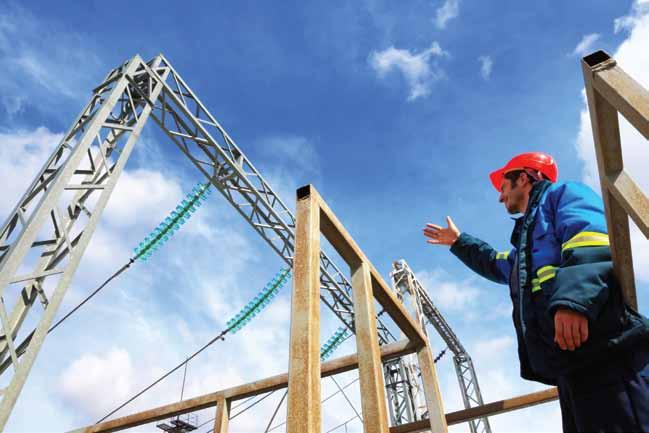
In the Northern Territory, Power and Water is replacing the meters used for pre-pay customers, mostly in remote communities, with more advanced meters. The replacement program will run until 2018.
TasNetworks is planning a voluntary demand-based network tariff trial involving smart metering, in order to gain insight into how the technology can best be applied to the Tasmanian electricity network and analyse customer impact. According to the company, approximately 20 per cent of the TasNetworks metering




LINEAR DEVELOPMENT SOLUTIONS
Civil pipeline inspection & supervision Third Party works management
Land access management & negotiation including:
• Compulsory acquisition services for rail, road & electricity easements
• Compensation & damages estimates associated with construction works
• Farm & bio security planning for properties affected by construction

Flexible staffing solutions infield

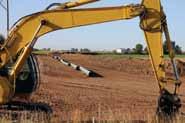
SMART METERS
CALL 1300 INFIELD (1300 463 435) www.infieldimpact.com
COMMITTED TO DELIVERING RESULTS WITH STRONG STAKEHOLDER ENGAGEMENT
39
HOW THE CLOUD IS HELPING UTILITIES COPE WITH THE SMART METER DATA DELUGE
By Mike Ballard, Senior Director Utilities Strategy, Oracle
Around the world utility companies are being buffeted by strong winds of change. Shifting customer demands, fresh competition and new government policies and regulation mean business-as-usual strategies no longer work.
Sitting at the centre of these changes is the smart meter. Being rolled out in increasing numbers, these devices have the capacity to alter both the way in which utilities operate and the nature of their relationships with customers. According to industry estimates, more than 600 million smart meters have already been installed around the world.
In addition to these global trends, in Australia, moves are being made to deregulate metering, potentially allowing the entry of a range of new players in the market. This is likely to hasten future smart meter rollouts.
A CHANGING APPROACH TO METERING
Where traditional meters delivered little more than a record of power consumed by a home or business, smart meters are able to provide a whole lot more. Consumption can be monitored on a real-time basis and differential pricing used for different times of day.
When this is combined with the increasing adoption of renewable
generation, utilities now have the technologies to monitor and control generation and distribution at a much more granular level. Demand can be accurately assessed and capacities scaled up and down much more quickly.
Smart meters can also provide data on other connected devices. There might be solar cells generating power on the roof and a storage battery in the basement. Each such device produces data that can be collected and used by the meter provider, the retailer and of course the customer.
DATA DELUGE
However, a challenge arises because many utilities are still working with first generation Meter Data Management (MDM) systems not designed to cope with new-generation smart meters. Designed only to collect basic consumption data and provide it to a centralised billing system, they simply can’t cope with the demands of new smart meters and the demands utilities have of their MDM systems.
Utilities need to understand that, when they start to roll out smart
meters across their networks, both the volume and types of data generated will increase. This is due to the fact that a typical smart meter creates a variety of different data points and can do it as frequently as every 15 seconds.
Data collected includes everything from consumption over time to the quality of received power. Using the combination of consumption and power quality, smart meters can inform a utility company of any potential problems in their distribution network by analysing voltage being received and any fluctuations that occur. This capability becomes more important as variable generation equipment is increasingly installed on the low voltage network.
Note that data volumes from smart meters do not increase in a linear fashion but grow exponentially. Traditional MDM systems were never designed to cope with these kinds of volumes.
Utilities need to find a way to cost-effectively deal with this data, which arrives in large quantities and in a variety of formats. They need to be able to efficiently collect it, cleanse it and analyse it to extract real business
SMART METERS 40 Utility Partner Solutions
Utilities need to find a way to cost-effectively deal with this data, which arrives in large quantities and in a variety of formats. They need to be able to efficiently collect it, cleanse it and analyse it to extract real business value. There needs to be business rules in place that can deal with everything from billing based on time-of-day consumption, net metering as well as all of the distribution use cases too.
value. There needs to be business rules in place that can deal with everything from billing based on time-of-day consumption, net metering as well as all of the distribution use cases too.
Utility companies also need to be able to manage the smart meters themselves. Essentially small computers, smart meters need to have firmware and security updates which must be carried out in a regular fashion. These kinds of requirements were never considered when using the old meters or first generation MDM systems.
The bottom line is that utility companies need a metering platform that can scale and be flexible enough to cope with the changes that are happening across the sector. Without this, they will be unable to continue to operate effectively and provide the levels of service that customers are coming to expect.
THE CLOUD
However, making significant investments in back-end IT infrastructure that is capable of dealing with these high data volumes and extracting business value is not always financially viable for utilities. This is especially the case when utilities have already piled significant capital into their smart meter programs. However, there is another alternative.
Cloud-based platforms offer the ability to take advantage of the infrastructure needed to handle high volumes of data without the
requirement for sizeable up-front expense. All data received from smart meters can be stored, backed up, and analysed without the need for any direct investment in physical infrastructure.
A cloud-based infrastructure can also be readily scaled. If a utility rolls out another 100,000 smart meters, processing capacity is immediately available as storage and processing resources are consumed as a service. The utility only pays for what is used.
However, despite the significant benefits offered by a cloud platform, some utilities are still reluctant to make the move. They are hesitant to make the change from housing their smart meter data and processing to in-house servers to an external cloud-based platform.
One reason cited for this reluctance is that they fear they will lose the ability to use the data in other systems. They believe that, once it leaves the traditional data centre, it will be difficult to recapture.
Reality is somewhat different. Some cloud providers are offering services that allow metering solutions to be portable from on-premise to cloud and back again if needed. They also recognise that an MDM systems in the cloud is only viable if they can ensure that the data is easily uploaded, processed and most importantly delivered back to the utility’s downstream business systems.
In this way, organisations can evolve
their data architectures to extract and leverage value from their existing IT and ‘data assets’ as well as exploit the latest capabilities from market leading MDM systems investments.
A cloud-based system also offers benefits to utilities keen to ‘try before they buy’. They typically have the option of undertaking a pilot program, taking data collected from smart meters and performing analysis to determine its worth. In this scenario, no up-front capital investment is required as the utility can simply rent some capacity from the cloud provider.
If the pilot program is deemed a success, the cloud-based metering approach can be quickly scaled to cover the entire operation.
By using a cloud-based infrastructure to support their smart metering projects, utilities no longer need to be concerned about the cost and complexity of setting up traditional back-end systems to support these projects. They are free to focus on the data that is being generated and on finding ways to derive business benefit from it.
As the electricity market becomes more complex and competitive, those utility companies that flourish will be the ones that can use data collected by smart meters to have a better picture of their customers and their changing demand patterns. A cloud-based processing platform can help them achieve this aim.
SMART METERS 41
SMART METERS IN AUSTRALIA Setting the agenda for
THE
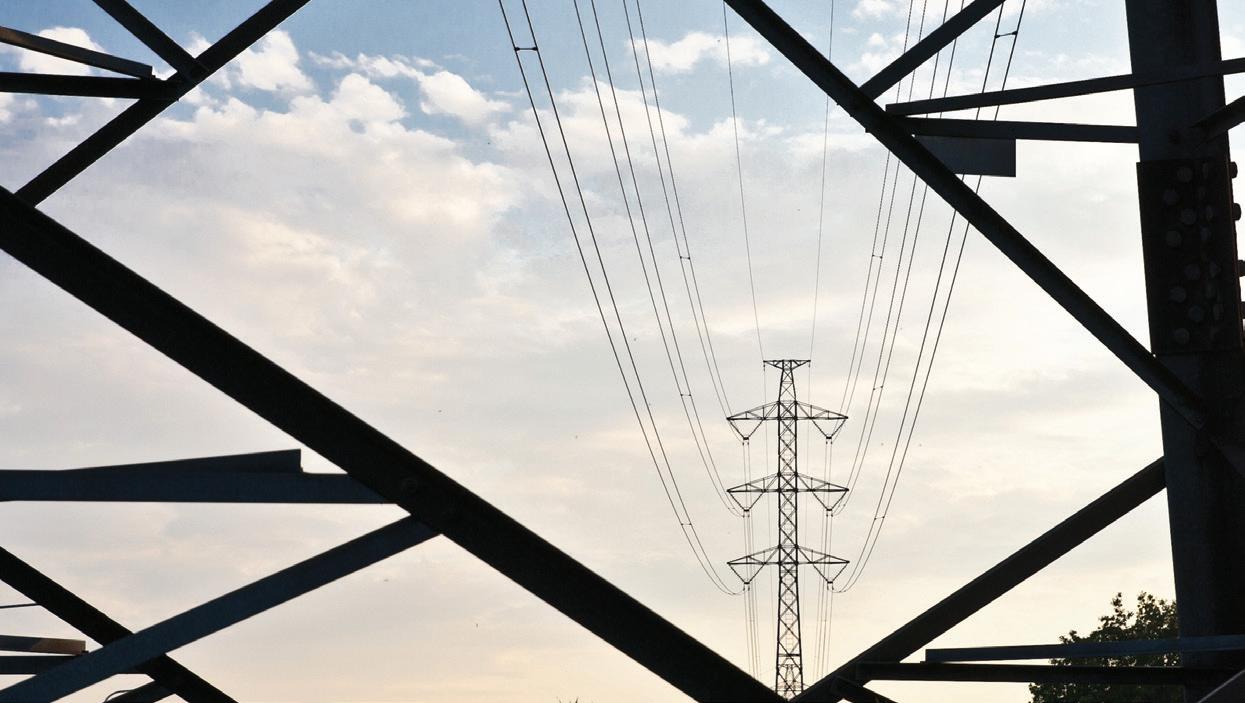
When industries and sectors evolve, very often a new set of rules and standards for products and services can be required. In these instances, there can be a number of pathways available to industry, including the implementation of national regulation, the development of industry codes of practice, or the development of Australian Standards.
The energy supply sector has experienced many recent changes. Some of these include the development of the Minimum Functionality and Shared Protocol (MFSP) by the Australian Energy Market Operator (AEMO) and the Power of Choice Review undertaken by the Australian Energy Market Commission (AEMC).
In response, stakeholders turned to Standards Australia to ensure that Australian Standards for Metering Equipment were contemporary and relevant.
Standards Australia leads and promotes a respected and unbiased standards development process ensuring all competing interests are heard, their points of view considered and consensus reached. Under this model of standards development, Australian stakeholders
came together at the Standards Australia offices in March to set a clear path towards safer, more efficient and marketready smart meters at the first forum of Standards Australia’s Roadmap for Advanced Metering Standards.
The forum participants considered the key standards-related issues during a discussion moderated by Standards Australia regarding the rollout of smart meters, and agreed to focus their activities on four work streams:
• Safety
• General requirements, tariff and load control
• Accuracy and protocol
• Acceptance and dependability.
The focused work on safety will be undertaken by a committee comprised of balanced representation from government, industry and consumers.
The committee will commence work on the modified adoption of IEC 62053.31
Electricity metering equipment (AC) –General requirements, tests and test conditions – Part 31: Product safety requirements and tests. This will involve the consideration of unique Australian conditions that may require modification to the International Standard to ensure its suitability in Australia.
The Australian public and all stakeholders will have an opportunity to share their views on any proposed modifications to IEC 62053.31 during the public comment stage. This stage ensures that the wider community has an opportunity to review the content and direction of the standard prior to its completion.
Research and investigative work relating to the modified adoption of IEC 62053.31
42
SMART METERS
UNDER
STANDARDS AUSTRALIA ROADMAP, INDUSTRY STAKEHOLDERS ARE SETTING THE AGENDA FOR SMART METERING STANDARDS.
will be undertaken by relevant technical experts in the other three work streams hosted by Standards Australia.
Ultimately, stakeholders are sitting in a pivotal position. Through Standards Australia’s Roadmap process and participation in the work streams, they will assess the usefulness of existing Australian Standards, consider the International Standards developed by the IEC’s Technical Committee for Metering Equipment (IEC TC 13), and develop a clear pathway towards a comprehensive infrastructure for metering equipment standards in Australia.
The first forum in the Roadmap kicked off with presentations delivered by guest speakers Roy Kaplan of the Australian Energy Market Operator and Neil Fraser of the Electrical Regulatory Authorities Council. The two presenters set the context for the Roadmap, explaining the necessity for contemporary and relevant Australian Standards for Metering Equipment.
The forum also heard from industry representatives, consumer groups and
key proponents including Vector, Origin, the Energy Networks Association, Landis+Gyr and EDMI.
The second forum in the Roadmap for Advanced Metering will be held later this year at the Standards Australia offices in Sydney. Reports generated by EL-011 and the three other work streams will be delivered at
the next forum.
With the launch of the Roadmap, the pathway forward is becoming clearer. Stakeholders will set the agenda for smart metering standards for a smarter Australia. THE FIRST FORUM IN THE ROADMAP.


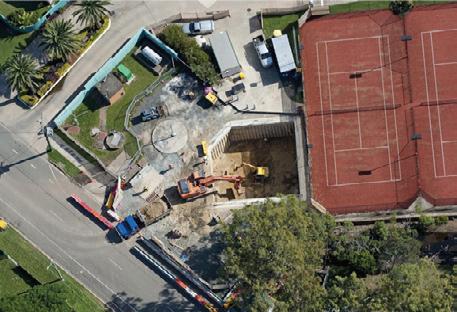
Dormway is a market leader in pipeline and infrastructure construction specialising in complex and challenging projects including:
• Problematic ground conditions
• Constrained sites in local communities
• Environmentally sensitive areas
We’ve delivered over 1000 complex and unique projects both small and large, helping build the infrastructure of cities and communities around Queensland by developing innovative and cost effective construction solutions.
With the breadth of our experience, chances are we’ve delivered a project with similar challenges and can apply our past experience to reduce risk on your project.

Our Services:
• Civil construction
• Pipeline construction
• Pumping stations
• PE lining
• Rehabilitation of pipelines and manholes by installation of PE liners
• Trenchless excavation
• Emergency overflow storage
• Large concrete structures
• Design & construct
• Pre-construction advisory services
Our Clients Include:
• Council of the City of Gold Coast
• Unity Water
• QLD Urban Utilities
• Logan Water
• Mackay Regional Council
• Isaac Regional Council
• Redlands Water
• Brisbane City Council
• Private developers

SMART METERS 43
Phone 07 3718 4777 Fax 07 3879 4348 email@do r m w a y.com.a u H ead O f fice : 176 Bukulla St, Wacol, Brisbane QLD 4076
www.dormway.com.au
BREAKING RECORDS IN LONG DRIVE MICROTUNNELLING
A record-breaking microtunnelled bore was recently completed beneath roads, multiple houses, private property and an old industrial area to replace the deepest sections of a much-needed gravity sewer line as part of Melbourne Water’s Alphington Sewer Replacement Project.
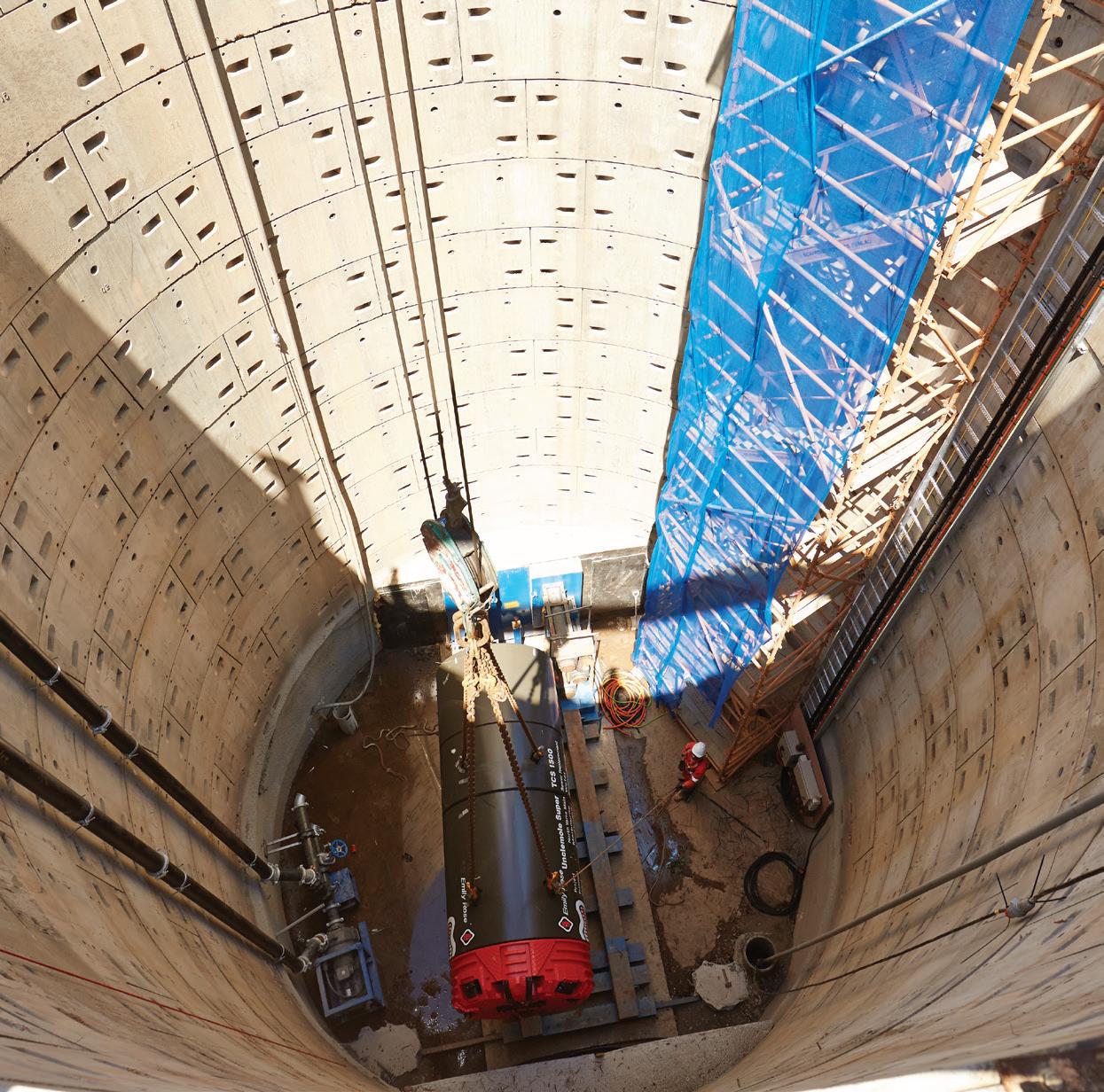
With Lendlease as principal contractor, Rob Carr Pty Ltd was subcontracted to provide specialist deep tunnel construction and associated civil works, with the new sewer line set to reduce sewage overflows and eliminate risk of
asset failure.
The aim of the Alphington Sewer Project was to replace a century-old brick sewer located between Coate Park alongside the Yarra River and the Latrobe Golf Club via a series of microtunnelled bores. The old sewers
had deteriorated significantly and needed to be upgraded to continue to provide essential services to Melbourne’s northern suburbs.
Rob Carr Pty Ltd completed four tunnels as part of the total Coate Park to Latrobe Golf Club construction,
44 Utility Partner Solutions
MICROTUNNELLING
including the company’s record-breaking long shot of HDPE lined concrete pipe.
Due to the depths required of the tunnels, associated civil works were also self-performed by Rob Carr Pty Ltd’s experienced civil crews.
Angelo Soumboulidis, General Manager at Rob Carr, said that the challenging depths and variety of work involved in the project were completed by the construction team, with a wide range of skill sets utilised on site to complete the job.
“We carried out a range of multidisciplinary work besides tunnelling, including trenching, construction of 14m and 17m-deep caissons, 6m and 9m ID respectively, as well as conventionally excavated shafts, large diameter manholes and live connection work including the setup and maintenance of a detailed bypass pumping network.
“Each of the five manholes ranged in depths between 6m to 15m with diameters of 1.2m ID to 5m ID and due to the environmentally sensitive nature of the area, the caissons allowed us to reach required shaft access depths on the deepest shafts while remaining within a small footprint.
“To cater for this diversity of tasks, we brought an average of 20 team members on site, including general labourers, plant operators, tunnel bore machine (TBM) operators, supervisors and engineers to ensure that we had personnel from a range of divisions to complete the works safely and efficiently.”
The longest shots were 270m and 580m of DN1500 HDPE lined concrete pipe, with the fourth shot stealing the show as the longest shot ever being completed by the company. According to Mr Soumboulidis, both longer drives came with their own set of challenges, as they were not only curved in profile, but were further complicated by ground conditions, tunnelling beneath homes and directly intercepting an existing brick sewer midway through the shorter 270m curved drive.
“The biggest challenge of installing the longest bore was that it required a 290m curve of 700m in radius. To complete
this successfully, we underwent a lot of long-term planning and logistical coordination prior to construction, as well as resourcing of highly skilled staff. We ended up relocating a portion of staff from Queensland on a short term basis to complete the drive while our workshop team in Yatala provided maintenance support.
“Ground conditions at the site also posed another major challenge, with ground type varying from clays to basalt with variable rock strengths up to UCS 300MPa. Due to the high rock strengths experienced on the long drive, we had to continually monitor the ongoing ground conditions and regularly inspect the cutter wear and condition of our TBM,” said Mr Soumboulidis.
As launch and retrieval shafts were at great depths and within confined spaces, this required the team to undertake detailed safety measures both prior to and during construction.
“Additionally, the confined space risk of welding the HDPE lined concrete pipe over a single section of 580m was a safety priority from the start, and one which required detailed planning before work commenced. We consulted internal managers and developed a suitable safety procedure, which resulted in an incident free confined space working area throughout the project,” said Mr Soumboulidis.
The project was a prime example of Rob Carr Pty Ltd’s ability to face challenges head on to produce successful results.
“All drives came out on line and grade. This was a great success, especially with the changing ground conditions and required curve of the longest tunnel. Our TBM performed exceptionally well.
“In fact, the TBM used for this project worked so well that is already out on site again, currently being used at the Green Square Stormwater Project in Sydney. The TBM has joined part of a fleet to deliver 3.8km of tunnelling before moving on to the Jindalee Watermain Replacement project to undertake a 585m river crossing on a
compound curved alignment,” said Mr Soumboulidis.
ABOUT ROB CARR PTY LTD
Rob Carr Pty Ltd, the Seymour Whyte Group utilities business, is recognised as a leader in essential utilities infrastructure. Their multidisciplinary service offering is driving new project opportunities for clients that require wide ranging utilities services and turnkey solutions on projects. Rob Carr Pty Ltd specialist services include tunnelling, detailed excavation and caisson construction, pipelines, pump station construction, complex concrete structures, mechanical and electrical works and rehabilitation.
ABOUT THE ALPHINGTON SEWER REPLACEMENT
Melbourne Water’s Alphington Sewer Replacement project improved the network and protected public health and the environment by reducing the future likelihood of sewage spills during extreme wet weather and maintenance issues such as blockages. These issues can be costly and disruptive to the community.
Constructing the new sewer involved trenching and tunnelling under roads, some homes, Amcor, Latrobe Golf Club car park and occupying pockets of local parks and open space. A section of sewer running from the Eastern Freeway at Kew was also constructed, under the Yarra River and into the main sewer.

45 MICROTUNNELLING FOR MORE INFORMATION: WWW.ROBCARR.COM.AU WWW.SEYMOURWHYTE.COM.AU
SAFETY FROM THE GROUND UP
Safety should be the number one priority across all microtunnelling job sites, but how can you be sure that your contractor is taking safety measures seriously across the board? To what extent can you trust their equipment safety measures, and how can you ensure that personnel consistently choose safety first?
From advanced equipment technologies to their overall business model, Edge Underground goes above and beyond to ensure that safety requirements are kept at a high level without fail.
A FOCUS ON EQUIPMENT
According to Stuart Harrison, Managing Director at Edge Underground, safety for the team begins at the equipment level.
“To begin with, our AXIS guided boring system has a superior level of operator safety when compared with all other microtunnelling equipment in the market.
“The operator has full protection from their surrounding environment as they sit within a Falling Object Protective System (FOPS) safety enclosure for the duration of the drill. There is no need for them to be exposed to the outside environment and they are protected from above if anything should happen to fall into the pit.”
As the AXIS systems are owned by Vermeer, these safety enclosures have been vigorously tested to produce a product that can withstand great impacts without showing any sign of damage to the screen.
“Vermeer is self-insured, so their commitment to safety is paramount. Because of this, the operator of an AXIS machine is protected from the impact of drilling rods falling from as high as 10 metres without any damage being made,” said Mr Harrison.
“This is definitely an impressive safety feature and surprisingly, the AXIS system is the only microtunnelling machine on the market that has a safety enclosure at all.”
In terms of the mechanics within the machine, there are also unique safety mechanisms to help personnel while completing the drill.
“The AXIS system is equipped with pressure gauges including a vacuum gauge at the rear of the machine. These feed information to the operator of the machine, notifying them of changes in ground pressure.”
According to Mr Harrison, a pilot shot is always completed before the installation takes place. This is particular to the way Edge operates and allows the team to choose the correct cutter for the ground conditions on site.
This pilot line then enables Edge to assess the ground conditions, so when it comes time to begin drilling, any discrepancies in pressure found by the AXIS pressure gauges allow the team to avoid any problems.

“A change in ground pressure could signify contact with a trench, which could possibly be housing live wires. According to Mr Harrison, there have been instances where power cables haven’t been located by Dial Before You Dig services or pre-project geotechnical surveys.
“If an AXIS drill comes into contact with a power cable, an in-built strike alert mechanism will sound, notifying the operator that the machine has become live. The operator can remain safely within the machine until the power source has been deactivated.
“Most situations like this however, can be avoided due to the pressure gauges notifying the drill operator that there is something up ahead. This is advanced safety technology and one of the real benefits of using the AXIS machine.”
MAKING WAVES IN THE INDUSTRY
According to Mr Harrison, the strike alert mechanism and pressure gauge system have been highly regarded by workmen and site managers, and have gained interest from major utilities as a fantastic way to reduce risk on job sites.
“Utilities have been very impressed with our commitment to safety, delivered through our unique safety mechanisms on our equipment. Our capabilities with the AXIS system have opened up a wider discussion about asset location practices, placing us in good stead in terms of innovation and commitment to safety.
MICROTUNNELLING 46
EDGE UNDERGROUND ON SITE AT A RAILBORE IN QUEENSLAND.
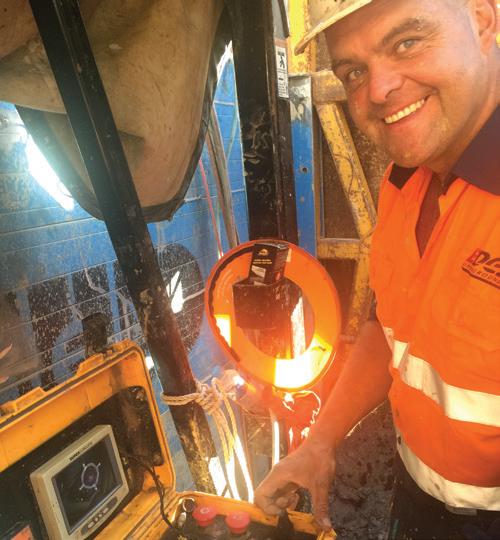
PERSONNEL SAFETY
The entire business model at Edge is another way in which the company is able to consistently carry out projects with a high degree of safety.
“As everyone at Edge has the ability to work as their own boss, they are dedicated to providing the very best service. Safety is therefore a top consideration for all personnel, as each contractor strives to do the best job possible to encourage more work opportunities to follow through.
“This is a very powerful force and results in everyone being 100 per cent motivated, improving reliability and attention to detail.”
THE REALITY
The reality of job site safety is that there is a lot of old equipment still being used by contractors throughout the country. The newer the equipment, the more safety features included, so it is important to choose a contractor with up-to-date machinery.
According to Mr Harrison, especially due to WorkSafe Australia, there has been a growth of awareness in overall safety within the drilling industry.
“From my experience having seen and worked on many job sites internationally, Australia leads the way in site safety and awareness.
“However, it is important then, that all contractors across the country step up to the standard by updating their equipment and safety procedures.
“Without a doubt I can say that the AXIS guided boring system is the safest drill on the market. Winner of the No-Dig 2009 Innovative New Product of the Year Award, there has never been a workplace incident as a result of using this machine.”
For more information, contact Stuart Harrison on 1300 JACKED.









ABOUT US
Edge Underground is a precision microtunnelling contractor that operates in Australia and the USA. With a focus on innovative technology and expertise, Edge Underground designs and enhances the performance of trenchless equipment.
MONITORING TARGET GRADE VIA THE OPERATOR CONSOLE.
OUR SERVICES
• Microtunnelling
• Pipe Jacking
• Thrust Boring
GUIDED BORING SPECIALISTS
stuart@edgeunderground.co 8 www.edgeunderground.co Find out more about keyhole pipeline installation www.keyholepipeline.com.au
JACKED 0458 000 009 ( JACKED 1300 522533
• Laser Tunnel Boring
*
1300
Odour control at GOLD COAST WATER
There are 500km of waterways within the City of Gold Coast, which means the city also has a large number of bridges. Gold Coast Water, which is responsible for providing water and sewerage services to the City, also has over 500 sewage pump stations. This means that on a number of bridges, there are pipelines which have sewer air valves installed.
Over the years these valves have been a source of odour and noise complaints among local residents.
“We found that when the valves released methane gas, vehicles passing over the bridge would drag the gas to the nearest resident living close to the bridge,” said Paul Heaton, Director of Gold Coast Water.
The City also found that noise complaints were an issue. When the valves released late at night or early in the morning, the noise they emitted would disturb nearby residents while they were trying to sleep.
“With some innovative thinking, our staff came up with a design to not only control the odour issue but resolve the noise issue at the same time,” said Mr Heaton.
Jason Vade, Sewerage Maintenance Team Leader explains: “By attaching a cam lock to the outlet of the air valve, we were able to run a 50mm hose from the valve – usually inside a conduit for sun protection – and run it off the bridge to a convenient location beside the bridge.
“This hose then runs into the bottom of a 210 litre polyurethane drum. Inside the drum, staff installed a 50mm PVC pipe drilled with holes to allow the gas to be emitted. Stainless steel mesh installed just above the pipe work ensures carbon doesn’t fill the holes in the pipe work. Around the pipework,
under the mesh, gravel was inserted for drainage purposes (condensation) and a small 25mm ball valve installed.”
The drums are filled with approximately 60-70kg of activated carbon. In the lid of the drum, or on top of the protection box, staff installed a 100mm vent to allow the gas to escape after being treated.
“Depending on the location, we may put the drum inside a green protection cabinet to deter vandals,” said Mr Vade. “This is also more aesthetically pleasing for the neighbourhood and local environment.”
The units are on a scheduled maintenance program for staff to regularly check the quality of the carbon. “If the carbon requires changing we simply vacuum it out with a small commercial wet/dry vacuum or vac truck,” said Mr Vade.
The first of these drums was installed about seven years ago, and there are now approximately twelve installed on Gold Coast bridges.
“This has been a great result, and it requires minimal maintenance,” said Mr Heaton. “We believe sharing this information can be of use to other councils, water service providers and contractors.”
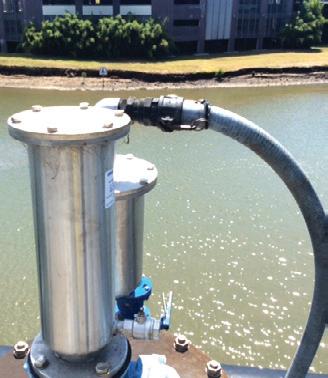
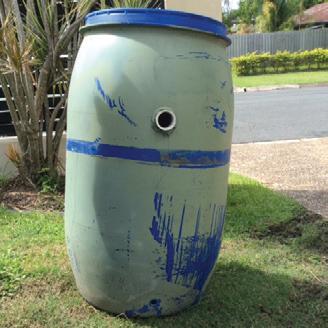
WATER 48
ONE OF THE DRUMS CONNECTED TO
A SEWER AIR VALVE INSTALLED ON A GOLD COAST BRIDGE.
THE VALVES.
Hardman Chemicals –World class products, & a history of success
Manufacturing water and waste treatment chemicals in Australia since 1948.
ALCHLOR RANGE
The coagulant of choice for potable water
The Alchlor range of Aluminium Chlorohydrate products has been developed by Hardman Chemicals to cover a range of water treatment conditions, providing the highest performance for most applications.
Advocates Experiences:
“Stopped dosing lime and soda ash for pH and Alkalinity correction”
“Substantial reduction in chemical dosage and aluminium residuals”
“Superior membrane filtration performance”

MULTIFLOC RANGE
Flocculant solution for a range of waste waters
Applications:
• Municipal sewage treatment
• Mining & industrial plants
• Food processing
• Abattoirs, feedlots & rural sale yards
• Waste transfer stations & composting plants
• Phosphorus removal from effluent
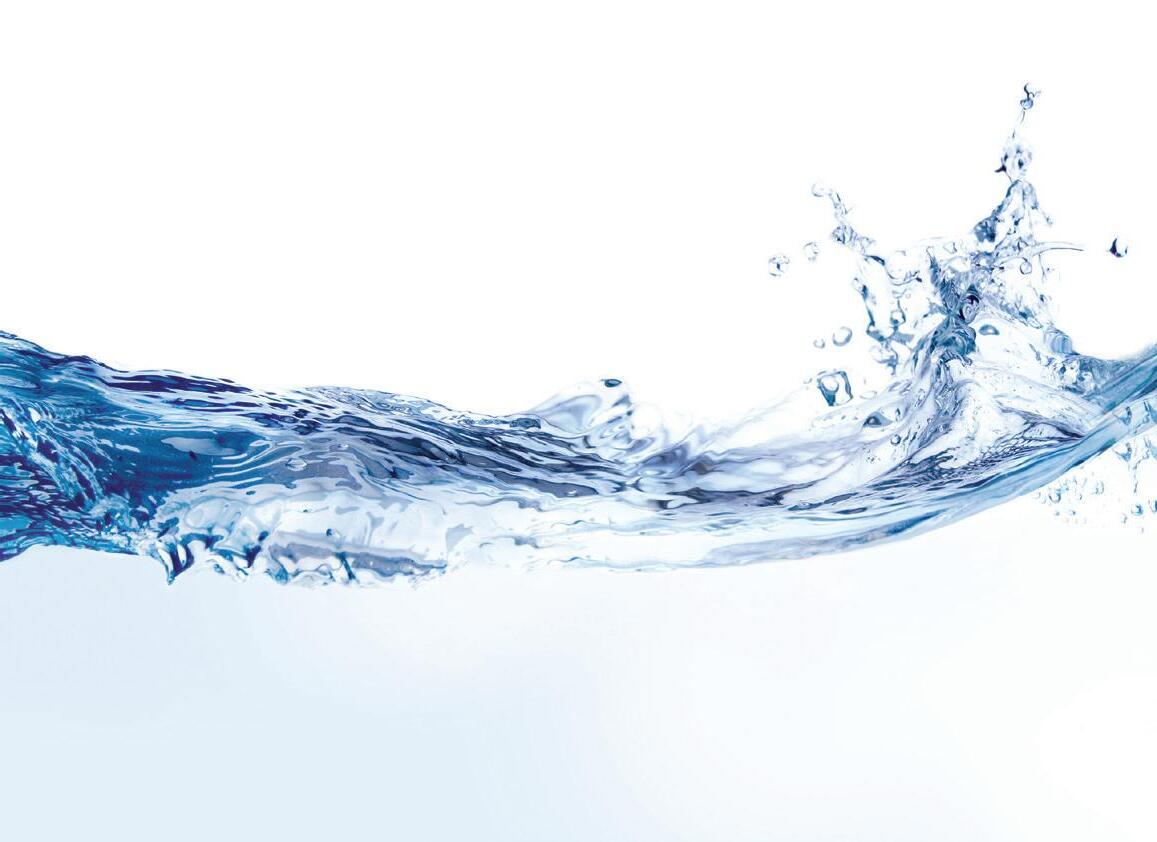
Call us today for technical assistance and evaluation of your water process on +61 2 9624 1333
www.hardman.com.au PTY LTD
MANAGING RISK Modelling catchments,

Seqwater’s Source Protection Team is undertaking a five-year catchment modelling program to better understand how risks and catchment scale interventions can impact South East Queensland’s drinking water supply at the source.
The program, a first for South East Queensland waterways, allows users to interact with modelled data to improve understanding of the relationship between sediment loads and riparian vegetation cover.
Seqwater Chief Executive Officer
Peter Dennis said the model would ultimately be used to support long-term source water protection plans by providing a greater understanding of catchment behaviour.
“Previous investigations in South
East Queensland have shown that riparian vegetation is the dominant factor in stabilising and protecting the banks of a river,” Mr Dennis said.
An investigation into the relationship between sediment loads and catchment characteristics, including run-off, land use, slope and remnant riparian vegetation, found that sediment yields from catchments containing no remnant riparian vegetation were between 50 and 200 times that of a fully vegetated catchment (Olley et al., 2012).
50
WATER
Pressure Sewer Systems

The SPC controller programmed with SCOP reduces pipe sizing, sewage detention times and the requirement for odour control, aswell as reducing the number of and required capacity of conventional pumping stations.
Control Strategy
Showing peak flows in the system being removed with SCOP
SPC Controller and SCOP (Sequence Control Operation Philosophy)
SCOP can integrate pressure sewer and gravity networks to give a common platform for pumping systems within your network allowing you to maintain and improve network efficiencies.
Using SCOP allows us to:
– Decrease pipe sizes which in turn ensures that sewer does not turn septic and means sewer is always in the WSAA low risk category for sewage age. It self-scours the entire network so your pressure sewer system is running at optimal performance
– Minimise ultimate infrastructure required (e.g. omit possible pump stations required for the project)
– Control the flows from each system to ensure we operate during the troughs of receiving pump stations and treatment plants to eliminate peaks in the system.


Omni Grind Turbine (OGT) Domestic Pump
Regenerative turbine impeller capable of 80m head and 1.25l/sec, no contacting wearing pump parts (e.g. no rotor and stator), no scheduled maintenance and 20 year life*.
Omni Grind Plus (OGP) commercial pump
Only commercial pump available to the pressure sewer market, vortex 2-stage recessed impellers capable of 60m head and 1.75l/sec, only 10% of particles ever come into contact with the impellers meaning no scheduled maintenance and a 20 year life*.
—
Find out more aquatecenviro.com.au *Tested for the equivalent of 20 years useage for domestic sewer applications.
2am 4am 6am 8am 10am 12pm 2pm 4pm 6pm 8pm 10pm 12am Usage (Flow) Time
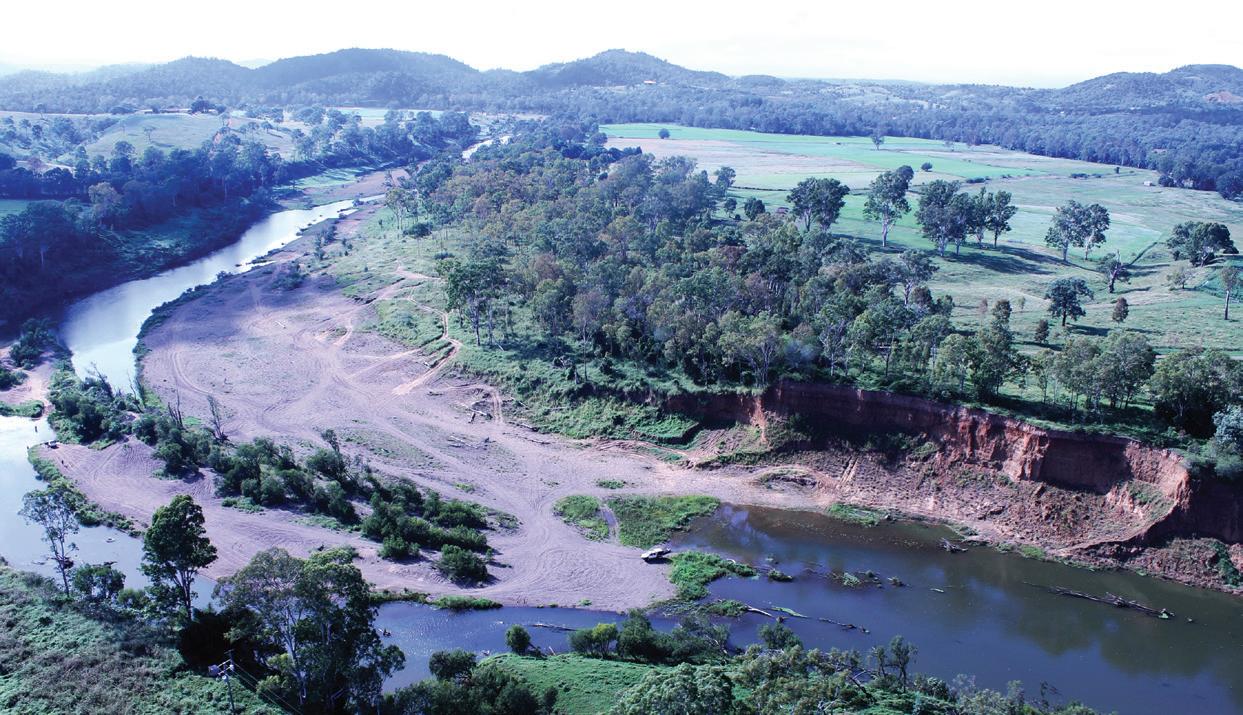
Mr Dennis said the modelling project would enable Seqwater to assess the effectiveness of investment in the region’s drinking water supply catchments at a broad scale.
“The model enables us to trial different scenarios within a catchment to target sources of high pollutant loads. For example, what is the sediment load reduction to waterways when all buffers are vegetated? Or what are the risks to water supply if vegetation clearing was to increase?” Mr Dennis said.
“Our modelling simulates water flows in the catchment. By observing how runoff from the land flows into streams and rivers, we can identify critical pollutant transport mechanisms.
“The various scenarios trialled within the tool are attempting to quantify the impacts to the source drinking water supply.”
Mr Dennis said the tool contained the current stream length in remnant riparian vegetation cover, which could be adjusted to inform an investment scenario.
“The riparian vegetation cover, calculated for each sub-catchment, can indicate where the highest risks are
for sediment loads, so we can target investment accordingly,” he said.
“The land use summary tells us what the high level activities are in the catchment so that we can develop suitable projects and management actions. This provides an indication of what pollutants are typically coming off the land during rainfall events, which could help us identify where the water quality issues downstream are coming from.”
Mr Dennis said models were initially completed for the Mid-Brisbane and Lockyer Valley catchments, which deliver water to the Mt Crosby East Bank and West Bank water treatment plants.
The Mt Crosby water treatment plants are the primary source of drinking water for the greater Brisbane and Ipswich areas, and can contribute up to 40 per cent of the total drinking water supply for South East Queensland via the Water Grid.
“Research shows channel stabilisation is the best way to reduce adverse impacts to water quality in these downstream creeks and rivers. Therefore, a coordinated approach is recommended
to target riparian bank stability and vegetation health.”
Mr Dennis said this type of catchment modelling is intended to only provide a high-level estimate of likely sediment loads from different areas of a catchment based on expected run-off, land use and riparian vegetation cover.
“The modelling allows us to identify hotspots in the catchment for likely sediment loads, which we can then examine in more detail for project development,” he said.
Seqwater now has catchment models developed for the Baroon, Upper Brisbane, Logan River and Nerang River catchments.
Further assessments will be assessing yield, future land use change, climate change impacts and different pollutants (such as pathogens and salinity) to better understand the risks to the drinking water supply at the source and where management interventions are best targeted.
For more information about Seqwater and its services, visit www.seqwater.com.au.
52
WATER Modelling catchments, managing risk
The leading provider of short courses for environment professionals in Australia
IWES Gold Coast 2016
The Gold Coast event is the largest on the IWES calendar, 11 - 15 July 2016.

Based at Mantra Legends Hotel, Surfers Paradise. IWES Gold Coast will include a range of high quality short course training for environment industry professionals. Courses will be taught by leading industry practitioners and designed to keep busy professionals abreast of the latest trends, technologies and practices.
Visit our web site www.iwes.com.au for up to date information and registration details.
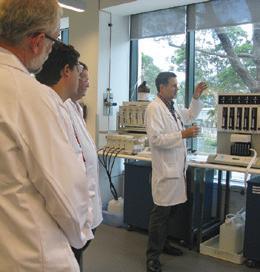


Some of the courses on offer:
•Principles of Wastewater Treatment, Drinking Water Treatment – Principles Practice and Applications, •Design of Biological and Advanced Wastewater Treatment Processes, •Membrane Systems, Recycled Water Management, Best Practice Drinking Water Quality Management, •Corrosion and Odour Management in Sewers, • Contaminated Site Assessment and Remediation For
info@iwes.com.au or
our
where you can download the brochures and
when they are
further information phone 1800 000 404 Email is
visit
web site www.iwes.com.au
registration forms
available.
RELIABILITY, EFFICIENCY Superior Performance

With many existing water treatment plant control systems using ageing equipment and operating beyond recommended life expectancy, new upgrades are often required to avoid costly breakdowns and loss of service. However, deciding when to upgrade, and indeed whether to upgrade at all, is an important decision that can at times be overlooked and considered too difficult, placing unnecessary risk on equipment and personnel.
One of the main factors for determining when to upgrade your plant is the motivation generated by the increased performance and reliability that operators can experience, and come to expect from a new control system.
Water industry authorities are continuing to face major challenges including reduced operating and maintenance budgets, the need for increased security, government regulations, and regulatory compliance. By implementing an enhanced process control system with advanced networking and diagnostic capabilities, such as Rockwell Automation’s PlantPAx solution, utilities can now tackle all of these challenges whilst providing sufficient return on investment to justify the upgrade.
Plant wide access to process data and secure remote access solutions are just some of the features that will enable superior visibility and control for better preventive and predictive
maintenance. Further, the reliability and efficiency of a plant can be significantly improved through the access to real-time data and intelligent motor control solutions. These features allow users to identify operation and performance trends to ultimately make better use of assets, all while reducing energy consumption. In addition to this superior performance and efficient modernisation of control assets, system upgrades will also result in lower overall plant operating costs, minimised downtime and reduced maintenance costs.
However, the performance of any automation solution is only as strong as the weakest implemented link. Further, the means of enclosing and protecting your field equipment is just as important to ensure critical systems such as pumping stations, treatment plants and remote access services continue uninterrupted. In a harsh corrosive environment, enclosure solutions have typically been constrained by a trade-off
between high initial investment, such as stainless steel or cheaper alternatives, but with shorter lifetimes and increased maintenance.
Utilising the latest technology of a unique blend of glass-reinforced polycarbonate, NHP is able to offer the ARCA enclosure range that provides comparable strength (IK08), corrosion and UV resistance (15+ years) as stainless steel, at half the weight and cost. Not only is the ARCA range corrosion free, but it is also perfect for remote access with the antenna and equipment fully sealed within the enclosure.
From your complete process control system to the enclosure protecting it, NHP is a trusted local partner that can help utilities experience the full benefits of a system upgrade. For more information on implementing a complete solution providing reliability, efficiency and superior performance, contact your local sales representative or call 1300 NHP NHP.

Utility Partner Solutions 54 WATER
Your partner in water and wastewater
Reflecting the need for sustainable use of water and wastewater, NHP offer a complete suite of products and services that employ cutting edge energy efficiency techniques and management tools.
Our extensive global network of suppliers includes leading automation provider Rockwell Automation and together we offer the benefits of remote access and control as well as access to data and reporting of your energy usage and asset performance.

Providing the optimal balance of knowledge and experience, a partnership with NHP promises to last the life of your project, providing quality, assurance and peace of mind.
For your next water and wastewater application, trust NHP to engineer a customised solution.
NHP ELECTRICAL ENGINEERING PRODUCTS PTY LTD Sales 1300 NHP NHP | nhp.com.au | EASY TO DO BUSINESS WITH Scan the QR code to access the NHP Solutions City where you can view exclusive video content, case studies and literature or visit nhp.com.au/city ��������������������������������������������� NWATERUTILADV

OF OUR WATER ASSETS Increasing the efficiency
Infrastructure Australia’s Australian Infrastructure Plan was released in February. General Manager of Operations for SUEZ, Mark Lautre, explores the plan and its calls for greater efficiency and improvements in water utilities across Australia.
It is clear the Australian Infrastructure Plan recognises the important role the urban water sector plays in Australia. With over $150 billion in assets, the plan is right to examine the water sector and how it can continue to contribute to the productivity and liveability of our cities and regions.
The plan highlights the challenges of regional water utilities. In particular, it details the growing cost of service delivery, challenges with insufficient scale, declining asset condition and the lack of capacity to respond to emerging technologies.
The plan presents bold ideas for reform including aggregation of government-owned operations or the privatisation of water assets. Whichever the model, it’s pleasing to see that the plan has a clear customer focus.
Ultimately, all utility owners and operators are interested in providing Australians with high quality water and a reliable supply at the most affordable price possible. In Australia, it’s important to acknowledge that there are already examples where the private and public sector have partnered to deliver on this customer promise.
SUEZ is involved in two operating alliances in Australia which are delivering real sustainable savings and improved customer service levels.
Working in collaboration with our partners, Water Corporation of Western Australia and Broadspectrum, the ‘Aroona Alliance’ has delivered $5.55 million in sustainable operating savings through business efficiency improvements in 2014/15. In South Australia, SUEZ
again works with Broadspectrum in a joint venture called Allwater. Both companies in an Alliance with SA Water are embracing change and finding better ways to do things to bring cost savings to the network.
The Alliance model enables SA Water to work flexibly with its partners to deliver water services to metropolitan customers. The model relies on expertise from all partners to drive improvements in operational efficiency, energy efficiency, asset management and supply chain with positive outcomes.
The results in Adelaide have been pleasing. For example, across the six wastewater treatment plants, the team has increased energy efficiency by five per cent in 2014-15, translating to a total cost avoidance of $500,000.
The Alliance is also tapping into global expertise with a range of technical support and cooperative research initiatives underway. In February 2015 the alliance began a project to develop modelling tools to quickly identify composition of algal blooms in water resources.
It is clear that water utilities across Australia are faced with ageing infrastructure and limited capital. However, there are many opportunities in the short term to maximise the performance, decrease total cost and extend the life of our assets.
The Australian Infrastructure Plan presents some ideas. Firstly, on how the management of data and technology can play a role in helping operators to improve network efficiency and save costs. In the water sector, sensors are
now being used to manage networks in real-time, allowing more efficient management of established systems and improved response to customers’ needs.
The use of data assists operational decision making to reduce system leakage and allows capital expenditure to be prioritised and optimised. SUEZ has developed an innovative, realtime network monitoring tool called AquadvancedTM that is assisting our clients around the world.
Optimisation of energy usage and generation of energy to offset imported energy requirements in wastewater treatment facilities is well developed in the water industry, but even greater performance is being achieved through the deployment of emerging technologies.
In Amman in Jordan, SUEZ built, co-financed, and has been operating the As Samra Wastewater Treatment Plant (WWTP) since 2008.
Through hydro energy and biogas production, the WWTP is 80 per cent energy self-sufficient with only 20 per cent of its needs drawn from the national grid. 230,000kWh of energy is produced per day.
Whether it’s in Jordan or Australia, the sharing of expertise has been key. Alliance models are about providing access to and transferring know-how and expertise to local staff with a shared goal of improving operational efficiency. The model is working well in Australia and is contributing to improving the performance of our water utilities.
WATER Utility Partner Solutions
11st. phase (2003) was financed by SUEZ and its partner Morganti, an affiliate of the Consolidated Contractors Group, USAID (United States Agency for International Development), and a pool of 10 local banks led by Arab Bank. The 2nd. Phase (2012) was co-financed by the same sponsors and MCC (Millennium Challenge Corporation); Arab Bank arranged a syndicate of nine local and international financial institutions to provide a loan. 56

We can optimise energy consumption, increasing your plant performance
Smart rain: TRACKING INFLOW AND INFILTRATION
Rainfall data offers a rich source of information that can be integrated with other system management data sources to actually predict problems and mitigate sewer overflows – while improving service levels, lowering maintenance costs and better informing long-term planning processes.


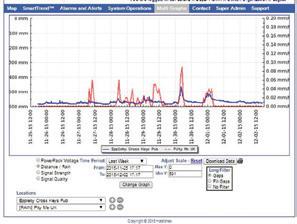
SIf wet weather loadings on your treatment plant & sewage manhole overflows are causing you grief….. SMARTCOVER® CAN HELP now even smarter with SmartRain®

martRain® is a new tool from SmartCover® Systems that automatically integrates rainfall data within the SmartCover software environment, so that it can be used along with level or flow data in the collection system. For users of SmartCover® level monitors or SmartFLOE® flow monitor system, rain data is acquired and presented in the user interface in a single display.
This seamless data integration capability provides an easy method to view and understand the relationship between local rainfall events and abnormal sewer levels and flows, facilitating the tracking of inflow and infiltration (I&I).
Excessive I&I quickly drives up treatment costs, as well as contributing to overflow risks, but tracking it down is historically difficult. SmartRain® provides operators and managers with the needed data to pinpoint I&I, by correlating sewer flow with rainfall for each measuring station.
FLEXIBLE
No electricity required. No SCADA system required. Available from any location on earth.

View and understand relationship of sewer level or flow changes as affected by rain, with real-time 24/7 super accurate rainfall data from your nominated pinpoint locations.
SEAMLESS
Seamlessly characterises these two essential data streams, providing intelligent identification of costly I&I sources within your sewer collection system, Turning your Data into Decisions®
In addition, SmartRain® gives users access to immediate, historical and forward-looking data which can easily integrate into flow models, and validate sewershed flow modelling. Providing calibrated rainfall data at a number of sites over a wide area, and integrating it with real-time and historical flow and level data enables planners to correlate data streams over selected timeframes and even export the data for offline analysis.
For More information on how SMARTCOVER® sewer monitoring can benefit your sewer reticulation and treatment network contact us
Phone: 1800 678 910
sales@qmaxpumping.com.au REAL TIME
This capability provides a powerful planning tool to optimise system performance and plan maintenance and upgrade works. Then, when the rains come, as they surely will, SmartRain® real-time monitoring will enable you and your team to quickly prioritise potential problem areas and rapidly respond where it will be most effective.
WATER 58 Utility Partner Solutions

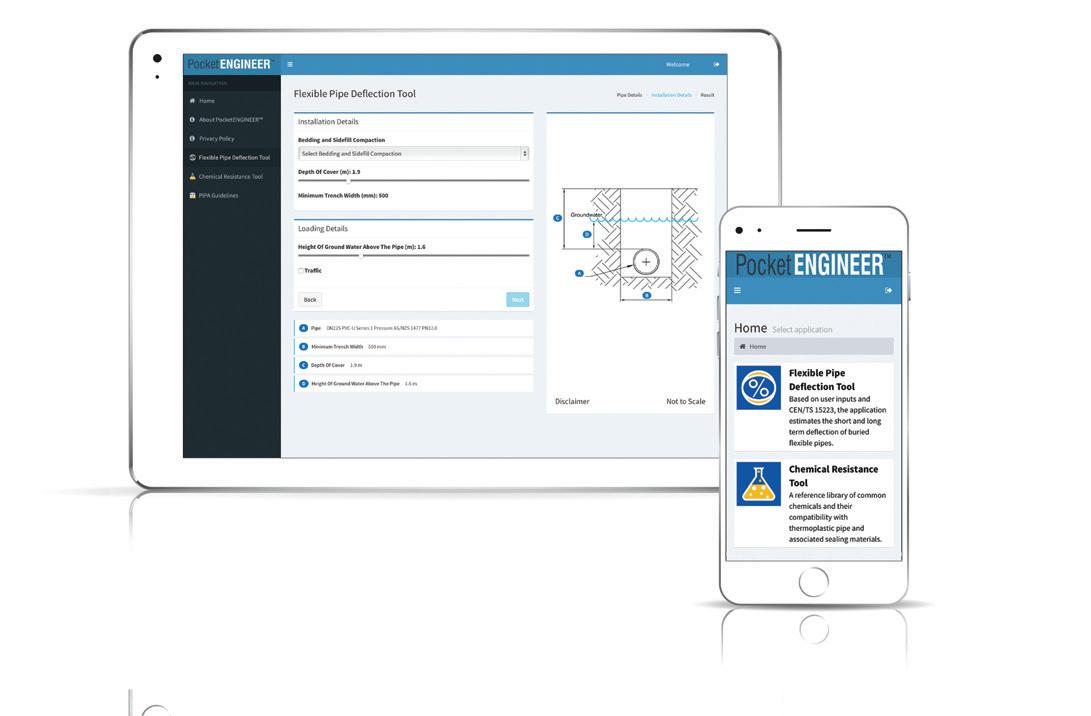
FREE TO ACCESS PIPELINE ENGINEERING SOLUTIONS; NOW PORTABLE Your portable Iplex design assistant has arrived! www.iplex.com.au Dedicated People. Total Solutions. WWW.IPLEX.COM.AU ACCESS IS EASY: STEP 1 GO TO POCKETENGINEER.COM.AU OR FOLLOW THE LINKS ON IPLEX.COM.AU STEP 2 AFTER A ONE TIME REGISTRATION, LOGIN TO YOUR ACCOUNT. STEP 3 SELECT THE DESIRED TOOL. With data compiled via internationally accepted standards and specifications, the Iplex Pocket ENGINEER ™ offers portable convenience and the confidence to make the best and most optimal, pipeline choices. Conveniently access this free application via mobile or desktop web browser. Features include an intuitive Flexible Pipe Deflection Tool , a complete list of Chemical Resistance Pipe Data and the official PIPA Guidelines . Get the information you need, where you need it and free with the Iplex Pocket ENGINEER ™ Make the right choice, on time and on-site with the Iplex Pocket ENGINEER ™
Drilling for a SUSTAINABLE FUTURE
Central Park in Sydney’s CBD is a unique urban hub powered largely by a centralised trigeneration thermal plant. The plant provides the energy demands of each building on site via an underground thermal piping network. To expand this energy network to service surrounding infrastructure, a trio of trenchless crossings were dug beneath Broadway, beginning at an unusual depth of 20m below ground.
THE WORKS
Brookfield Infrastructure acted as lead contractor, with Australian Wide Directional Drilling (AWDD) brought in to complete the trenchless installations. Works began on January 4 and were successfully completed by February 9 2016.
Horizontal directional drilling (HDD) technology was chosen to complete each bore of 70m in length, using a Vermeer D100x120 HDD rig.
Four pipes and two communications conduits were installed in total, with 2x125D pipes sharing a single bore, and the remaining 2x500D pipes installed in separate bores. The pipework will provide a chilled water (flow and return) service as well as a recycled water and sewerage network.
To connect to the underground thermal plant at Central Park, each bore was drilled from the existing basement 20m below ground. The bore was then terminated at a depth of 4m on the other side of Broadway, one of Sydney’s main arterial roads, and adjacent to the grounds of the University of Technology Sydney (UTS).
Once the new UTS buildings are developed, a pit will be excavated to allow access to the pipes which will then enable thermal service to the new UTS facility.
CHALLENGES AND TECHNIQUES Logistics
Because the bore had to be completed entirely below ground, special tooling and logistics had to be considered. According to Corey Passlow, General Manager at AWDD, the biggest challenge was getting the machinery down into the basement.
“As you can see in the picture, we brought in a 300 tonne crane to lift all of our equipment. This included excavators, drill rigs, trucks, recyclers and site sheds.
“Everything also had to be brought into the basement within daylight hours, so it was a pretty busy day for everyone on the team,” said Mr Passlow.
Bores
The fact that the bores travelled up from 20m below ground to 4m below ground meant that the bore alignment was tight.
As the bore was required to finish 4m below the surface, each pipe was not able to be pulled back through the bore as standard. Because of this, the pipe had to be pushed up into the bore instead. Once the pipes were installed into their final position they were grouted and then strength and leak tested.
This unusual situation of only forward reaming the bore, and then pushing the pipes into place, also meant that drilling mud had to be recycled while the bore was being created, so a 30 tonne Vermeer R9x12T recycle system also needed to be lowered into the pit.
“During the drilling process, drilling fluids are being pushed up into the hole so that the mud motor can then push the material that is being drilled, back down the bore,” said Mr Passlow.
“Once it comes back down the bore, this mud needs to be filtered. As Sydney is predominantly sandstone, this had to be removed and recycled before the mud could be pushed back up the hole.
“It was a big task for the R9, yet it performed well –without a hitch,” said Mr Passlow.
A FOCUS ON QUALITY EQUIPMENT
AWDD has been using Vermeer machinery from the beginning, and swears by its high quality and service.
“We have always used Vermeer, and bought our equipment from them brand new. We wouldn’t consider using any other machinery for a project such as the Broadway crossing,” said Mr Passlow.
“We also have a specific service agreement with Vermeer, so their back-up and technical support has been instrumental to our success.”
ABOUT CENTRAL PARK’S THERMAL NETWORKS
Central Park is a multistage $2 billion urban hub comprised
PROJECTS 60
of parkland, apartments, restaurants and boutique shops.
The site’s in-house trigeneration thermal plant uses ‘green transformers’ powered by natural gas. So far, the plant has been able to reduce peak energy demand by utilising storage facilities (i.e. hot and cold water storage) to enable a better economic and environmental energy solution for the development.
The plant currently provides hot and cold water to the development (an area in excess of 300,0002) and also provides half the site with electricity. This makes Central Park Australia’s greenest urban village.
Project economics are driven by:
• Material reduction in demand charges
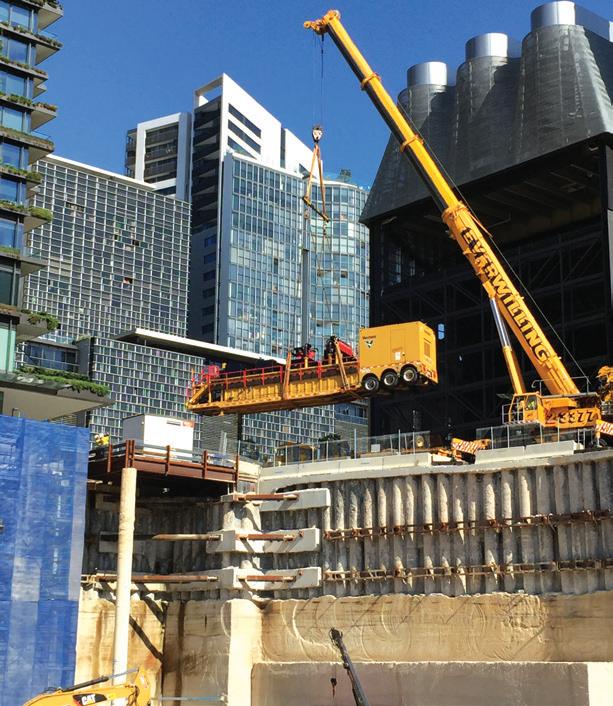

“Making Boring Interesting”

SERVICING THE UTILITY SECTOR THROUGHOUT AUSTRALIA Phone: (07) 5433 7200 admin@australiawidedd.com.au www.australiawidedd.com.au Your one stop shop for all directional drilling needs
PROJECTS
SMART SEWERS: REVOLUTIONISING THE WAY UTILITIES MANAGE WASTEWATER NETWORKS
A unique tool originally developed for monitoring wastewater assets has evolved into a system which allows the digital management of entire wastewater systems. We spoke to iota Managing Director Phil Thompson to learn more about the innovative OneBox Intelligent Sewer device.
OneBox was designed and developed by iota, which is owned and managed by South East Water. South East Water’s pressure sewer projects date back more than 15 years, with early deployments including OneBox on the Mornington Peninsula and Gippsland.
OneBox technology originally focused on monitoring and alarms, and enabling the identification and rectification of problems without the need for customer intervention.
South East Water soon identified opportunities for OneBox to play a more central role in its networks, not only monitoring the status of the sewer connection, but regulating flows and removing peak volumes from the network.
With OneBox, South East Water has the ability to significantly reduce flows compared to gravity and uncontrolled pressure sewer systems, and also avoids exacerbating overflows downstream during storms.
“With OneBox, we’re able to spread volumes across a much longer period – and as a result, we’ve been able to downsize our reticulation network and transfer mains,” said iota Managing Director Phil Thompson.
OneBox has been described as a “smart meter for sewers”. It monitors levels in the pod, as well as pump current, and has alarms in place for high levels, long pump runs, overcurrent, communications failure, and power failure.
“With access to all this data, the OneBox system allows the network to be controlled to remove peaks and recover in the event of a power outage by prioritising pods with the highest levels,” noted Mr Thompson.
“In addition, OneBox provides high visibility of inflow and
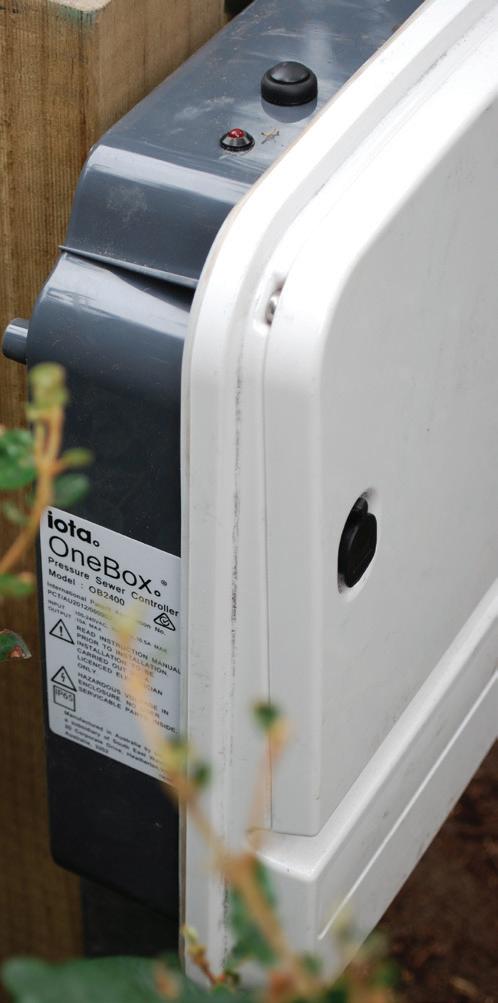
PROJECTS 62
THE ONEBOX INTELLIGENT SEWER DEVICE.
OneBox®
An intelligent, cost-effective low pressure sewer solution for all environments
Engineered low pressure systems
Comprising a pump unit installed in a small storage tank at each house, a pressure sewer connects properties to a reticulated network, which transfers waste water to the treatment plant or a broader sewer system. Unlike gravity sewers, the pressure sewer solution is at home in a range of challenging environments, including high ground water, impenetrable bedrock, and steep elevation, and because it uses smaller diameter pipes, capital costs are greatly reduced.
Imagine if you could monitor your pressure sewer units in real time – and operate them remotely
The OneBox® telemetry system gives you complete control of your fleet of pressure sewer pumps from your office desktop or smart phone. You can fix faults as they arise, dramatically improve your efficiency and take customer service to the next level.
With OneBox® you can:
o Smooth out diurnal peak flows and maximise efficiency of downstream infrastructure
o Remotely monitor and control individual neighborhoods of sewer pumps on a real-time basis
o Get alerts before the customer even becomes aware of any faults
o Schedule maintenance crew responses to problems at cost-effective times
o Analyse trends, generate reports and determine your peak flow demand
o Reduce unnecessary capital investment and minimise maintenance costs.
Who is iota?

iota is responsible for the commercialisation of South East Water’s innovations, products and services, and is a one-stop shop for design, construction, commissioning and data-hosting for all low pressure sewer systems, no matter how big or small.
Contact us to see how our smart technologies can transform your water and sewer networks
Phone 1300 643 711
Email info@iota.net.au
Visit www.iota.net.au
OneBox® Monitor and control network pumps Pressure sewer
infiltration on individual properties, which aids with problem management, and enables responses to alarms before the householder is aware of the problem,” said Mr Thompson.
“OneBox provides opportunities for significant savings in capital expenditure and allows growth without worsening capacity issues and overflows. It also enables easier maintenance of pipelines.”
Across its network, South East Water receives an alarm if there is an issue with a pump installation, and can view the installation and efficiently manage a maintenance activity without the customer being involved. The utility has full monitoring of each installation, which significantly reduces spill risk.
In an example of a recent customer benefit, a complaint was received from a customer that their toilet was backing up. The operator was in a position to view the installation on the portal and advise the customer that the level in the
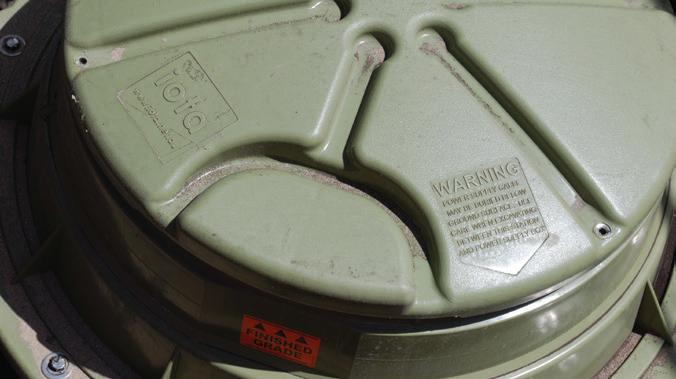
customer’s pump pod had not changed in hours, and that there was therefore a blockage in the lateral. When the blockage was cleared, the flush inflow into the pod was recorded. The customer had the issue identified and could get the blockage removed cost effectively, and the utility provided the appropriate advice at no cost.
REBUILDING CHRISTCHURCH
The OneBox system isn’t just used by South East Water – the technology can be deployed by utilities around the country and even internationally. In Christchurch, New Zealand, OneBox is being deployed in the rebuild of the city’s sewer system, following the devastating earthquakes that struck the city in 2010 and 2011.
iota provided advice to Christchurch

PROJECTS 64
City Council (CCC) about the option of low pressure sewers following the earthquake. “We then produced a feasibility report for one part of the city’s redevelopment,” said Mr Thompson. “CCC recognised the capital cost saving achieved through reduced peak flows and general flow management capabilities, and contracted iota as the design sub-consultants for the low pressure sewer.”
CCC has localised capacity constraints within parts of their gravity sewer network, so the ability to manage storm flows offers significant capital cost savings. CCC also has infiltration issues with damaged property laterals and high groundwater, so the ability of the OneBox to identify all infiltration for each wet weather event on an individual property basis was seen as a key benefit.
“The OneBox peak shifting mode has also reduced design flows for the Upper Styx catchment, allowing new
developments to connect to adjacent existing infrastructure without the requirement for a new pump station and long transfer mains to discharge further downstream in the existing network,” said Mr Thompson. “In South East Halswell, the installation of OneBox has reduced the size of the transfer pump station and rising main, and avoided the requirement for emergency storage at the transfer pump station.”
The OneBox monitoring capability also facilitates the identification of on-property infiltration. The initial connections identified infiltration following the first heavy rainfall event after their installation, which then triggered CCC to request the property owners to undertake repairs to their laterals. The management of low flows for both Upper Styx and South East Halswell will benefit from the OneBox flushing mode, to provide scouring in the initial years with low flows during the
CUT & CLEAN
CONCRETE CUTTING • SLURRY RECYCLING
Cut and Clean Concrete Cutting is a specialist provider of concrete and asphalt cutting services. We have been working in the civil industry for over 25 years and provide a 24/7 service.
- Concrete/ Asphalt Flat sawing to depths up to 525 mm.
- Slurry Vacuuming and Recycling
- Hand sawing to depths up to 150 mm.
- Core holes up to any size
- Silence blades (up to 375 mm deep)
- Hydraulic Sawing
PHONE: (03) 9458 1434
MOBILE: 0412 311 963
WEBSITE: www.cutandclean.com.au
EMAIL: info@cutandclean.com.au
early years of development.
WORKING TOGETHER
Utilities here in Australia can also benefit from the features of the OneBox system. For interested utilities, iota provides full network design and equipment supply through a design team with extensive experience. The experience of the iota design team includes construction of the largest pressure sewer scheme in the world with 16,200 connections on the Mornington Peninsula in Victoria.
Patented control technology with in-house design and continuous construction and operator feedback are additional significant benefits iota can offer to utilities.
For more information about iota and the OneBox system, head to

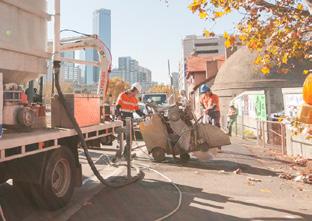
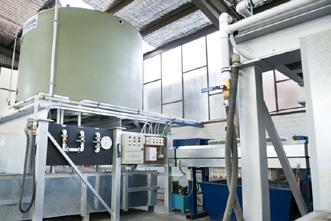
PROJECTS 65
THE EVOLVING ROLE OF POWER UTILITIES IN AUSTRALIA: PLACING PARAMOUNT IMPORTANCE ON CUSTOMER EXPERIENCE
by Sarah Wang, Senior Consultant, Industrial Practice, Frost & Sullivan
Power utilities in Australia have played a critical role in ensuring the availability of electricity in every corner of the country. However, over the last ten years, the landscape of power generation has been gradually changing, moving away from a centralised to a partially distributed model, due to rising electricity tariffs and the need for a reliable source of power.
With a growing number of people installing solar panels in homes and businesses, the increasing use of electric vehicles and battery energy storage systems, demand for energy efficient products, and awareness of demand side management, consumers are demanding information on electricity supply, usage patterns, and high service standards from the power utility companies. Moreover, with the accelerating use of IT enabled monitoring and control systems, the traditional functions of power utilities have been challenged. As a result, power utilities acknowledge the need to improve efficiency and devise new measures to better serve electricity
consumers.
CALL FOR CHANGE
Digitally savvy consumers expect improved experiences, a wider range of services, transparent and competitive pricing, and the power to control their own transactions and engage with their suppliers. Existing industry challenges call for an urgent change in power utilities. Power utility companies need to resort to disruptive technologies to transition to a service-oriented business model to maintain profitability and provide improved social benefits. These changes would also contribute to a shift from the traditional linear energy supply chain to a more complicated model where consumers can be

producers and distributors become enablers of energy supply.
The Australian Energy Regulator (AER) issued the Consumer Engagement Guideline for Network Service Providers in November 2013. The guideline does not provide detailed information on how to enhance customer engagement. However, the quality of a service provider’s consumer engagement will be a deciding criterion when regulatory expenditure proposals are assessed
ENERGY NETWORKS 66
by AER. This has been a strong regulatory signal for power utilities on where and how to invest in consumer engagement measures.
Since the guideline was issued, power utilities have rolled out various activities to seek feedback from residential and business consumers. They have taken responsive measures to address consumers’ concerns and suggestions. In addition, in the current regulatory determination documents for the next regulatory period (from 2015 to 2020) power utilities have made proactive plans pledging to improve customer experiences. Some of the measures include:
• Setting up a customer relationship management (CRM) business stream, network management optimisation, and digital enablement
• Creating and delivering mobile application solutions that provide real-time information
• Integrating the existing IT and operating technology (OT) systems into a smart grid solution that is expected to deliver flexible energy choices to consumers.
Retail electricity tariff costs have increased

significantly over the past decade in Australia. This has been largely driven by the growing capital expenditure or ‘gold-plating1’ of the power transmission and distribution networks. Power utilities have also been compelled to take a cost approach in evaluating investment decisions. It has been reported in CitiPower’s Regulatory Proposal 2016-20202 that, in an effort to contain the operational cost, “Rather than the costly replacement of some of the oldest substations in Victoria, we will make better use of newer infrastructure close by.”
Adopting leading technologies and managing the electricity from the demand side have also contributed to cost efficiency from deferring network augmentation. For example, discussions with a large consumer can potentially lead to the consumer using their own generation capacity instead of drawing power from the network during peak hours. Through investments in remote condition diagnostics and condition alerts, power utilities are able to save travelling costs and repair network problems faster.
USE OF ANALYTICS AS A POWERFUL TOOL
Power utilities have started using
ENERGY NETWORKS 67
after smart meter rollouts and other network automation and monitoring technologies were implemented. This ensures compliance to regulatory reporting obligations, manages peak demand, provides warning of grid failures, identifies severe grid damage, reduces distribution costs through minimising power transmission losses, uses the smart meters’ quality of supply (QoS) recordings to allow improved analysis, and enhances overall network management and customer service.
Through improved customer services, power utilities are expected to create social value and reap financial returns. However, power utilities’ profits are restrained by regulations which dictate the return on equity. They have recognised the necessity of venturing into unregulated business areas by helping consumers monitor energy consumption, undertaking
compliance auditing, providing public lighting, meter data, and connection services, and offering engineering and construction services to external clients. By doing so, power utilities would be able to leverage synergies and benefit from the economies of scale of improved social and financial values. For example, AusNet Services has set up an unregulated business called Select Solution, which enables commercial consumers to monitor energy and water use and environmental conditions. In 2014, AusNet Services went further to buy Geomatic Technologies (GT), a company that offers integrated IT solutions and services using advanced mobile and spatial technologies. This strengthens the unregulated businesses, enabling companies to achieve better total profitability.
Fundamental changes happening in power utilities in Australia are driven
BINTECH SYSTEMS WATER SOLUTIONS
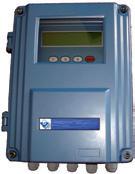


• MAGNETIC FLOW METERS
• ULTRASONIC METERS -TRANSIT TIME / DOPPLER
• OPEN CHANNEL
• CUSTOM SPOOL SYSTEMS FLOW METERS

NEW CRONOS ECONOMY ANALYTICAL CONTROLLERS
• BIOFILM ANALYSER
• RESIDUAL CHLORINE
• DISSOLVED OZONE
• DISSOLVED OXYGEN
• TURBIDITY
simultaneously by advanced technologies (remote monitoring and controlling devices, distributed power generation, data processing analytics, etc.) and growingly digitally equipped customer groups who desire to be better informed and have more control over the energies consumed. These changes will bring about new challenges and opportunities for utilities, calling for innovation and reform, and will ultimately lead to the development of business models and cultural changes at power utilities in order to remain viable and generate consistent profitability.
1 The term is used to describe the unnecessary investment made in improving the network infrastructure, instead of making an investment based on realistic evaluation of combined factors, including the network condition and actual demand.
2 Extracted from Page 64, Table 6.2 Our Response to Your Feedback, Regulatory Proposal 2016-2020, CitiPower.

• SUSPENDED SOLIDS
• PH/ORP
• CONDUCTIVITY
• FLUORIDE
sales@bintech.com.au

• ULTRASONIC TRANSMITTERS AND CONTROLLERS
• POINT LEVEL SWITCHES
• MAGNETIC LEVEL GAUGES
• SLUDGE LEVEL SYSTEMS
• WIRELESS SYSTEMS LEVEL SYSTEMS
www.bintech.com.au
TOLL FREE 1300 363 163
NEW!
ANALYTICALCONTROLLERS
ENERGY NETWORKS 68

WE’VE GOT WHAT YOU NEED. WHENEVER YOU NEED IT.
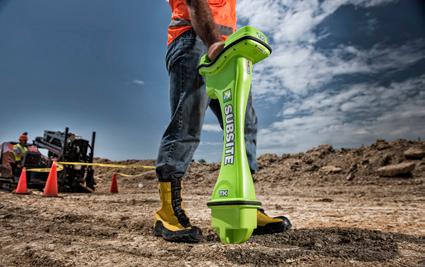

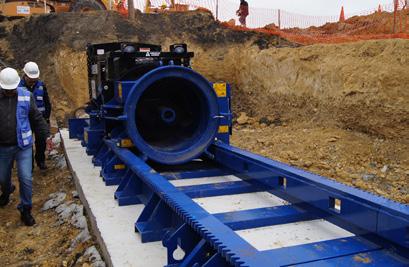
At Ditch Witch®, we focus on one thing: underground construction. Our entire product line-up is designed to make you more efficient and profitable in the field. Plus, with locations throughout Australia and New Zealand, you’re never far from the gear you need, when you need it. One company. One account. One-way path to success. WE’RE IN THIS TOGETHER.

©2016 The Charles Machine Works, Inc. Ditch Witch Australia // 02 4777 7115 Ditch Witch New Zealand // 0800 396 9583
LEVELLING THE PLAYING FIELD FOR LOCAL ENERGY THROUGH TARIFF REFORM
by Alison Atherton, Jay Rutovitz, Edward Langham, Lawrence McIntosh and Sven Teske, Institute for Sustainable Futures, University of Technology Sydney
The electricity market is changing as technologies like solar panels and battery storage improve and become more affordable. Widespread uptake of battery storage now seems to be a question of when, not if. Many consumers are interested in not only using electricity, but trading with the grid and with each other, becoming prosumers who generate some or all of their own electricity and sell the excess back into the market.
Improving the business case for small-scale, embedded electricity generators to sell electricity locally, by offering innovative tariffs and billing arrangements, could unlock substantial new clean energy potential and reduce the negative impacts of customers taking their load off the grid. To give an example, small to medium businesses (such as local councils or universities) may want to generate electricity at a site with a suitable renewable energy resource, and use it at another of their nearby sites with high electricity demand, using only a small proportion of the distribution network.
Network businesses do not currently offer tariffs to reflect limited use of the system to transport electricity between nearby sites, saving future network costs by reducing use of the upper levels of the grid. Nearby sites may be as close as two metering points in the same building, or across two sides of a road. Electricity retailers do not routinely offer the capability to ‘net off’ energy generated at one site at one or multiple other sites. This means that local generation is sized to match the lowest on-site electrical load to minimise grid exports, reducing economies of scale and operating efficiency. There are plenty of examples of cogeneration plants that are undersized or under-operated because of the need to restrict operation to match on-site electrical load.
Current incentives encourage local generators to keep consumption behind the meter (load defection), or even disconnect from the grid through building a private wire (a duplicate, privately owned, distribution line connecting one or more assets) to avoid using the existing electricity network. If less electricity flows through the network, the relative cost of network electricity will rise for the customers who are unable to generate their own electricity. This will further incentivise defection from the network, reinforcing the cycle.
The Institute for Sustainable Futures at the University of Technology Sydney is leading a project, funded by the Australian Renewable Energy Agency (ARENA) and other partners, that brings together consumers, researchers, electricity providers and government to help level the playing field for local energy generation, and prepare for the
electricity grid of the future. The project is researching the impacts of paying credits to local generators to reflect their long-term impact in reducing future network costs, and Local Electricity Trading (LET, also known as Virtual Net Metering) between associated customers and generators in the same local distribution area. The centrepiece of the research is five ‘virtual trials’ of Local Generation Network Credits (LGNCs) and LET in New South Wales, Victoria and Queensland, which are currently nearing completion.
THE TRIALS
The research project has also undertaken extensive background research and stakeholder consultation. The results of the trials will feed directly into the Australian Energy Market Commission’s (AEMC) consultation on a request for a rule change on LGNCs. The project will provide case study evidence for a LGNC, a recommended LGNC methodology, and economic modelling of the effect on consumers. It is the first time LGNCs have been tested in this way in the Australian market.
At the time of writing, four out of the five virtual trials are nearly complete and the story they tell is clear. Business as usual, with no change to the status quo, is the financial worst case scenario for embedded generators, and they are incentivised to keep generation behind the meter, or to install private wires which take large elements of load offgrid. Network businesses will need to work together with local generators to agree on business models that meet customer needs and ensure better outcomes.
The private wire scenario generally represents the worst scenario for the network businesses and retailers, and the loss of revenue to the utilities is not reflected in the benefit to the consumer. This is not that surprising, as reduced payments to the utilities are simply funding an inefficient duplication of existing infrastructure. In this scenario, network costs for other consumers are likely to rise as fixed network costs are recouped from a smaller number of consumers.
While the introduction of local generation network credits
70
ENERGY NETWORKS
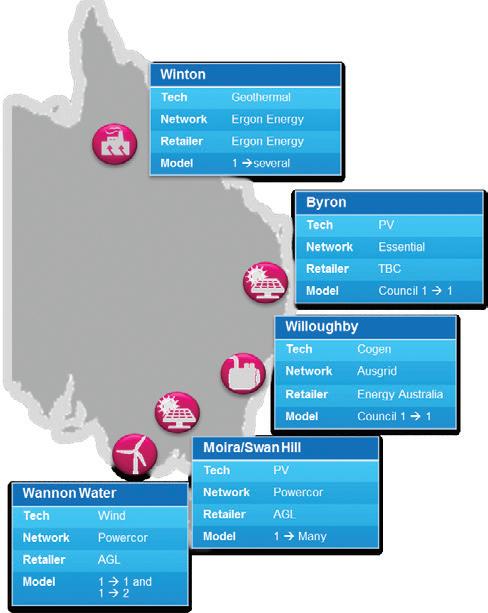
THE FIVE ‘VIRTUAL TRIALS’ OF LOCAL GENERATION NETWORK CREDITS AND LET HAPPENING AROUND AUSTRALIA.
will mean reduced payments to network businesses, they offer the opportunity to maintain network utilisation and ultimately result in more modest reductions in network revenue – and associated rises in customer costs – than in the alternative private wire scenarios.
Detailed results from the trials will be available during May, from the project website, http://bit.do/Local-Energy In the long run, by reducing underlying demand, embedded generation should reduce overall network costs by reducing augmentation, operational and replacement costs.
LET may offer opportunities for retailers to differentiate as new business models and products evolve, and it may boost customer retention in a climate where engaged customers are demanding greater choice and control over sourcing their energy supply.
LGNCs will more fairly reflect the impact of local generation and consumption on the electricity network. Combined with the ability offered by LET to net off electricity at other sites, it will incentivise local generators to keep utilising the grid, which in the long term is the preferred outcome for everyone.
Alison Atherton, Jay Rutovitz, Edward Langham, Lawrence McIntosh and Sven Teske at the Institute for Sustainable Futures are the authors of this article. We would like to thank all our project partners for their hard work and input on the project but any views in this article are ISF’s alone.

OUR RANGE:
www.tmc.com.au
Transformers Manufacturing Company Pty Ltd
19 Ewing Street, Brunswick VIC 3056
T: +613 9356 8700 F: +613 9356 8701
Email: tmc@tmc.com.au
Ӏ Power up to 20MVA
Ӏ Voltages up to 66kV 325kV BIL
Ӏ Indoor / Outdoor
Ӏ IP00, IP21, IP33, IP43, IP65
Ӏ Insulation Class F / Class H
Ӏ Natural or Forced Cooling
Ӏ Off load, Manual or On-Load Tap Changers
Ӏ Multi-Winding Custom Designs
Designed and Built in AUSTRALIA
Ӏ Special Purpose Transformers e.g. rectifier, furnace, phase shifting, tuning coupling, etc.

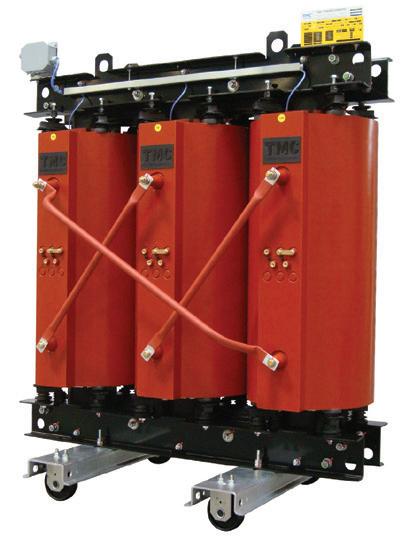
TMC manufactures premium quality dry type, vacuum cast resin and oil cooled transformers and reactors for the power, building, transport and mining industries at its facilities in Melbourne, AUS.
71
ENERGY NETWORKS
PROACTIVELY MANAGING NETWORKS
As
technology advances and network capabilities increase, we’ve seen a great deal of change in the technology that utilities can use to monitor their electrical networks. Now, utilities have access to data that allows them to be proactive rather than reactive to their ever-changing requirements.
While kiosk transformers have a raft of expensive (and in some cases less than specifically designed) transformer monitoring options, with pole top distribution transformers, traditionally the only monitoring available was via an analogue maximum demand indicator (MDI). As standard the MDI was mounted up the pole close to the transformer and only had its reading taken when crew were available to visually take a reading and reset the unit. This single or three phase device only gives one maximum demand current indication that happened sometime between when it was last reset and the time the reading was taken.
Then came the electronic maximum demand indicator (eMDI). This device is solar powered with three phase current connections (via split core current transformers), recording data such as minimum, maximum and average current; transformer temperature; and ambient temperature. The eMDI utilises drive-by wireless data download, and can store up to two years worth of data at ten minute intervals. The eMDI has operated on the Australian electricity network since 2012.
The next development in distribution transformer monitoring came from WF Energy Controls, in the form of the AM10. This device is an asset management tool designed
specifically to monitor kiosk and pole top transformers, with a reference to voltage, current and temperature. The device can record and display voltage, current, voltage unbalance, power factor, frequency, sag/swell, harmonics to the 32nd harmonic, THD, phase angle and two temperatures.
Connecting directly to the transformer for voltage, the current connections can be via the existing current transformers (CTs), split core CTs or Rogowski coils.
The transformer temperature sensors are easy to install, using a magnet. The Rogowski option is preferred by many utilities for the ease of retrofitting where there are no in-situ CTs available and space is tight.
The most recent iteration of the AM10, the PAM10 (pole asset manager) is a pole top mounted transformer monitoring device, especially developed for pole top applications, housed in an IP65 slim line discreet enclosure.
The PAM10 has Rogowski or CT input, with 3G and wi-fi comms and voltage input directly or via a voltage transformer. The device measures, monitors and records voltage, current, frequency, harmonics, THD, power, power factor, phase angle, voltage unbalances, transformer and ambient temperature and more. This device is due for release in June 2016 and utilises the same RPMS management software also available from WF Energy Controls.

THE AM10, FROM WF ENERGY CONTROLS.
Key benefits of the WF Energy Controls distribution transformer monitors include:
• The eMDI is a simple, solar powered device with easy drive by communications that provides considerably more data than traditional analogue MDIs
• The AM10 records large amounts of annual profile data for a range of sites, and with 3G communications, it’s a powerful device that can quickly add a lot of value to the network
• Both devices are compact and purpose built with inbuilt communications, transformer and ambient temperature monitoring
• RPMS software is available to enhance the reporting of the data and more importantly to make better decisions about network assets.
72
WF Energy Controls is a privately-owned company specialising in the design and manufacture of current and voltage transformers for the low to medium voltage electrical industry. Based in Sydney, NSW, WF Energy Controls supply network and electric companies worldwide. For more information visit www.wfenergycontrols.com.au or phone 1300 665 374. ENERGY NETWORKS
Registration
Now Open
Enquire today about Exhibition and Sponsorship opportunities.
ENA invites your business to participate as a Sponsor or Exhibitor in the only national Conference and Exhibition developed by the industry for the industry.
Join the industry’s leading asset, technology and service providers by becoming an exhibitor or sponsor at Energy Networks 2016.
Additional features in 2016 include an Operational Best Practice Workshop for network business line managers and technical staff and a Product and Service Demonstration Area. The ENA will again be holding a Meet the Industry Breakfast which was successfully introduced in 2014.
Don’t miss out on this opportunity to put your brand in front of key industry players and decision-makers.
Energy in Transition
For all sponsorship and exhibition queries, visit the Sponsorship and Exhibition page of the website or call Helen McGowan at the Conference and Exhibition Office on D: +61 3 9907 8628 or E: Helen@wsm.com.au
W: www.energynetworks2016.com.au




www.energynetworks2016.com.au @EN_2016
Affiliated Partner
Silver Sponsor
Badge and Laynard Sponsor Media Affiliate Media Affiliate Media
Platinum Sponsor – Social Name
Partner Espresso Bar Sponsor Satchel Sponsor
EV2G – IMMINENT REALITY OR ELECTRIC FICTION?
by Tim Dixon, Manager, Australian Energy Research Institute (AERI)

It was only a few short years ago that the idea of producing your own free, clean energy during the day, and storing that electricity in your car for use overnight, either locally or in the grid, was the realm of pure science fiction. But the increasing popularity and storage capacities of electric vehicles, combined with drastically reduced solar photovoltaic costs, could turn that fiction into a reality.
The potential for electric vehicles (EVs) to replace dirty, CO2 emitting internal combustion engines (ICEs) has been recognised for decades and remains the main goal of the technology, with a growing impetus to curb man-made climate change hastening development of EV technology and market adoption.
Although EV batteries (as opposed to electric motors) are still in their relative technological infancy, cars such as the Tesla Model S and BMW i3 have proven that driving an electric vehicle doesn’t have to be a story of personal sacrifice for the sake of saving the environment (or giving the finger to ‘big oil’). Drastically increased range and performance characteristics comparable with ICE
competitors have helped EVs to go increasingly mainstream, and while only currently enjoyed by a handful of early adopters, the predicted (some would say inevitable) technology cost reductions have the potential to rapidly hasten the uptake of zero emission EVs. (The missing piece of the puzzle in Australia is government incentives for EV uptake, but that’s a topic for another article.)
There are distinct challenges and opportunities for utilities in the future mass charging of EVs. While EV charging promises to be a large new source of electricity demand, uncontrolled charging could stretch or even break current infrastructure, in contrast to the belief held by many that the grid is gold-plated and
overcapitalised.
However, the reality of a future with higher uptake of EVs is more complicated than just the demand side of the equation. Beyond the ability of EVs to replace fossil fuel burning cars on our roads, it may be that the development of electric transportation could have the added benefit of helping to increase the amount of renewable energy that can be stored and used by car owners, and the grid.
As we all know, renewable energy has one major disadvantage over traditional forms of power generation such as coal, gas and nuclear: intermittency.
All forms of supply intermittency (whether short or longer term) make it difficult for grid operators to meet
STORAGE 74

demand, which is also highly variable and largely out of the control of utilities, even with the increasing application of demand response measures. One solution to smoothing the intermittency that characterises renewable generation is of course energy storage.
Energy storage has added benefits in that it can also be used for frequency regulation when the load diverges significantly from the available supply on the network, and can assist with network augmentation deferral and improving power quality.
However, while costs have come down significantly in recent years, augmenting households with solar photovoltaic (PV) installations – let alone entire networks – with storage is still an expensive and difficult proposition.
But as the broader energy storage revolution continues to edge towards economically viable and reliable utility-scale storage, many experts are examining the possibility of using EVs – which can be simply perceived as just large batteries on wheels – as energy storage devices for the grid (known
as EV2G for short). Indeed, some pilot projects on intelligent EV2G systems are already underway in the US, China and Europe.
The key to grid integration of EVbased storage is the aggregation of individual vehicles into a critical mass of total storage, with a combined capacity to palpably impact the grid. Individual storage capacities of single cars for grid integration are currently in the range of only 1 to 95kWh – or 0.2 to 19kW output over a five-hour discharge of full capacity.
However, there are many informational uncertainties and infrastructure voids which would need to be overcome to make EV2G feasible. Physical infrastructure in the form of a network of chargers in places such as car parks and workplaces will be required. These will take time to build and will be expensive to implement; however, it is likely that market forces alone should eventually provide this physical infrastructure as a response to greater EV uptake.
However, in addition to physical

infrastructure, EV2G systems will require significant informational infrastructure to operate. This will require the construction of a deep information layer, including data on individual EVs, their parking status, storage capability, power flows, state of charge, and the preferences and
STORAGE 75
A TESLA MODEL S PLUGGED IN AND CHARGING.

ELECTRIC VEHICLES AND CHARGERS ON THE UNSW KENSINGTON CAMPUS.
constraints of car owners – and these are just some of the datasets required to effectively realise EV2G.
The maintenance and development of this infrastructure will likely fall to a new form of enterprise – a storage aggregator – which will develop and maintain battery management systems and user interfaces, information collection and distribution, and control of charging/discharging of EVs based on, for example, market signals from the National Electricity Market (NEM).
But before we get too carried away, it is pertinent to ask a slightly more basic question about using EVs as batteries for the grid or the home: should, and would, we do it?
It must be remembered that –currently at least – electric cars, like their ICE predecessors, are built and marketed as a personal transportation solution, not a personal (or communal) energy storage solution. They are simply not designed with EV2G functionality in mind.
To make an analogy, using a current generation EV as if it were a
grid-connected battery is akin to running the engine of your VW Golf, even when you are not driving it, for use as a diesel generator. Sure, you could provide some useful spinning reserve to either your home or the grid by doing this, but for obvious reasons, this is not a good idea on many levels – an ICE car is simply not designed for this type of usage and you would most certainly kill the motor in short measure, all the while voiding the manufacturer’s warranty. The same is true for an electric car, where each charge/discharge cycle will reduce the life of its chemical batteries.
On top of that, there are also significant conversion losses of about 20 per cent in each direction (charge and discharge), adding further cost to the EV2G concept.
Aside from the physical and informational infrastructure needed to make EV2G a reality, it is essential that car makers themselves embrace the idea of using their vehicles as multipurpose transport and energy storage devices. The most likely candidate to do this is Tesla, as it has expertise and
products in both home energy storage and EVs. Whether or not it makes business sense for Tesla to replace two of their current successful products (the Model S and the Powerwall) with a new do-it-all EV model is another matter. So while it is certainly an area worthy of further research and development, it is unlikely in our view that EVs will support grid or home energy needs in the foreseeable future (repurposing second-life EV batteries in the decades to come may prove to have more potential in this regard than actual, functioning vehicles).
While it is tempting to think of EVs as giant batteries on wheels, they are designed for a completely different purpose, and this severely limits the feasibility of the EV2G concept, unless their design changes. Therefore, utilities are perhaps better served focusing on the demand side challenges generated by increased EV uptake into the future.
STORAGE 76 EV2G – imminent reality or electric fiction?
Tim Dixon is the Manager of the Australian Energy Research Institute (AERI) at UNSW Australia. AERI is conducting research into the potential impacts of EV charging on future Australian electricity grids incorporating higher penetrations of renewable energy. Contact Tim at timothy.dixon@unsw.edu.au.

Which BESS configuration is right for you?
While industrial battery energy storage systems may seem modular like blocks, there is a real potential for failure if your system’s design is scaled incorrectly. Only industry experts can provide you with the clarity, information and expertise to deliver a reliable and compliant system.
Intelepower has been designing and building industrial DC power systems using leading quality practices to Australian standards and will incorporate all relevant details and requested features when building your new BESS system.
So if you need a reliable and compliant solution, contact Intelepower today.

ENERGY STORAGE: THE PATH TO REACHING CRITICAL MASS
In a very short space of time, energy storage has become one of the most critical topics facing energy utilities around the country. We caught up with Australian Energy Storage Council (ESC) Chief Executive John Grimes to hear his thoughts about how the industry is developing, and to gain insight into how utilities can work with this emerging technology, rather than against it.
It’s been a busy 12 months since the ESC launched last year. Can you tell us about some of the biggest changes the storage industry has seen over that time period?
The past year has been all about laying the foundations for a successful, long-term energy storage industry.
We have worked with the industry and government to develop standards and guidelines to make sure energy storage products are inherently safe, installed professionally, and deliver the performance consumers expect.
Another focus has been consumer engagement. It is important that consumers are given clear, factually correct information on competing systems so they can make an informed buying decision. Consumers also need realistic expectations on what impact energy storage technology will have on them financially. The energy storage industry has invested a considerable amount of time this year in providing clear, unbiased and useful advice to consumers.
We are committed to a fair and competitive electricity market. Influencing market rules has been another key focus, to ensure consumers can use this new technology to their financial advantage, and our members are not ‘locked out’ of driving innovation in the energy sector.
Australia is now one of the top five distributed energy storage markets in the world. Why do you think the uptake of storage technologies has been so rapid here?
Australia will be the first major developed economy in the world where behind-the-meter household energy storage will make economic sense.
Electricity costs in Australia are high. Over 1.5 million Australian homes have solar PV on their rooftops. And premium feed in tariffs in New South Wales, Victoria and South Australia are all coming to an end. Combined with very low feed in tariffs paid in the future, all of the ingredients are ripe for an explosion of behind-the-meter energy storage systems.
Imagine this as a typical scenario. A householder installed 7kW solar PV in New South Wales at the beginning of the premium solar feed in tariff ($0.60c/ kWh). Their system is now well and truly paid off. But they work during the day. So they are exporting two thirds of their solar production to the grid, for which they are paid $0.06c/kWh.
There are two options. Be paid a pittance or install a battery that will collect your excess solar energy during the day and make it available at nighttime. In the customer’s mind the solar energy is free. The system has been paid off. So, the only cost is in the battery system, and if the cost of the batteries is less than say, $0.35 per kWh, they would be crazy not to do it.
And today, we have a suite of members who can provide home-based batteries at well below this cost. That in turn will create economies of scale in the energy storage market in Australia. Just as we saw with solar PV, as you drive economies of scale, prices reduce accordingly.
And of course Australia does not live in a bubble. The rapid market uptake of electric vehicles globally will also drive competition and economies of scale in this market. China alone has a target of ten million electric vehicles by 2020. That’s two million vehicles (read vehicle
 JOHN GRIMES.
JOHN GRIMES.
batteries) that need to be produced every year between now and 2020. And that is just one market.
So it is probably only a two-year cycle from where we are today to the start of mass-market demand for this technology.
What advice do you have for utilities who are working on the integration of solar and storage into their existing operations?
Innovation disruptive technology is not new. We see it in nearly every aspect of our lives. The energy sector, however, has not seen disruption for the past 80 or 100 years. Monopoly or semi-monopoly players provided the essential service of energy on behalf of the community.
Today new technology literally puts power into the hands of the people.
Attempts to stop the uptake of energy storage are likely to have the reverse effect. Australians feel frustrated and disenfranchised when it comes to energy. And rising power bills exacerbate the problem.
So as draconian policies are put in place, customers respond emotionally, and it intensifies their interest in becoming more self-sufficient.
Most utilities are in serious danger of turning their customers into their competitors.
You can’t outrun the market. The only solution for the energy sector is to embrace this new technology and become an energy partner working with customers, not against them, to get the best outcome for them.
STORAGE 78
For energy companies that believe they are the centre of the energy market, and ignore or punish their customers, their long-term commercial success will not be assured. They will not survive.
What are utilities doing well when it comes to the integration of storage technologies? What could utilities do better?
Utility interest remains focused on ‘trial’ applications. They are finding strong commercial and technical applications at fringe of grid, and in off-grid applications. They are not seeing strong drivers for large scale on grid energy storage use in the traditional network, although niche markets do exist, particularly in working with renewable energy assets like wind.
Those who are looking at domestic behind-the-meter solutions are being swamped with customer interest and enquiries. Most have not yet figured out a business model to allow them to profit in this sector.
Those who do, however, will be the market disruptors for the energy market in the same way that Uber disrupted the taxi industry.

What role is the grid going to play in Australia’s future electricity landscape?
The grid is good. The grid is an important community asset. It is imperative now that we imagine the grid of the near future.
Increasingly, this grid will be bidirectional, service a wide range of small distributed generation assets (read solar PV systems), and be driven by data and complex algorithms (i.e. it will be smart).
Imagine the future where the grid facilitated ‘peer-to-peer’ electricity transactions. One neighbour, selling another neighbour excess solar power during the day. A community selling solar power to the local supermarket.
Now, think of the grid as the telecommunications backbone of the internet.
If a grid operator could not make money by charging a transaction fee for every electricity transaction that they facilitate, then they should simply not be in business.
The world’s best investor Warren Buffett recently said that energy sector disruption will result in the largest transfer of wealth ever in the history of the world.


Warren Buffett is right.
What are your predictions for the next 12 months in the storage space?
The last year was about laying foundations. This year is about starting to build the infrastructure.
We will see domestic energy storage system sales go from around 200 per month to 1,000 a month or more.
And then we will start to hit a critical mass.
When neighbours in the suburbs talked over the back fence, and one told the other about how much their solar PV system had slashed their power bill, solar sales skyrocketed.
The next neighbourhood conversation about home-based batteries will have exactly the same impact. “Can you believe that I am now 80 per cent self-sufficient in power?” Then the market really moves.
But at the same time the future is not inevitable. What path we head down will have implications for us locally. And the rest of the world will be watching.



STORAGE Australia’s most advanced HDD contractor... AHD Delivers, every time • Experienced staff • The latest equipment • Technologically innovative T: (03) 9439 93 73 W: www.ahdtrenchless.com.au

What will drive
THE POWER
Mark Coughlin, PwC Australia’s energy, utilities and mining leader, examines the forces set to shape the power utilities sector in 2016.
DISTRIBUTED GENERATION 80
SECTOR IN 2016?

When the Prime Minister last year said “There has never been a more exciting time to be an Australian,” he could have extended that to say “an Australian energy provider”.
Never before has the industry experienced such a convergence of change. Climate change, asset sales, new technology, regulatory scrutiny, evolving customer expectations – the list goes on.
At a more granular level there are also market forces bringing changes forward to today that many in the industry didn’t expect to see for a decade or longer.
When we published Utility of the Future – an Australian Context in 2014 we had some very robust discussions with the ‘flat earth society’ that change was coming quickly and that the industry was not doing enough to respond. Many of our predictions have been correct, but they happened much more quickly than we expected. The pace of change is extraordinary, and historically, rapid change isn’t something the sector has had to deal with. Moving too slowly now has become a major strategic risk.
Recent PwC research with global energy company CEOs told us that the largest shapers of strategy in the sector are governments, regulators
and customers. That might seem obvious, but the point here is the rapid increase of the impact of the customer in this conversation. Historically, the biggest influencers of strategy were policymakers and regulators, with customers a very distant third.
A huge leap in thinking had occurred, with many in the sector now acknowledging that customers are more important than the engineering and technical elements of their business. This shift in thinking will provide the platform for future success, and already we are seeing examples of how the sector is looking to put meat on the bones of this customer-centric rhetoric.
For example, the popularity of distributed generation continues unabated. Distributed generation, including solar photovoltaic (PV), is now present on more than 1.3 million Australian homes, with capacity now outstripping that of major power plants. The removal of government subsidies has also been offset by economies of scale driving down costs. We don’t see the uptake of distributed generation slowing.
Energy storage is rapidly becoming an economic option in more than just niche applications. This factor alone has the potential to change one of the fundamental assumptions
DISTRIBUTED GENERATION
81

DISTRIBUTED GENERATION, INCLUDING SOLAR PV, IS NOW PRESENT ON MORE THAN 1.3 MILLION AUSTRALIAN HOMES, WITH CAPACITY NOW OUTSTRIPPING THAT OF MAJOR POWER PLANTS.
underlying power market and power system design: that electricity cannot be stored. We see the conversation shifting within energy companies that have traditionally had a monopolistic view on the world – the customer is now a competitor and challenging the monopoly. What is really exciting is that many companies are working through how they can best capitalise on this and create new value streams. The question is whether market structures are ready to cope with this important development.
As battery storage technology becomes more commercially viable, customers will be able to combine solar PV generation and storage, enabling them to offset usage during peak tariff periods, rectifying the current symmetry between solar generation and energy consumption patterns. We expect to see moves to better price signals in time-of-use tariffs for residential customers, and some very innovative commercial arrangements for business customers. We have just seen major industrial players make announcements on how they are planning to enter the energy market as a participant.
So what does all this change
mean for the sector and, more importantly, what will it take to thrive in this environment? What role will government, regulators and other stakeholders play?
For the innovative and brave, there will be more opportunities than risks in the current and future energy market. The measure of success will be the development of good business strategies and their successful execution. The normal drivers of business will apply.
In our view, the key to transforming Australia’s energy sector and setting it up for long-term success will depend on number variables.
From a legislative perspective, it is absolutely crucial that we develop a stable long-term government energy policy and associated 21st century regulatory framework. How close we are on either is widely debated. We must establish a truly deregulated and open national electricity supply and services market. The world is looking at how Australia deals with the challenging energy market conditions in my old home state of South Australia.
The suppliers that will thrive will be those which put their customers’ needs at the centre of their organisation. This
means developing excellent customer understanding, with a particular emphasis on the power of social media to underpin new customer-centric corporate strategies.
Customers are now also creating vast amounts of data which can be used to refine offers, incentives and strategies – competitive advantage will flow to those who create value from the data they have, and deploy data management and analytics tools to support management decisions.
Utility companies should be the leaders in the technology revolution, rather than followers – technology will be the platform through which new, more flexible business models can be launched. The additional benefit of leveraging technology is that it will ultimately give customers what they are looking for – choice and flexibility.
Industry participants who succeed over the next decade will not be the ones who blame the market or external events. It will be those that influence the agenda and who best respond to the ever-changing needs of customers. These are core capabilities for the Utility of the Future.
82
DISTRIBUTED GENERATION









› ATTEND free battery workshops in the Exhibition Hall
› EXPLORE EV & Charging and Emergent Technologies Zones
› CONNECT with local and global industry leaders and build your professional network
CO-LOCATED WITH 2000+ 45+ 40+ 06 02 ZONES [
+ EMERGENT
] FREE BATTERY
IN THE EXHIBITION HALL
SHOWCASING
REGISTER NOW
EV & CHARGING
TECHNOLOGIES
WORKSHOPS
TRADE EXHIBITORS
INNOVATIONS INTERNATIONAL AND NATIONAL SPEAKERS TRADE VISITORS AND CONFERENCE DELEGATES
DIGITAL UTILITIES:
by Simon Mezger, Strategy Utilities Lead for Australia and New Zealand, Accenture
Ensuring customer satisfaction is a constant and ongoing challenge for Australian utilities. When customers have access to many services that enable them to quickly and easily switch providers, what can utilities do to keep their customers and reduce the churn?
In an industry where consumers spend just five minutes on average selecting their utilities provider, it’s hard to imagine what impact changes such as digital disruption and the Internet of Things are having on the way utilities do business. Yet Accenture’s recent Re-energising the New Energy Consumer global survey found that 42 per cent of digital energy users would be willing to recommend or promote their energy provider, as opposed to just 13 per cent of nondigital users. The survey also found a steady shift in preference towards a ‘service-first’ consumer experience, with 69 per cent of consumers who have digital energy providers claiming they felt satisfied with their service, over 55 per cent without. So what does this mean for the providers of today?
Where they could once rely on predictable market conditions, the same businesses are now facing unprecedented upheaval both from

within their business and from new non-traditional market entrants. To meet growing customer expectations for digital, while successfully maintaining loyalty and growth, utility companies are now making key strategic choices about the future markets they want to play in, and what they’ll need to develop, borrow or acquire in order to compete. Accenture’s experience suggests utilities can strike the balance between digital innovation and customer satisfaction in a number of ways.
DIGITAL REVOLUTION
In the last few years, retailers have embraced the need to provide a similar level of digital ‘front-end’ engagement and interaction as banks, telcos, ISPs and other service providers central to daily life. Having made sizeable inroads in this space to meet the digitally savvy consumer, many providers are undertaking a digital transformation
to simplify their operations. It’s early days for many of the traditional incumbents, as they seek to shed their ‘cost to serve’ and create low-price customer propositions with increased transparency and efficiency. In the US, prior to being bought by Direct Energy in 2013, Bounce Energy was a small energy retailer from Texas with approximately 57,000 consumers, almost all of whom initially signed up for the service online between 2008 to 2012. However, unlike many energy retailers at the time, Bounce allowed its consumers to build their own energy plan, selecting from a range of options described online which enabled consumers to choose the length of their plan, how much renewable energy they wanted in the mix and how they wanted to be billed.
This shift in mindset drew Direct Energy to spend $US46 million to acquire Bounce and with it, its entire online consumer base. Not only did

84
M2M AND MOBILITY
SIMON MEZGER.
ADAPTING TO CONSUMER EXPECTATIONS AND OPERATIONAL REALITIES

SMART UTILITIES HAVE EMBRACED THE NEED TO PROVIDE CUSTOMERS WITH A HIGH LEVEL OF DIGITAL FRONT-END ENGAGEMENT.
M2M AND MOBILITY
the acquisition allow Direct Energy to significantly grow their immediate market base, but more importantly, they positioned themselves as a digital low cost, commodity player in the market. Locally Powershop, owned by New Zealand utilities player Meridien, has positioned itself as a completely online offering. As one of the tier-two retailers who have been more recently established, Powershop has not had to deal with legacy operations that were more manual in nature. Larger retailers are also moving, albeit at a slower pace, to digitise their historically ‘analogue’ back-of-house operations (e.g. sizeable contact centres, billing, credit and collections etc.) having built their customer facing digital experience – but this is no small feat. Running low-cost digital operations will ultimately be a matter of survival for retailers who are faced with multiple threats from new entrants, changing customer energy preferences and choices (solar, storage, non-traditional product bundling, peer-to-peer trading, etc.) and
a desire for new energy services. These customer-led changes are splintering the traditional service offerings, with new derivatives and value propositions being launched all the time. Offering a seamless ‘front of house’ experience is almost becoming table stakes, with the next frontier of digital reform to drive out costs coming from operations.
UTILITIES AS A PLATFORM
For some providers, their entire core offering model has changed. They no longer see themselves as a commodity provider, but rather a personalised service offering that is tailored to a consumer’s lifestyle and a platform for service integration. This is being done through the adoption of a ‘beyond the meter’ service mindset, that creates deeper relationships with the consumer and new value pools. These utility providers are looking to create a platform on which others can also build new applications and services that will drive greater customer loyalty and lock-in and improved margins.
Power Peers, an innovative business due to launch in 2016 by Nuon, under the Vattenfall umbrella, is one of the first clean energy sharing companies that has adopted a renewable peer-to-peer sharing model in the electricity space. Customers are now empowered to leverage digital, through interacting in what is essentially a marketplace for energy sharing between consumers and between providers and consumers, where they can trade energy based on usage requirements. One can imagine once it has built its own customer database, consumers and service providers will want to connect into this platform that effectively disintermediates traditional retailers. Similarly, Canberra-based startup Reposit Power gives owners of solar panels and storage batteries the ability to use GridCredits software developed by the company to use or trade their stored energy as it suits them. As a result, the introduction of ‘choice’ in this sector is not only de-commoditising energy from a consumer perspective, but also implies
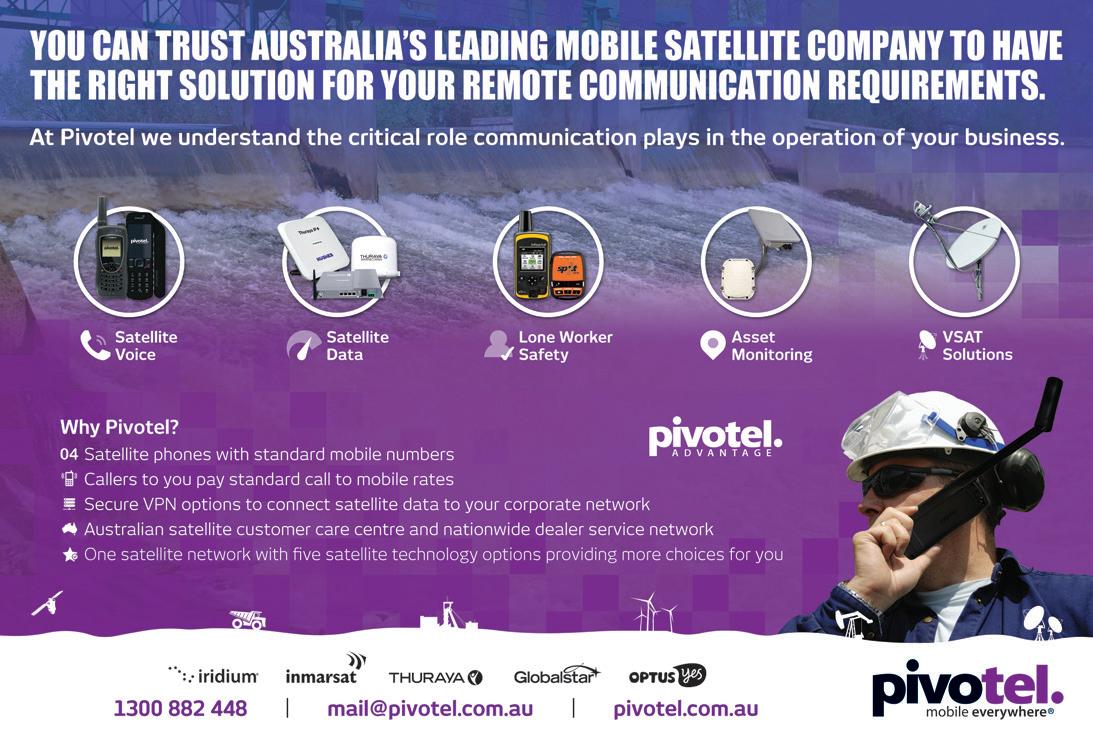
M2M AND MOBILITY 86
a fundamental shift in the strategy, brand differentiation and digital engagement model of energy providers in the market.
And these advancements are transcending local borders and having global impacts. In the Netherlands, TOON is a platform provided by incumbent utility Eneco. It offers Eneco’s customers the opportunity to manage their gas and electricity use through intuitive data visualisation. The platform is also giving other companies the ability to develop and launch apps that can be used for a variety of connected home capabilities, such as lighting, security, electric vehicle charging, carbon monoxide alerts, supply interruption alerts and information about solar panel performance. This is not only a fundamental centralisation of convenience for their consumers, but also a key differentiation factor and source of competitive advantage for Eneco.
There are also other platforms that are helping consumers and small producers to reinvent the way that energy is




used. Flextricity in the United Kingdom allows for companies to trade excess capacity and manage demand response to optimise prices in real-time for their energy at a household or company level. They do this through aggregating different sources of energy generation and using demand response to make use of spare capacity across a range of generation sources. This not only means consumers have greater access to services and more competitive pricing than ever before, but it’s also a critical shift in mindset on how to leverage digital disruption for innovation and resourcefulness within utilities and the ‘as-a-service’ model.
While these may just be a select number of examples that leading utilities are pursuing today, the key to survival will be to enhance consumer experience through inherent or acquired digitisation and embrace a shift to the ‘as-a-service’ mindset. While it may be easy to dismiss some of the more ‘bleeding edge’ developments as fads, incumbent



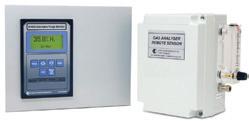
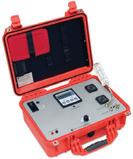




retailers and other hopeful market participants will do well to answer the following questions:
• What opportunities are there to fundamentally reduce cost to serve by digitising back-of-house operations?
• What local and global emerging business models are likely to be winners and why? What is my strategy and how does digital play a role?
• Which non-traditional market entrants have the potential and interest in disrupting the value chain with ‘over the top’ plays?
And with only five minutes to leave your mark per customer, it’s better to act late than never at all.





Simon Mezger is the Accenture Strategy Utilities Lead for Australia and New Zealand. NSW Ph: 02 9911 6615 WA Ph: 08 9201 0984 QLD Ph: 07 3387 7706 SA Ph: 08 7221 2205 Head Office: Unit 20, 51 Kalman Drv Boronia VIC 3155 Ph: 03 9017 8225 Fax: 03 9729 9604 www.ams-ic.com.au sales@ams-ic.com.au AMS Instrumentation & Calibration Pty Ltd Analytical Process Division Oxygen Analysers, Thermal Conductivity Analysers, NDIR Analysers, Multigas Analysers, OEM Analysers U.V Absorption Conductivity pH / ORP Colour Industrial Water Analysers and Liquid Analytical Products (pH, Conductivity, ORP, Dissolved Oxygen, etc) Oxygen Analysers, Relative Humidity Sensors and Meters, Dewpoint Measurement M2M AND MOBILITY 87
TAKING THE FIRST STEP TOWARDS SMARTER MOBILITY: MAKING UTILITY SERVICE MORE RELIABLE
Rugged tablets power real-time responsiveness, feature future-proof connectivity standards
by Brett Gross, Director of Sales AU-NZ, Xplore
Power, gas, water, and telecom utilities are responsible for one of the most mobile workforces in the world. In fact, Navigant Research expects there to be more than 2.4 million mobile utility workers worldwide by 2020, up from 1.2 million in 2013. That’s double the number of field technicians and supervisors who will need access to critical workflow applications and real-time communications while on four wheels or foot in some of the most remote locations on Earth.
Many utilities today still rely on paper-based processes or fixed computers to manage the majority of their business operations – not just in the office, but from the field as well. Such antiquated systems are not conducive to tackling the challenging environment many global utilities operate in today.
Rugged tablets consistently provide the right balance of reliable, real-time business intelligence. Rugged tablets prove time and again during extensive field testing and realworld evaluation that they are the only mobile PC form factor capable of delivering the real-time data and long-term reliability that modern utility operations demand. They’re also the first –and only – truly mobile PC to meet new connectivity standards designed to improve field service responsiveness.
For years, rugged tablets have undoubtedly demonstrated their durability and speedy performance under pressure, and newly introduced rugged tablet generations are even better equipped to support both planned and unplanned field work. Many come standard with up to 20 hours of battery life; 10 inch-plus outdoor viewable screens; 4G LTE and Wi-Fi connectivity; and multiple built-in, weather-proof input/output (I/O) ports. Some rugged tablets even include up to eight critical test and connectivity ports to support RJ45 and True Serial cables, among other frequently used utility peripherals. Since all of the I/O ports are sealed against excessive water and dust penetration when closed and some even protect against the elements when port doors are open, utility field technicians can continue with their diagnostic and restoration activities uninterrupted during inclement weather. Whether dispatched to complete critical inspection, maintenance, or restoration work orders, rugged tablets will power along strongly even if dropped or exposed to frequent vibrations, high humidity, or extreme temperatures. Their physical attributes aren’t their only strengths, though. Rugged tablets’ internal security and multiple data
input methods facilitate real-time data capture, information access and work completion from any location in the field, in a vehicle, or in the office. They provide immediate access to applications and up-to-the-minute data, and they feature collaboration tools that expedite data sharing and decisionmaking capabilities among widely dispersed teams through digitiser pen input and full-screen digital documents (that replicate more traditional pen and paper forms). Many rugged tablets also feature high-res cameras, companion keyboards and both capacitive and resistive (glove) touch capabilities, while geo-tagging tools and integrated satellite GPS improve routing and GIS workflows.
Rugged tablets also boast some of the most powerful processors and expansive storage and cache size options on the market and remain compatible with a wide range of back office systems across multiple generations. This allows for the use of more custom software applications that mimic and extend utilities’ existing workflow documents into the mobile environment.
The best tablets offer backward and forward compatibility with accessories, as well as multiple secure transport options such as in-vehicle docks with one-hand release; shoulder and hand strap carrying options; and slip-free, moulded grips. This lowers the total cost of ownership (TCO) not just for the device itself, but for the entire mobile investment.
In short, rugged tablets are the only mobile devices genuinely designed to help utilities accomplish their mobility and business automation goals without compromising on screen size, connectivity, security, OS support, processing power, or rough handling survivability. However, rugged tablets are not the entire solution.
Rugged tablets are necessary, but not solely sufficient, for future-proofed mobility. Mobile workforce modernisation is not as simple as a widespread rugged tablet deployment. Yes, mobile technology can increase productivity and data accuracy, and the right mobile technology can keep your workers online no matter the weather, their working location, or work order requirements. However, mobile devices are just one part of the whole mobility solution – not the entire solution.
The best way to capitalise on the physical strength and internal power of these field-ready mobile computers is to identify custom software and service options that refine the rugged tablet’s skill set to your real-time business requirements. End-user training, feedback from the field and constant adaptation of the entire solution will ensure harmony between the hardware, software, and end users, ultimately driving widespread adoption and future-proof efficiency.
88 M2M AND MOBILITY
SMART MOBILITY

Xplore ® is the #1 provider of rugged tablets to the Utility market. * With nearly two decades of experience delivering purpose-built mobile tablet solutions, Xplore understands the unique demands of the utilities industry’s work environments. Mobile workers can experience full computing capabilities from the office, to the vehicle and into the field without interruption. Equipped with a full suite of accessories, integrated features and in-vehicle solutions, Xplore rugged tablets help deliver excellent customer service to the end user by improving productivity and enabling real-time decision making at the point of service with features including:




For more information on the most robust line of tablet PCs for mobile professionals, contact us on 1300 654 978 , email lpeterson@xploretech.com.


www.xploretech.com/utilities | Call: 1300 654 978 RUGGED TABLET TECHNOLOGY WITH TM * Source: VDC Report, 2014 POWER
Real-time Data Transmission Long Battery Life Sunlight Readable Display Light Weight Many Integrated Options
YOUR WORKFORCE
AIMING FOR THE HOLY GRAIL: PIPE CONDITION ASSESSMENT ALONG
A CRITICAL
MAIN FROM LIMITED INSPECTIONS
by Jaime Valls Miro and Lei Shi, University of Technology Sydney
The Advanced Condition Assessment and Pipe Failure Prediction Project is coming up with a novel condition assessment research concept: exploiting data-driven research to improve large critical water mains condition prediction, over extended sections of pipeline, from limited condition assessment inspection data.

The Advanced Condition Assessment and Pipe Failure Prediction Project (ACAPFPP) is an innovative collaboration of researchers and water utilities from around the globe, dedicated to solving a major problem – failures in ageing critical pipelines which deliver fresh water to the towns and cities of the world. Failures in critical pipes, generally exhibiting diameters greater than 300mm, present a major challenge to the cost effective management of water pipe assets. Targeting better renewals is essential to the success of the critical water main management framework.
Within the water industry, condition assessment (CA) prediction is mostly done by interpreting results between local excavation measurements using empirical and statistical estimation of extreme measurements (e.g. maximum pitting) with a considered high level of uncertainty. Currently, the only feasible alternative is to use significantly more costly internal direct measurement tools, yet the effectiveness of this approach has not been fully established within the industry, given the significant deployment and validation investment.
The aim of this research activity is to develop a framework for ‘along the pipe’ condition assessment prediction with an improved level of certainty given current and upcoming practices for CA available to the water industry. The current research strategy proposes the use of pipe condition data from targeted locally excavated inspections, possibly supplemented by additional screening information if and when reliably available. This conceptual framework is currently being investigated with data from the critical pipe networks of the ACAPFPP utility partners, and the engagement from a range of commercial CA vendors.
RESEARCH METHODOLOGY
Screening and local inspections
An example of the task to be addressed in this research is shown in Figure 1. On a buried pipeline, excavations are carried out at Sites 1 and 2, where the pipe is exposed, and local detailed CA inspections on these sites with tool A provide details of the pipe condition in the form of remaining wall thickness maps. It is often the case that some limited information could be made available from other sources (for example, a screening CA tool). For illustrative purposes, in the case depicted in Figure 1, a screening tool B is shown, which is assumed to provide average thickness values, while an intelligent soil monitoring system C is assumed to be able to infer minimum thickness in the adjacent pipe section from environmental measurements (soil moisture, etc).
The objective of the framework proposed in this research is to predict likely pipe conditions in the form of a thickness map at unseen sections of this pipeline, based on inspection outcomes from Site 1 and 2, with or without extra information provided by screening system B and/or C.
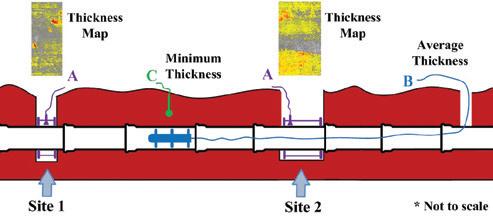
CONDITION ASSESSMENT
90
PREDICTION.
FIGURE 1. AN ILLUSTRATION OF DATA INSPECTIONS FOR IN-BETWEEN CA

Data correlation and machine learning
Data correlation plays a pivotal role in working with thickness maps and maximising the information gain from local inspections. It is intuitive that the condition of a pipe at a certain location has some dependencies on its nearby locations’ condition. We refer to such dependencies as spatial data correlation. The effect of data correlation is shown in Figure 2.
Describing data correlations in the condition of pipes in a one-size-fits-all manner is very difficult, maybe impossible. The main premise of this work is that this information, not
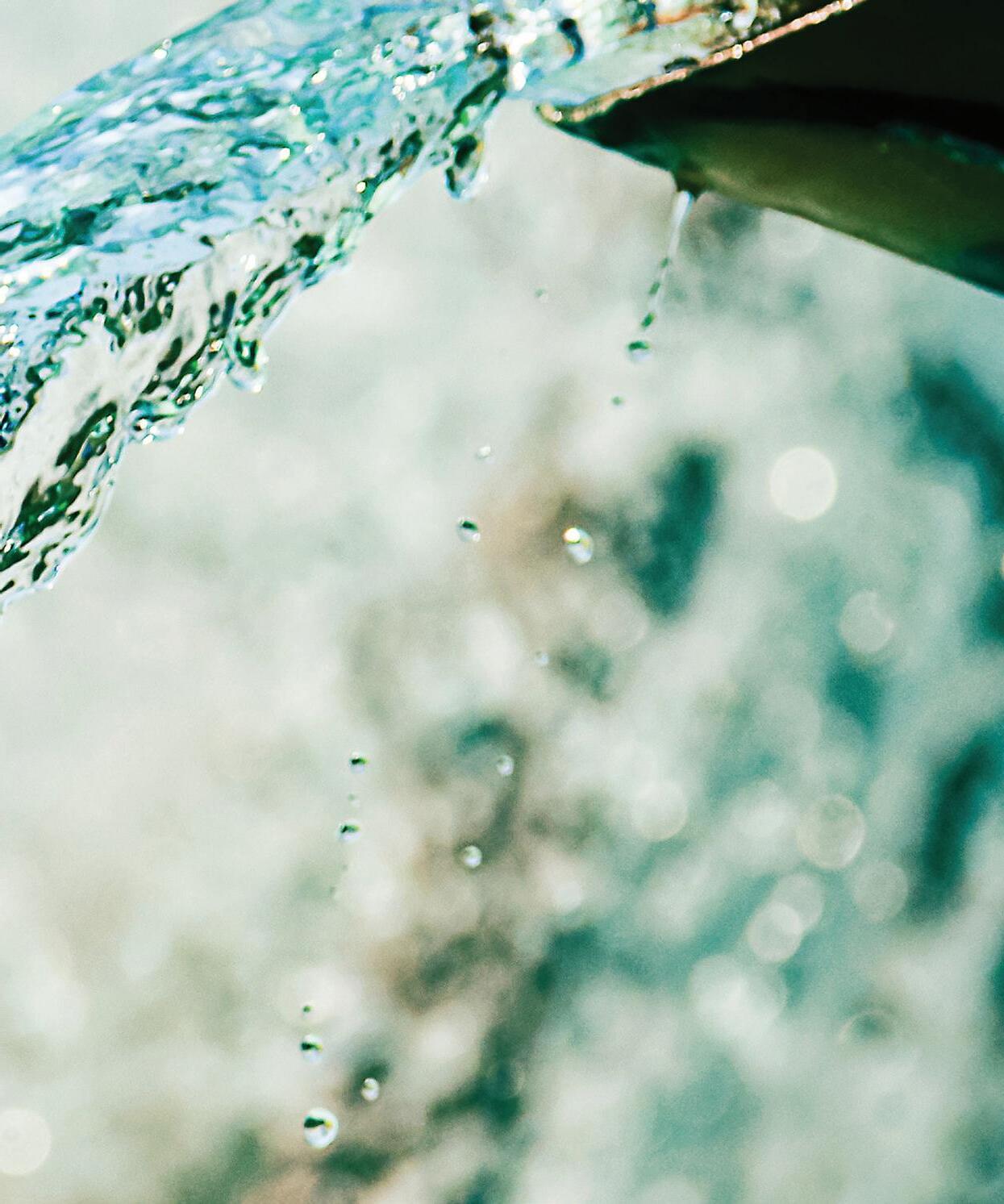
readily available from traditional algorithmic mechanisms, can be better captured by data-driven machine learning methods, and can be exploited to reveal the condition of a pipeline between local inspection sites.
Machine learning is a powerful tool to uncover the hidden phenomena from the data directly. Specifically, probabilistic models able to capture data correlation can be learned from the available local inspections to shed light on in-between predictions. In the current work, nonparametric Gaussian Spatial Processes have been used.
‘In-between’ framework in practice
Assuming local inspection information from short pipe sections has been obtained, the overall method becomes a two-step process: modelling and sampling. The modelling phase extracts information from the specific local inspection data and generalises knowledge about the parameter of interest (e.g. wall thickness). The sampling phase provides likely predictions by turning the generalised knowledge into probabilistically distributed samples, able to capture the underlying pipe data correlations at unseen locations.



























 FIGURE 2. EXAMPLE OF THE SPATIAL ‘DATA CORRELATION’ EFFECT.
FIGURE 2. EXAMPLE OF THE SPATIAL ‘DATA CORRELATION’ EFFECT.
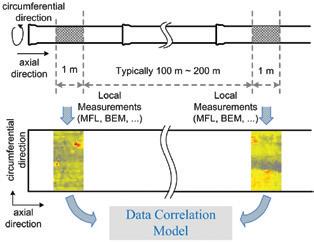
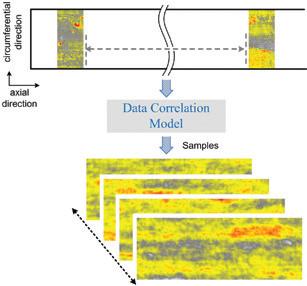
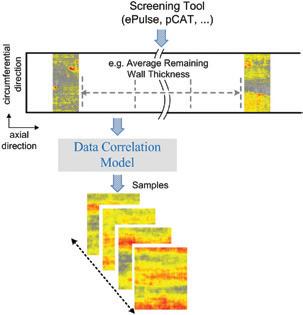
These samples, usually in a large amount, collectively reflect reasonable variations in the expected condition of the pipe, providing that the learning has been generalised adequately.
Step 1: learning data correlations from local inspections, as shown in Figure 3. A data correlation model aims to capture and generalise the spatial dependency between thickness measurements.
Step 2: As seen in Figure 4, samples of likely pipes can be derived from the models learned in Step 1, without the need of any additional inputs. However, given the information that increasingly available screening condition assessment tools are presumed to provide (e.g. assorted statistical values related to wall thickness), or more specific conditions from other indirect measurements (e.g. maximum expected pit depth from soil parameters such as soil resistivity), this can be exploited by data correlation
models as a constraint to provide a refined prediction of the pipe condition. An example of the kind of results that could be expected from this process is depicted in Figure 5, where all samples shown illustrate possible scenarios of a given area of interest that satisfy the measured constraint (e.g. the average remaining wall thickness as measured by a screening CA tool for that section of the pipe).
Given the probabilistic nature of the proposed data-driven methodology and the phenomena itself, exact inference of the condition of the pipe at arbitrary locations along the length of the pipe is not really feasible. However the strength of the framework proposed in this research lies in its ability to derive likely conditions gathered from large numbers of sample representations. This outcome format is beyond the state-of-the-art practice, and potentially supports a mechanism apt for subsequent structural stress or
extreme thickness value based risk analysis, or any other reliant on the thickness semblance of a pipe.
THE WAY FORWARD
The aim of this research activity is to develop “along the pipe” condition assessment predictions with an accepted level of certainty by capturing the naturally occurring correlations in pipe wall thickness, given the constraints that inspecting large sections of critical water mains impose, and the perceived limitations of commercially available CA techniques. The research concept provides a collection of statistically representative cases of likely “in-between” pipe wall maps which could ultimately aid in any subsequent analysis of failure modes and the remaining life of the asset. The model is currently under validation.
The
92
CONDITION ASSESSMENT
partners in this research project include Sydney Water Corporation, Water Research Foundation of the USA, Melbourne Water, Water Corporation (WA), UK Water Industry Research Ltd, South Australia Water Corporation, South East Water, Hunter Water Corporation, City West Water, Queensland Urban Utilities and Yarra Valley Water. The research partners are Monash University, University of Technology Sydney and University of Newcastle.
FIGURE 3. STEP 1: LEARN DATA CORRELATION MODELS FROM LOCAL INSPECTION RESULTS.
FIGURE 4. STEP 2: APPLY THE INBETWEEN MODEL ON A GIVEN AREA WITHOUT ANY ADDITIONAL INPUT
FIGURE 5. STEP 2: APPLY THE INBETWEEN MODEL ON A GIVEN AREA BY INTEGRATING ADDITIONAL CA SCREENING TOOL MEASUREMENTS.

An instant, wireless view into any sewer,
stormwater pipeline Coming Soon!!!


Pipeline assessment—it’s essential to prioritizing CCTV and maintenance work, planning cleaning and rehab, and achieving compliance Using the patented new Quickview airHD you can look inside any pipe with:
No cables at all!


Detailed HD video
In-manhole centering Touchscreen control
Motorized tilt


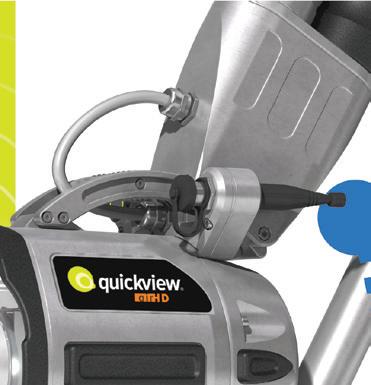
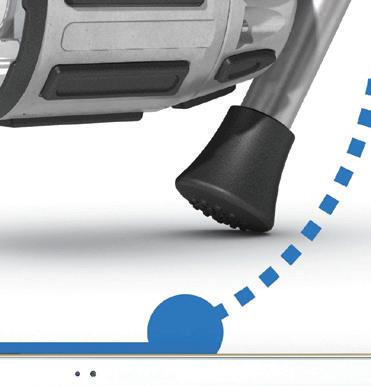
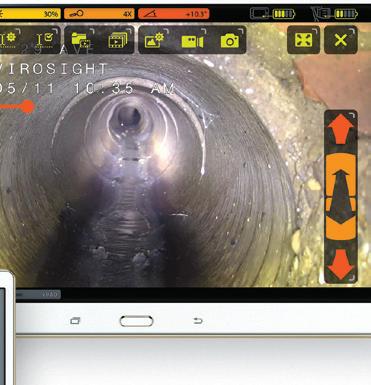
Full wireless control, viewing, recording, annotating, playback and sharing capabilities.
View our full range of equipment for cleaning, testing, inspection and rehabilitation of sewers and drains
Sewer Equipment Company Australia
ww w.seca.co m.a u




NEW!
1800 028 584
IRRIGATION INNOVATION: PUTTING WATER BACK IN THE MURRAY
The $265 million Federal Government-funded South Australian River Murray Sustainability (SARMS) program has been designed to achieve the industrydriven outcomes first sought by the Water Industry Alliance through the original River Murray Improvement Program – and is now being delivered on behalf of the Government of South Australia by Primary Industries and Regions SA (PIRSA).
THE COMMITMENT
In August 2013, a National Partnership Agreement between the South Australian and Australian governments was signed which allocated a total of $265 million to SARMS, with the commitment to return 40GL in South Australian River Murray water entitlements to the Murray Darling River system over a six-year period.
In less than three years, 33GL is now ready for return into the river system. Funding opportunities for local irrigators are being awarded under the $240 million SARMS Irrigation Industry Improvement Program (3IP), and $25 million for regional development is being provided via the SARMS Regional Economic Development (RED) program.
On the provision that entitlements of water are returned to the River Murray, 3IP funding is giving local growers the ability to adopt innovative systems to improve their water and production efficiencies. There’s added spin-offs for the region as well. Independent analysis of the program showed that for every dollar of 3IP investment, it will stimulate about four times this in economic activity across the region –resulting in about $1 billion of economic activity from the total investment by the Australian Government.
According to Andy Roberts, CEO of the Water Industry Alliance, “When organising the 3IP program, the key principle was to support irrigators that were going to stay in the industry; those that were going to be a part of the future of the irrigation industry and the future of the region.
“The requirement to give back water was something that needed to be done for the MDB plan, but it was seen as an opportunity rather than a risk. We explored ways to encourage irrigators to operate as businesses, rather than just as irrigators, and to explore what they could do to maximise their businesses and maximise what they could do for the state,” said Mr Roberts.
FUNDING INNOVATION
3IP is designed to deliver maximum and lasting benefit from the funding dollar to river communities through a competitive application process.
This is being achieved by encouraging SA River Murray water access entitlement holders to optimise their irrigation practices.
The $240 million in 3IP funding is allocated through three investment streams:
• Stream One – Irrigation Efficiency – supporting water efficiency improvements. All projects under stream one are required to return at least 50 per cent of the proposed water savings, with a minimum of 10ML of technically feasible water savings to be provided under 3IP.
• Stream Two – Water Returns – to acquire water through direct purchase.
• Stream Three – Irrigation Industry Assistance – accessible to improve farm productivity only when the applicant is returning
water through streams one and/ or two.
The remaining $25 million has been used to support an RED program to deliver significant outcomes in regional research and economic development through:
• $12.5 million Regional Development and Innovation Fund
• $5 million Industry-led Research Sub-Program
• $7.5 million redevelopment of the Loxton Research Centre.
The following two case studies are from major contributors to the South Australian agricultural industry. Each has successfully implemented 3IP funding to develop their irrigation infrastructure, and both are already reaping the rewards of more efficient and practical systems.
SECURING WATER SUPPLY
Jubilee Almonds, located at Overland Corner near Waikerie, SA, recently completed major pump and irrigation system upgrades across their orchards after receiving $5.6 million of funding from streams one, two and three of the 3IP program.
Canopy low-throw sprinklers were upgraded to a dual micro-sprinkler/ drip system during replanting, and according to Jubilee Almonds CEO Brendan Sidhu, the benefits of the upgrade have been nothing short of impressive.
“As the ground at the orchard is very sandy and conducive to drift, initially our plantings were irrigated via low-throw sprinklers. With the advancement of drip, we decided to replace the low throws with a dual drip and micro sprinkler system.
“By introducing a dual system of both micro-sprinkler and dripper, the benefit is twofold. The micro-sprinklers enable us to establish cover crop to
94
IRRIGATION
Record levels of government funding are providing local growers along South Australia’s River Murray with the opportunity to remain at the forefront of irrigation practice, while returning much needed water to the Murray-Darling Basin (MDB) River system.

hold the soil between each tree, as well as helping to control frost during winter. With cover crop in place, the drip system is then able to be used to irrigate the trees as well as distribute fertiliser.”
According to Mr Sidhu, the orchard’s original system did not provide the orchard with a high level of water security.
“We originally had two 500kW electric pumps down at the river and a diesel booster pump installed at the orchard to boost water flow and pressure. Each of the pumps had to be started manually, and if one of the pumps failed, we would lose 50 per cent of our pumping capacity. If there was a power outage, we simply had no back-up to keep the pumps running.
“The new system now involves four 280kW turbine pumps, meaning we would only lose 25 per cent of capacity if one was to fail. They are now also controlled by variable speed drives, giving us the capacity to run them at anywhere between 40L per second to up to 650L per second.
“The new system has enabled us to eliminate the diesel pump altogether and has provided us with a fantastic
level of flexibility for different demands of water across the orchard.
“Overall, we have been able to increase efficiencies and we now have a system that is a lot more reliable,” said Mr Sidhu.
SPROUTING NEW OPPORTUNITIES
Byrne Brothers operates a dynamic trio of vineyards, incorporating an impressive acreage of wetlands and agricultural farmland dotted across the SA Murray-Darling Basin region.
Major irrigation infrastructure upgrades were recently carried out at the Byrne Lone Oak Farm, which neighbours the company’s Glen Devlin Vineyard at Devlins Pound near Waikerie. These upgrades were initiated to allow for the production of new and diverse crops such as 800 hectares of lucerne.
According to Rob Byrne, a partner in the Byrne Brothers family business, contracts to receive the 3IP funding were signed in 2014 with pump infrastructure undergoing installation in mid-2015.
“There were a number of different upgrades completed across the Lone Oak property. These included the installation of diversion pumps from the River Murray, installation of an upgraded rising main as well as a re-lift booster pump station and associated distribution mains with connections for centre irrigation pivots.”
According to Mr Byrne, the upgrades have resulted in large water efficiencies, increase in pumping capacity and an increase in production of other crop via shared farming agreements.

IRRIGATION 95
CENTRIFUGAL LONG PUMPS AT THE BYRNE VINEYARDS BOOSTER STATION.
CENTRE PIVOT IRRIGATION SYSTEM AT BYRNE VINEYARDS.

According to Mr Byrne, the upgrades
“The funding has given us the freedom to be highly innovative in designing systems, and working with suppliers has led to greater conversations and activation of irrigation best practices.
“Although 3IP is a government recovery of water entitlements, the program seeks out best practice to bring sustainable agriculture to farming communities that improve crops and output,” said Mr Byrne.
THE BENEFITS OF 3IP SO FAR
According to Ben Fee, PIRSA Agribusiness Manager, the benefits of 3IP funding are widespread and have already resulted in impressive innovation measures and significant water returns.
“Our system is innovative in itself, with its design allowing for it to be moved from a circle to another circle area within two hours. This means we can irrigate up to three circles of lucerne or other crops with one centre pivot.”
have reached further than the farm and have provided tangible benefits for the community at large.
“With the support of SARMS 3IP program, we have been able to employ more people and improve their skill base by adopting new technologies.
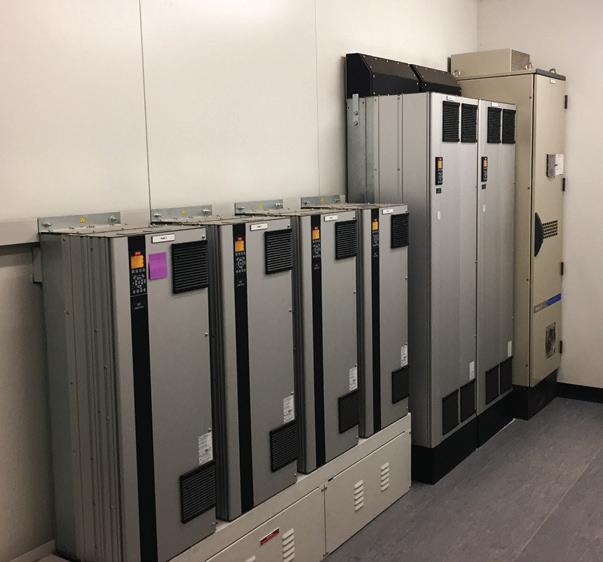
“SARMS 3IP has provided the opportunity for long-term water delivery infrastructure changes that deliver ongoing benefits to multiple end users, based along the River Murray,” said Mr Fee. “Just one example is the energy savings generated through the installation of the latest industry leading pump technologies within the SARMS 3IP funded irrigation projects,
THE MURRAY-DARLING BASIN
Covering 14 per cent of the total landmass of Australia, the Murray-Darling Basin (MDB) is Australia’s main source of food production and agricultural farmland. Known as Australia’s ‘food bowl’, the MDB generates 39 per cent of the national income derived from agricultural production.
The MDB is defined by its water, involving 23 rivers and their catchments, yet less than 15 per cent of the area of the basin contributes to runoff – except in times of flood. High evaporation rates, expansive floodplains and significant water diversions for towns and agriculture mean that much of the surface water in the basin does not reach the ocean.
As three quarters of Australia’s irrigated crops and pastures are grown within the basin, numerous programs have been put in place by government and authorities to help secure the future of Australia’s most precious water system.
IRRIGATION 96
Irrigation innovation: putting water back in the Murray
VARIABLE SPEED DRIVES AND HARMONIC FILTERS, PART OF THE JUBILEE ALMONDS SYSTEM.
THE CONTROL ROOM FOR THE JUBILEE ALMONDS IRRIGATION SYSTEM. IT IS SET THAT HIGH SO THE BASE IS ABOVE THE 1956 FLOOD LEVEL.

THE MIGHTY RIVER MURRAY
The River Murray is the lifeblood of the Murraylands and Riverland regions of South Australia. With the area home to 70,000 South Australians and $840 million worth of irrigated agriculture, the River Murray supports industries such as vegetables, grains and livestock in the Murraylands, and irrigated horticulture (fruit, nuts and grapes) in the Riverland.
Water returns will aid in keeping the Murray Mouth open and flush salt from the system, while meeting salinity and water quality targets to protect the Coorong, Lower Lakes and the river channel, and provide environmental flows to River Murray wetlands and floodplains.
which will provide productivity benefits to around 200 irrigators.
“Many of the funded projects have also factored in future technology advancements in the area of solar power, which they are now able to easily introduce without further
Always a good solution














significant capital expenditure as a result of their SARMS 3IP project.
“The program is unique in that the water returns look after the environment, the irrigation and production efficiencies look after the farmers, and the mix of regional

















development opportunities look after the region’s communities.
“The SARMS National Partnership Agreement seeks the final water returns to be made by March 2017, with the program well on target to meet this goal,” said Mr Fee.
You’re searching for an efficient measurement solution? No problem with KROHNE.
KROHNE has met the challenges of the water and wastewater and beverage industry with innovative measuring solutions.
KROHNE offers a whole spectrum of flow, level, temperature and pressure measurement as well as process analysis technology including complete solutions and the pertaining services.





















We supply instrumentation for all stages of potable water production and transport, including water catchment, water treatment, storage, distribution and leakage control. In wastewater networks, KROHNE is known to provide measuring solutions for sewage water transport, mechanical pretreatment, biological treatment, as well as sludge and effluent monitoring.


Our additional services secure efficient planning, commissioning and maintenance of water and wastewater systems.
KROHNE – Water and wastewater is our world.








KROHNE Australia
5 Phiney Place • Ingleburn NSW 2565 Tel: 02 9426 1700 • www.krohne.com
IRRIGATION
97
PLC CONTROL FOR THE JUBILEE ALMONDS IRRIGATION SYSTEM.
RAMPING UP
The National Broadband Network rollout is undergoing a period of acceleration, following a series of milestones including the release of the nbn’s fibre-tothe-node connection product, revised contractor agreements and campaigns to expand the workforce. Meanwhile, nbn continues to progress its product roadmap, with long-term commercial satellite and HFC connection options next to join the multi-technology mix.
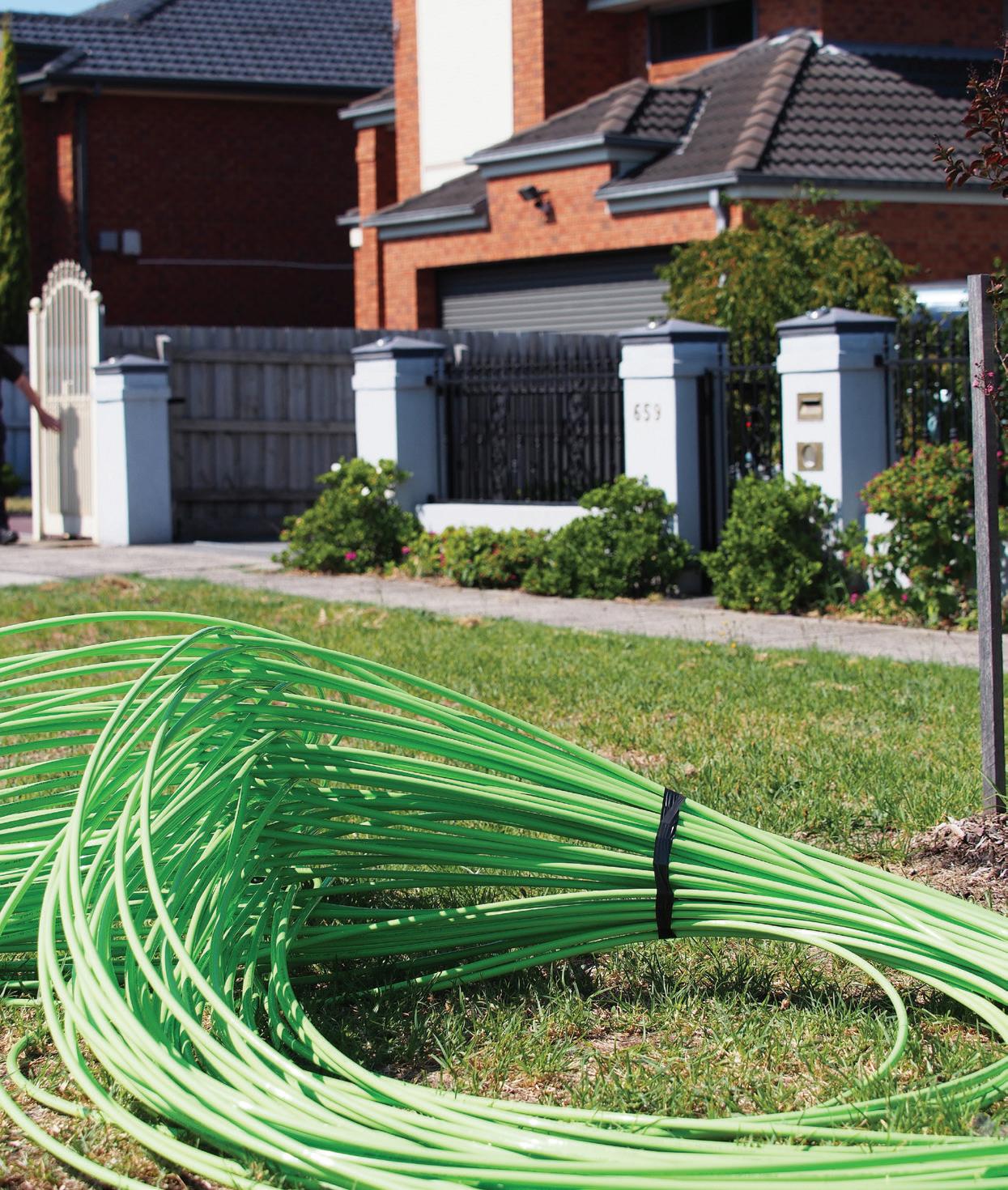
BREAKING DOWN THE NUMBERS
According to nbn statistics, 2015 was the rollout’s biggest year to date, with more premises passed by the network and more services activated than in any previous year.
By 31 December 2015, a total of 1,670,972 premises were ready for service (RFS) around Australia and 736,052 had nbn services activated.
Around 844,148 of the RFS premises were passed during the 2015 calendar year, a substantially higher number than in previous years (Table 1). Similarly, 413,661 premises were activated during 2015, more than doubling the number of activated premises overall (Table 2).
31st of December 2013 464,906
31st of December 2014 826,824
31st of December 2015 1,670,972
DEPLOYING A MULTI-TECHNOLOGY MIX
Across Australia, nbn contractors have been connecting premises to high-speed broadband using a growing range of technologies. So far, the commercial rollout options include
NBN
TABLE 1. CUMULATIVE PREMISES RFS
98
THE ROLLOUT
the fixed line technologies fibre-to-the-premises (FttP), fibreto-the-node (FttN) and fibre-to-the-basement/building (FttB); as well as coverage via fixed wireless.
Additionally, 48,000 premises are covered by interim satellite services and a number of premises in different areas have been involved in trials for other connection technologies (such as hybrid fibre coaxial connections) or technology variants (such as fibre-to-the-distribution point, Fttdp –a variation of FttN).
Each currently available connection product is deployed according to nbn’s multi-technology rollout principles. These principles aim to ensure the use of the technologies that are least costly and can be deployed the most quickly to each area, while still being capable of providing download speeds of at least 25 megabits per second.
According to nbn, the switch to a multi-technology mix (MTM) rollout model has played a vital role in the project gaining momentum. However, the majority of RFS and activated premises by the end of 2015 were still connected via FttP.
31st of December 2013
31st of December 2014
31st of December 2015
Ready for service premises consisted of approximately 69.4 per cent FttP connections; 7.4 per cent FttN or FttB connections; 20.3 per cent fixed wireless connections; and 2.9 per cent interim satellite connections (Graph 1). The percentage of activated premises of each technology type is shown in Graph 2. The percentages of RFS premises of each technology activated is visible in Graph 3.
The nbn data does not distinguish between FttB (launched in late March 2015) and FttN (launched in September 2015), meaning the relative percentage breakdowns of the two connection types are unclear. Alleged leaked internal documents suggest that the FttN rollout fell behind schedule, primarily due to delays connecting power supplies to nodes, material shortages and completion reviews, and that, as a result, the majority of these connections were FttB. However, at a hearing in March, nbn CEO Bill Morrow told
the Senate Select Committee that the issues have since been resolved and the rollout is still on track to meet its yearly targets.
EXAMINING DIFFERENT NETWORK TECHNOLOGIES
nbn’s most recent half-yearly progress report provides a number of insights into the different technologies currently involved in the MTM rollout and the role each plays in the composition of the network so far.
FttP
Premises RFS by end of 2015: 1,159,615
Premises activated by end of 2015: 610,978
nbn states that during December 2015, an average of more than 10,000 FttP premises were activated each week, compared to 4,000 a week in December 2014.
FttN and FttB
Premises RFS by end of 2015: 123,574
Premises activated by end of 2015: 6,636
According to nbn, the 12-week rolling average for FttN and FttB RFS is now at 8,000 per week, and continues to accelerate with more than 600,000 premises in construction, and nearly 1.3 million in design. The company aims to have 500,000 premises RFS by the end of FY16.
While critics of the MTM rollout have criticised the potential costs of nbn remediating damaged sections of the copper access network for FttN connections, the company states that these costs have been factored into the budget and that the network conditions are generally falling in line with expectations.
Fixed wireless
Premises RFS by end of 2015: 339,783
Premises activated by end of 2015: 82,435
NBN 99
TABLE 2. CUMULATIVE PREMISES ACTIVATED
130,759
322,391
736,052
Interim satellite Fixed wireless FttN or FttB FttP 69.4% 7.4% 20.3% 2.9%
GRAPH 1. RFS PREMISES BY TECHNOLOGY TYPE.
nbn states that more than 50 per cent of the fixed wireless footprint is now complete. The fixed wireless network includes 1,651 wireless sites and 1,265 base stations.
In December 2015, following a successful pilot phase, nbn launched a 25-50/5-20Mbps wholesale fixed wireless service.
THE COST OF DEPLOYMENT
The cost of connecting a premise to the network varies depending on the technology used, and, in the case of FttP, whether the premise is located in a new development (greenfield) or already established area (brownfield). The average costs of each connection type, as of the end of 2015, are compared in Table 3.
FttP brownfields
Fixed wireless
FttP greenfields
FttN
$4,419
$3,516
$2,770
$2,300
These costs should be viewed with an understanding that nbn undertakes a continuous process of trialling different technologies and product variations, in order to identify ways to reduce costs and accelerate the rollout. Rollout costs can also be affected by unexpected circumstances. Therefore, the costs of deploying different connection types are subject to change.
For instance, the company recently trialled a cheaper FttP build using thinner optical fibre, which has the potential to greatly reduce the cost of deploying fibre network components.
There is also the potential for new connection types or variants to be incorporated into the rollout as new technology becomes available and its cost falls.
For example, nbn intends to undertake larger scale trials of an Fttdp product variant, where the fibre optic component of the network terminates at a smaller node (serving two to six premises), at the last possible junction point. The Fttdp node also has the benefit of being powered from the customer’s premises rather than needing a separate power source. The recently trialled thinner, cheaper type of optical fibre will also be incorporated into the trial connections.
The trials, which began in April, will run for three months and are expected to connect around 20-30 homes of nbn staff in Sydney and Melbourne. Currently, nbn expects that a commercial Fttdp product may become available some time in 2017.
Initially, nbn primarily intends to use Fttdp to serve premises that are located too far from the existing power infrastructure required to power an FttN node and are unsuitable for other, cheaper connection types.
There are suggestions that this product, which can achieve superior upload and download speeds to FttN, may eventually replace sections of the rollout of FttN in areas where design and construction have not already begun by the time it becomes commercially available.
“This has opened so many more opportunities,” said Mr Morrow. “We see a couple of hundred thousand homes that would otherwise be getting FttN or fixed wireless that this now has passed over and broken over into the faster, cheaper driver that we have.”
In response to suggestions that the superior speeds achievable on Fttdp and respective costs of deploying Fttdp and FttN (with Fttdp estimated to cost around $400 more per connection on average) mean that Fttdp should replace the FttN rollout completely, Mr Morrow stated that the technology “is just not quite there” and is yet to be the quickest and cheapest option for the majority of premises.
NBN CFO Stephen Rue said the switch from FttN to Fttdp had been considered, but the cost of changing the type of technology deployed in areas where FttN design or construction had already progressed would be too costly and
NBN 100
TABLE 3. COST PER PREMISES
Fixed wireless Interim satellite 52.7 5.4 24.3 75 0 20 40 60 80 100 FttP FttN or FttB % of RFS premises activated 0.9% Interim satellite Fixed wireless FttN or FttB FttP 83% 11.2% 4.9%
GRAPH 2. ACTIVATED PREMISES BY TECHNOLOGY TYPE. GRAPH 3. PERCENTAGE OF RFS PREMISES ACTIVATED BY TECHNOLOGY TYPE.
cause delays in the rollout.
NEXT ON THE AGENDA
In recent months, nbn has been completing final trials and demonstrations leading up to the company’s next major product releases – its commercial hybrid fibre coaxial (HFC) connection product and its long-term satellite service.
nbn successfully completed its HFC pilot in Redcliffe, Queensland. This pilot began in November 2015, and involved building out the network to 4,500 premises on the Optus HFC network and activating test connections to around 20 premises from three different retail service providers (RSPs) – Telstra, iiNet and Exetel. During the trial period, end users received speeds of up to 100Mbps download and 40Mbps upload, averaging at 84/33Mbps. This places the upload speeds of nbn’s HFC service among the fastest in the global market. The company now expects to launch commercial HFC services in June 2016.
Throughout the pilot, the end user experience was measured by eMetric boxes. These devices connect to the RSP’s gateway/router through an Ethernet cable plugged into the network port, and automatically measure and report on network performance. This device can discretely test for features such as network performance (download and upload speeds) and network latency.
Independent telecommunications research firm Ovum was recruited to verify the pilot results. According to Ovum, the tests provided a ‘good (if not conservative) overall view of average speeds’ despite the placement of the eMetric devices (in parallel with the end user gateway) – meaning the eMetric devices competed with the end users’ devices for bandwidth, which may have reduced the speeds achieved throughout the trial, especially at peak times.
While the HFC pilot used the current generation DOCSIS 3.0 standard technology, from mid-2017 nbn expects to begin deploying next-generation DOCSIS 3.1 technology, which is capable of wholesale downstream speeds of 10Gbps and wholesale upload speeds of 1Gbps.
TRANSLATING TEST SPEEDS TO A FULL-SCALE ROLLOUT
While the speeds achieved throughout the trial provide some indication of the upload and download speeds HFC connections are capable of achieving, additional factors must be taken into account for a full commercial HFC rollout.
For instance, in HFC networks, all premises served by a fibre-optic node share the bandwidth of that node. This means that there exists a maximum number of premises which can be served by one node while still delivering high speeds. Additionally, factors such as the condition of the existing HFC network and whether any remediation of the cable is required can affect the cost and speed of HFC deployment.
However, nbn states that it is confident it can translate its proposed HFC broadband speeds across its HFC network through a number of initiatives. These include:
• Detailed network planning to understand and predict
uptake rates across the range of services
• Utilising higher upstream modulation rates
• Node splitting (which can be used to decrease the number of premises sharing the same node, allowing greater bandwidth to be offered to the remaining premises)
• Constantly monitoring HFC network performance to ensure any network issues are remediated
• Investing in the migration to DOCSIS 3.1 and the resulting performance benefits this will provide for both the upstream and downstream components.
In June, contractors will begin rolling out commercial HFC connections. The first premises connected are expected to be in Redcliffe, where the pilot took place. nbn has been working towards finalising contracts with Telstra and Optus for HFC engineering, procurement and construction management since December 2015.
BLASTING OFF WITH SKY MUSTER
The commercial launch of nbn’s Sky Muster satellite service is expected to occur in late April to early May 2016, after a successful demonstration at the ENEX Test Lab in Brunswick, Victoria.
During the demonstration, Sky Muster delivered Layer-3 speeds of 25Mbps download and 4Mbps upload – just short of the maximum 25/5Mbps wholesale speeds that will be available on the service.
End user trials involving around 200 premises in regional Victoria are now being undertaken to conduct further testing of the service ahead of the full commercial launch.
The first commercial satellite, Sky Muster, launched into orbit in October 2015, and the second satellite is expected to join it in the second half of 2016.
Preceding the commercial satellite product, Interim Satellite Services (ISS) and the nbn Satellite Support Scheme (NSS) have provided 48,000 homes and businesses with satellite broadband services.
THE NEXT STEPS
Successfully launching the new HFC and satellite connection products will be vital for nbn to meet its ambitious rollout target of connecting eight million premises to the network by 2020.
Additionally, nbn aims to have approximately 2,632,000 premises RFS and approximately 955,000 activated around Australia by the end of the 2016 financial year.
Those within the industry will watch the nbn with interest over the coming months, to examine the impact of the new connection products on the rollout’s progress. There will also be interest around whether the company can build on 2015’s results and meet its yearly rollout and budget targets, despite doubts expressed by media and industry sources. The findings of the company’s Fttdp trials and its subsequent decisions about incorporating this technology into the rollout could also have dramatic implications on the future of the MTM and Australia’s broadband.
101 NBN
ActewAGL takes flight
TO INSPECT ITS NETWORK
ActewAGL carried out helicopter inspections of overhead powerlines across its network during February, giving the utility an overall view of the state of its network. The helicopter patrols are an essential part of ActewAGL’s vegetation management and asset management program.
The patrols inspected for vegetation encroaching on powerlines and flew at approximately 110-150 metres in rural areas and above 310 metres in urban areas, with minimal hovering.
The helicopter used Light Detection and Ranging (LiDAR) remote sensing technology to determine the distance between powerlines and vegetation. Vegetation deemed too close to powerlines during the patrols are being prioritised for cutting by ActewAGL’s authorised service providers in rural areas. In urban areas, notifications have been sent to customers or the ACT Government, depending on where trees are located.
The helicopter also took high

resolution pole top images in high bushfire prone (rural) areas to assess the pole top condition and prioritise ActewAGL’s preventative maintenance regimes.
ActewAGL Manager Works Delivery
Clinton McAlister said, “The helicopter patrol is a significant part of our overall network maintenance program and bushfire mitigation strategy. Trees and vegetation growing too close to powerlines can cause blackouts and create safety hazards such as grass fires and bushfires. Trees and vegetation can also restrict access, preventing essential maintenance from being carried out.”
RESIDENTS URGED TO MONITOR
PROPERTY
The patrols revealed that trees are too close to powerlines in many parts of the nation’s capital; and ActewAGL is encouraging residents to continue to monitor vegetation on their property. Good vegetation management standards see that:
• Trees are 1.5m clear of powerlines. If they are already too close, residents should contact an accredited tree surgeon.
• There is 1.5m of clearance in all directions around the base of poles, meters, substations and mini pillars.
“ActewAGL helicopters were flying throughout February to inspect vegetation around our poles and wires
102
FALLEN TREE BRANCHES ON POWERLINES CAN CAUSE BLACKOUTS AND INCREASE THE RISK OF ELECTRIC SHOCK AND BUSHFIRES.
VEGETATION MANAGEMENT
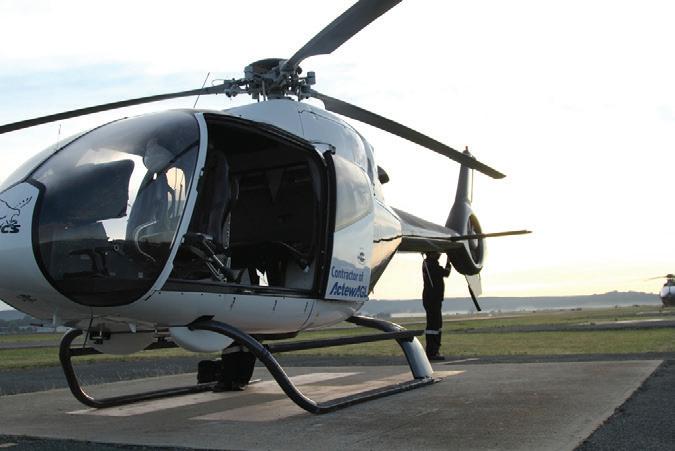
This year the helicopter was in the air for around 37 hours and covered 1,793km across most rural and urban areas in the ACT,” said Mr McAlister.
“We were able to identify vegetation encroaching on powerlines that we would not be able to see from the ground. We are now working with
landowners and occupiers to ensure the safety of our community and the network.”
Landowners and occupiers are responsible for keeping a clearance of 1.5 metres around powerlines; but Mr McAlister noted that residents shouldn’t attempt to trim branches
themselves. The task should only be carried out by an accredited tree surgeon.
Trees touching powerlines can create blackouts and increase risk of fires and electric shock. In windy weather, trees can fall and bring down live electrical wires, creating a dangerous safety hazard and interrupting power supply.
ActewAGL has been using helicopters for inspection since 1979, when the utility first borrowed a helicopter to inspect a large portion of its network.
“Since then we’ve been using helicopters in a few different ways,” said Mr McAlister. “Helicopter patrols are the most accurate and effective way of detecting encroachments between the vegetation and our poles and wires. It allows us to look at the top of the infrastructure, the bits we can’t see from the ground to really understand if there are any problems with the top of the network.”

VEGETATION MANAGEMENT
103
ACTEWAGL HAS CONCLUDED THIS YEAR’S HELICOPTER PATROLS ACROSS THE ACT.
FINAL CHANCE TO SECURE A PLACE AT EN2016
Time is running out to book for Energy Networks 2016 – Energy in Transition. Don’t miss your chance to be a part of this vital, national conversation. Energy Networks 2016 will be held at the Adelaide Convention Centre from Wednesday 18 May – Friday 20 May 2016.
The Hon Josh Frydenberg MP, Minister for Resources, Energy and Northern Australia, will be opening Energy Networks 2016, on Thursday 19 May. With an election due to be held this year, the new Minister’s address will be an important contribution to the national conversation on the future of electricity and gas services, and priorities in energy and carbon policy.
In addition to Minister Frydenberg, the ENA also welcomes Mr Basil Scarsella AM, Chief Executive Officer, UK Power Networks, who will deliver the International Utility – Keynote Address, and Dr Lawrence Jones, Vice President, International Programs, Edison Electric Institute, who will provide the Energy in Transition – Keynote Address.
With an important line-up of speakers across the conference’s plenary sessions and a packed concurrent program, Energy Networks 2016 will deliver access to leading international and domestic industry executives and practitioners.
One session entitled ‘Bring it on!’ hosts Terry Effeney, Chief Executive, Energex; Prasanna Venkatesan, President & CEO, Americas, Landis+Gyr; Lena Hansen, Managing Director, Rocky Mountain Institute; and Professor Dr Gerald Linke, CEO of the Gas and Water Association of Germany (DVGW) and the Chair of the Research, Development and Innovation Committee of the IGU, discussing the new energy future, what it may look like and what it will take to deliver new services and technology for energy customers.
Then at ‘The Unlocked Grid’ session, Paul Nahi, President & CEO, Enphase; Andrew Vesey, Managing Director & CEO, AGL; Ann Burns, Managing Director
Resources ANZ, Accenture; and Tim Rourke, Chief Executive Officer, CitiPower & Powercor, will discuss innovation, disruption and competition in the energy sector, and the outlook for a new, customer-centric business model.
We are delighted to confirm that James O’Loghlin – lawyer, comedian and media personality – will facilitate the plenary sessions on day two. As the former host of The New Inventors, he continues to be passionate about innovation and is keen to demonstrate the ways in which companies can create a culture that encourages innovation.
Delegates will find that there is something in the program for all energy networks sector professionals.
New – Operational Best Practice Workshop
A new feature of Energy Networks 2016 is the Operational Best Practice Workshop. Designed specifically for network business line managers and operational staff, this workshop will consider the latest practices and technology that support the modern grid, and will appeal to a broad range of those working in the industry.
A key feature of the workshop will be a Keynote Address from Professor Melinda Hodkiewicz on the practical implementation of ISO 55000, and lessons from overseas and other industries.
In addition to Professor Hodkiewicz, five fundamental elements in the safe and efficient operation of electricity distribution and transmission networks will be discussed over the course of the workshop, including: substation modernisation, vegetation management, community and safety, managing embedded generation on the grid, and asset management and reporting.
Managing vital electricity assets and integrating new technology and services on the grid, while meeting the core responsibility to deliver safe and reliable energy in diverse conditions, is a critical issue for network businesses.
Expert speakers across the two days
will come from electricity networks, service and technology providers and research agencies, including Oracle Utilities, United Energy, Siemens, Fugro Roams, Geomatic Technologies, North Power, Ergon Energy, AECOM, Wilson Transformer Company and CSIRO.
Operational Best Practice Workshop registration includes access to all Operational Best Practice Workshop sessions plus the Exhibition itself. Workshop attendees will also be welcome to participate in the Welcome Reception and Meet the Industry Breakfast.
Sponsorship and exhibition places available
Energy Networks 2016 is offering extensive opportunities for businesses that supply the industry to meet key decisionmakers in the energy networks sector through sponsorship or exhibiting in the Exhibition Hall. With increased attendance in 2014, Energy Networks 2016 is an important opportunity for all businesses across the energy supply sector to make direct contact with relevant industry people. Exhibitors are also welcome to participate in the conference sessions.
A number of exciting sponsorship and exhibition opportunities are still available, so visit the Energy Networks 2016 website today to download the Sponsorship and Exhibition Prospectus. Sponsorship packages can be tailored to your business’s requirements so take action today to ensure your preferred level of engagement is secured.
Interest in the event grows stronger every year and conference registrations have exceeded expectations to date. Registrations from gas and electricity network businesses have surpassed those received in 2014, in addition to strong registrations from across the supply chain, government, research organisations and industry suppliers. Book your place today to meet key decision-makers from across the industry.
104
EVENTS
Register today for Energy Networks 2016 – Energy in Transition, the Energy Networks Association (ENA) biennial Conference and Exhibition which will be held at the Adelaide Convention Centre from Wednesday 18 May to Friday 20 May 2016. Significant discounts are also available for group bookings made by a company in a single

JOIN US AT THE QLD WATER INDUSTRY OPERATIONS CONFERENCE AND EXHIBITION
CQU Sports Centre Rockhampton, 1 & 2 June 2016
Promoting best practice in water management by building the knowledge, skills and networks of industry operators. WIOA annual conferences provide a medium for individuals involved in water operations to:
• Listen to the experience of others through the latest “operational” technical and research based information through platform and poster presentations.
• View and discuss the latest advances in technical equipment, products and services with suppliers and trade consultants
• Update their knowledge and skills through interaction with fellow water industry employees.
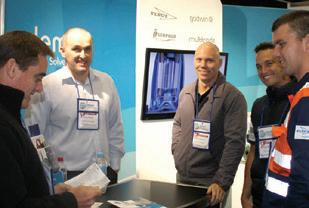



Water Industry Operators Association of Australia (WIOA)
WIOA is a national association with a primary role of facilitating the collection, development and exchange of quality information between people undertaking operational roles in the water industry.


Sponsorship Opportunities Available
Take advantage of the opportunity to position your company as a leader in water management by aligning your company as a supporter of the leading non-profit organisation serving the needs of operators in the water industry. For more information on exhibiting or sponsorship, visit the conference website. Sponsored


by
by W wioaconferences.org.au E info@wioa.org.au P 03 5821 6744 REGISTER NOW
Supported
101 Exhibition Sites SOLD OUT
All water industry personnel involved in the operation and maintenance of urban, rural and industrial water related infrastructure for the management, conveyance, treatment, discharge and reuse of water and trade wastes should attend this conference.
As Australia’s energy infrastructure transitions away from fossil fuels and towards a low carbon and increasingly distributed future, there are difficult questions and decisions to be made concerning the future of the sector.
Currently, the energy industry is facing a twofold challenge –meeting the needs of millions of consumers and high energy intensive companies with low-cost, reliable energy, while simultaneously participating in a global transition to clean, low-carbon energy systems.
The choices industry and policy leaders make will have significant macro-economic impacts and shape the market of tomorrow.
With tensions high and a great political divide, 2016 is seeing important policy developments and investments that are impacting the industry and will change Australia’s energy mix for the coming years. New technologies, new market players, new investments and new business models are shaping the Australian electricity and gas markets well into the next decade.
So how is the industry progressing, who is leading the transition, and what strategic investment decisions are being made?
With market leaders and investors now facing these important market uncertainties, Australian Energy Week, to be held in June in Melbourne, will give light to the future roadmap, gathering federal and state policymakers and rule makers, financial experts, and leading national energy companies paving the way in this transition.
One conference highlight will be the keynote panel discussion on the opening conference day, focused on managing in an environment of change. In this interactive panel, industry leaders including John Pierce, Chairman, AEMC; Frank Calabria, CEO Energy Markets, Origin Energy; Martin Moore, CEO, CS Energy; Paul Italiano, CEO, Transgrid;
and Miles George, Managing Director, Infigen Energy, will discuss their insights into the changing energy market dynamics.
Australian Energy Week is bringing together all the key players from the length of the energy supply chain under one roof, and promises to be the most significant energy event of 2016. It’s not just an exciting new event, it builds on a long history of successful, high level energy events – such as the Eastern Australia Energy Markets Outlook conference, the NEM Future Forum, and the Electricity Storage Future Forum –and also adds new content streams and an engaging exhibition area.
For more information, visit www.questevents.com.au/australianenergy-week-2016.
EVENTS
AUSTRALIA’S ENERGY ARENA? BOOK NOW T: +61 2 9229 1000 • E: registration@iqpc.com.au • W: www.scadaaustralia.com.au SCADA AUSTRALIA 2016 n Main Conference: 24 – 25 May 2016 n Post Conference Workshops: 26 May 2016 n Venue: The Royce Hotel, Melbourne, VIC Utility readers save 10%* Simple quote the VIP code ‘Utility10’ when booking. Email registration@iqpc.com.au or call 02 9229 1000 to book. Australia’s leading conference for improving tools, techniques and defences in the SCADA landscape WHO WILL YOU MEET AT SCADA AUSTRALIA 2016? • Operation System Managers • Network Operations Managers • Control Systems/ SCADA Engineers • Process Control/ICS Engineers • Communication Engineers • Electrical Engineers And more Industry Sectors: • Utilities • Oil and Gas • Transport • Mining • Manufacturing • Government And more EVENT HIGHLIGHTS INCLUDE: Experience Panel Discussions, Speed Networking and Networking Lunches with key industry leaders Participate in a Roundtable Discussion to work through pressing problems in the sector Separately Bookable Workshop Sessions 4 Practical Case Studies with key takeaways to implement back on the job 11 sdddddddD *Discountsubjecttoavailability andnotavailabletosolutionprovidersor vendors 106
WHAT’S REALLY HAPPENING IN
20-23 June 2016 | Pullman & Mercure Melbourne Albert Park



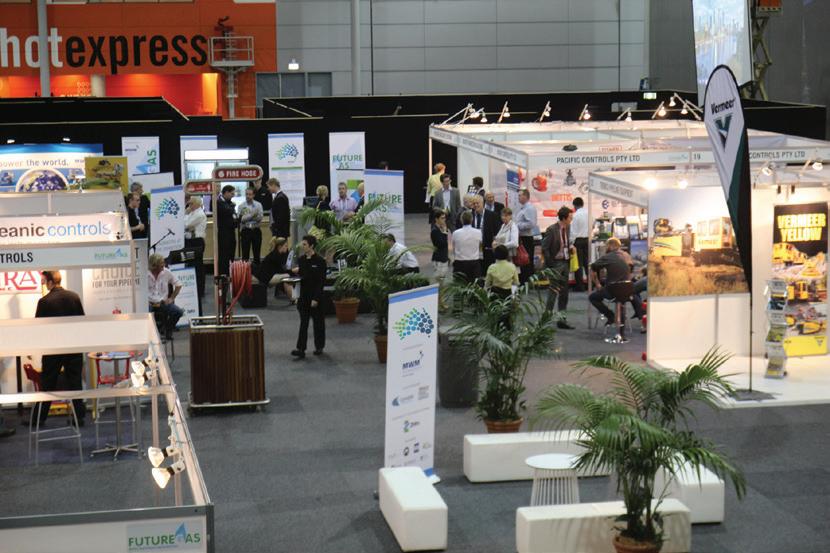


Australian Energy Week is bringing together all the key industry players, regulators and innovators under one roof to addresses the most critical challenges facing the industry today, and to garner insights into the future shape and make-up of the sector.

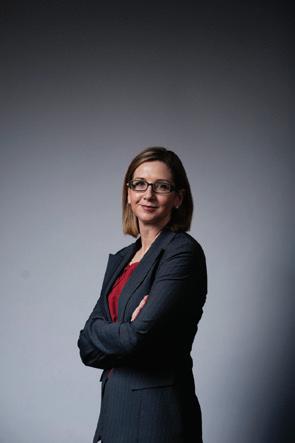
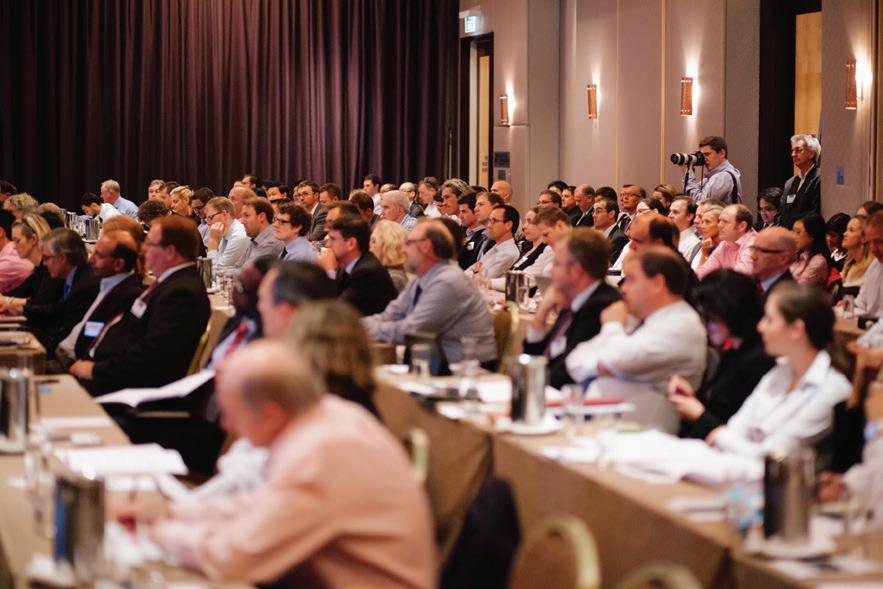










+61 (0)2 9977 0565 www.questevents.com.au REGISTER TODAY! CONFERENCE. INDUSTRY STREAMS. EXPO. NETWORKING. Andy Vesey Managing Director & Chief Executive Officer AGL Energy The Hon. Lily D’Ambrosio MP Paul Italiano Chief Executive Officer TransGrid Frank Calabria Chief Executive Officer Energy Markets Origin Energy Plus many more.. Martin Moore Chief Executive Officer CS Energy Rhondda Dickson Deputy Secretary, Office of Climate Change & Renewables Innovation Department of the Environment Jon Stretch Chief Executive Officer ERM Power Paul Broad Managing Director & Chief Executive Officer SnowyHydro The producers of EAMO, ADGO, NEM Future Forum and more are proud to present the inaugural... ALL THE BIG ISSUES. ALL THE KEY PLAYERS. ALL UNDER ONE ROOF. Organised by: Media partners: Endorsed by: 6x CONFERENCE STREAMS 50+ INDUSTRY SPEAKERS 30+ EXHIBITORS 5 NETWORKING 400+ DELEGATES C M Y CM MY CY CMY K
The utility industry is regularly required to call on an enormous and varied range of specialists; from mapping, to drilling, to wastewater treatment, to asset management, to pipe relining, to pipeline integrity, to land access, to risk management, and the list goes on. To make the process a little easier, Utility magazine is bringing together experts from various fields to answer your questions.
HDD
WHAT IS A FRAC-OUT?
A ‘frac-out’ is the unintentional return of drilling fluids to the surface during horizontal directional drilling (HDD). A frac-out occurs when the down hole mud pressure exceeds the overburden pressure (i.e. shallow or loose sections of the bore), or the fluid finds a preferential seepage pathway (such as fault lines and fractures, infrastructure or loose material). These fractures can be natural or induced by over-pressurising the formation.
It is relatively common for a frac-out to occur on a HDD project. Most frac-outs, however, are usually minor, within construction right of way (CROW) and close to the bore entry or exit.
HOW SERIOUS IS A FRAC-OUT?
That all depends on where it occurs. If the frac-out occurs in an environmentally or culturally sensitive area (which you are generally trying to avoid by using HDD), there is reason for concern. The drilling fluid itself may not be toxic, but the fine particles can smother plants and animals, particularly in an aquatic environment. If a saltwater polymer fluid is used, the salt can also impact on freshwater systems and terrestrial vegetation. Neighbouring landowners do not appreciate frac-outs on their land. In most states a frac-out outside of the working area is generally considered a ‘reportable incident’. In Victoria all frac-outs must be reported to the regulator within two hours.
Frac-outs may also damage infrastructure or nearby services. There are reports of sections of roads rising, nearby water pipelines failing as the frac-out washed away the bedding sand, power boxes filling with fluid and vegetation disappearing into a sinkhole caused by a frac-out.
On the other hand, the frac-out may be small (less than 20L), occur within a disturbed or non-sensitive area and be easily contained and cleaned up. In these cases, there is no lasting impact or damage and no real reason for concern. These frac-outs are still better avoided as they utilise resources and time in the clean-up and reporting.
Generally with frac-outs, the perception and association with other industries means the perceived threat is far worse than reality.
WHAT CAN BE DONE TO PREVENT FRAC-OUTS?
The first step is to assess the risk of frac-out prior to drilling. This can be done using specially-designed software (e.g. D-Geo Pipeline by Deltares) or pressure calculations. These methods


AN AREA WHERE A MINOR FRAC-OUT HAS OCCURRED, WHICH HAS BEEN CLEANED UP AND NO LASTING DAMAGE IS EXPECTED.
compare the maximum allowable fluid pressure against the expected drilling fluid pressure. To ensure they are reliable, they require detailed information on the soils, drilling fluids and bore profile, and should be conducted by experienced personnel. The modelling will predict if and where frac-outs are likely to occur, if profile changes are required (e.g. increasing the depth), the maximum drilling pressures (the driller can then set alarms at these pressures) and if other management strategies are required. In some cases it may be necessary to install casing at the entry point where reduced cover and bearing pressure exists, or drill pressure relief wells to give the fluid a controlled place to go. The
108
A FRAC-OUT.
modelling also allows for the optimum pilot hole bottom hole assemblies (BHA) to be configured for the formation, allowing the correct bit size to be selected for the drill pipe dimensions.
During drilling, contractors should continually monitor the drilling fluid properties i.e. mud weight, viscosity, gel strength, volume and pressure, to prevent frac-outs. They can also include a pressure sub for real-time down hole pressure monitoring by the driller, allowing actual annular pressure readings to be obtained in real-time and then plotted against the modelled values. If any unexpected variations or trends are observed then drilling should immediately cease and the cause investigated. Common causes include a restricted or blocked annulus created by a build-up of cuttings which requires mechanical agitation and fluid flow to re-suspend and remove the blockage.
Contractors should be prepared with frac-out contingency plans
and response equipment such as sand bags, vac-trucks and the like in place. Regular inspections should also be conducted along the drill path during pilot hole drilling.
Both the contractors and the client can take steps to prevent frac-outs, especially in sensitive areas, by undertaking adequate assessment and planning before drilling, and ensuring sufficient controls and monitoring are in place during drilling.
ABOUT CHARLES STOCKTON
UK-born Charles Stockton has been a part of the HDD sector in Australasia since 2003. He is the Managing Director of Stockton Drilling Services, a leading engineering consultancy specialising in HDD and other trenchless pipeline installation methods.
MICROTUNNELLING
WHAT ARE THE BEST PRACTICES WHEN PLANNING A MICROTUNNELLING PROJECT THAT NEEDS TO BE COMPLETED WITHIN A TIGHT TIMEFRAME?
Undertaking a microtunnelling installation within a tight timeframe can increase a project’s difficulty. However, certain measures can be taken to ensure that pipe installation is completed swiftly and efficiently with minimal hassle.
PRE-PLANNING
Working within a tight timeframe requires a lot of pre-planning. Unexpected ground conditions, poor weather and mechanical failure all need to be accounted for, as there is always need for a ‘Plan B’ if something goes wrong.
Changing ground conditions
Contingency plans for changing ground conditions must be in place before beginning work. Test pits can be constructed at each end of the bore prior to project commencement. It is also a good idea to prepare a selection of cutters suited to a range of different ground conditions to allow for changes during the drilling process.
Mechanical failure
Mechanical failure can cause major project delays, and on projects needing to be carried out within a tight timeframe, this can be a very costly problem. To reduce the risk of mechanical failure, it is recommended that all equipment is serviced, tested and made ready for operation prior to construction. Having spare parts available is also a must, and a back-up drilling machine should be on standby in case of machinery breakdown. Selecting the most appropriate and effective tools for a job is a straightforward consideration, but it makes a big difference when it comes to projects with time constraints.
Poor weather
Providing back-up equipment in the case of poor weather must
also be considered. Access roads to the site can be washed away quite quickly in heavy rain, so having equipment such as earthmoving machinery on hand will allow you to continue operation. All-weather access to a tipping facility should also be arranged to account for the disposal of drilling mud created during construction.
Supply of materials
On fast turnaround projects, there is no time for modifications of any materials on site. Everything from steel jacking bands, concrete jacking pipe, joint packers, centralising brackets and carrier pipework should all be measured and trialled before the shutdown. Pre-booking of facilities such as a concrete batching plant for grout supply during a project must also be taken into consideration, especially if the project is to be completed after hours or over a weekend.
ORGANISING PERSONNEL
Self-sufficient crews that can supply their own transportation are key to orchestrating personnel to job sites for fast turnaround projects with minimum hassle. Fully-mobile teams are then able to work on multiple job sites at once, giving contractors more option when scheduling works. This also means that extra labour can be brought into a job site more easily, if the need arises.
ABOUT STUART HARRISON
Global microtunnelling pioneer Stuart Harrison is the Managing Director of Edge Underground, where he specialises in on-grade microtunnelling installations with millimetre accuracy. Stuart is also the inventor of the Vermeer AXIS Guided Boring system, and he is constantly working to improve the effectiveness of this and other trenchless systems used in the installation of gravity sewers. To discuss your next microtunnelling installation, contact Stuart on 1300 JACKED or at stuart@edgeunderground.co.
109
EDITORIAL SCHEDULE
AUGUST 2016
NOVEMBER 2016
FEBRUARY 2017
MAY 2017
MAJOR FEATURES DEMAND MANAGEMENT ENERGY NETWORKS AND DISTRIBUTION WATER RECYCLING WATER PIPELINES DRINKING WATER SPECIAL FOCUS INSPECTION, CCTV AND CONDITION ASSESSMENT MAPPING, GIS & SURVEYING M2M AND MOBILITY VEGETATION MANAGEMENT IRRIGATION EQUIPMENT & MACHINERY SMART METERS MICROTUNNELLING STORAGE
MAJOR FEATURES WIOA SPECIAL GAS PIPELINES TRENCHLESS TECH STORMWATER RENEWABLES ASSET MANAGEMENT SPECIAL FOCUS SCADA. SECURITY AND SOFTWARE WASTEWATER TREATMENT PIPE RELINING DRAIN CLEANING WASTE MANAGEMENT TRAINING EQUIPMENT & MACHINERY PIPE & CONDUIT CABLES EXCAVATORS VACUUM EXCAVATION
MAJOR FEATURES SOLAR DAMS SAFETY BIG DATA SPECIAL FOCUS UTILITY LOCATION SEWER REHABILITATION EMBEDDED NETWORKS DISTRIBUTED GENERATION EQUIPMENT & MACHINERY SWITCHGEAR CABLE PLOUGHING DRONES PUMPS, VALVES AND FILTERS AHD Trenchless 77 AMS Instrumentation & Calibration 85 Aqua Assets 29 Aquatec Fluid Systems 49 Austeck OBC Australia Wide Directional Drilling 59 Australian Energy Storage 81 Australian Energy Week 105 Bintech Systems 66 BVCI 8 C.R. Kennedy / SmartNet Aus 27 Century Yuasa 75 Comdain Infrastructure IFC Curtin University 23 Cut and Clean Concrete Cutting 63 Ditch Witch Australia 67 Dormway 41 Edge Underground 45 Energy Networks 2016 71 Esri Australia 24-25 Hardman Chemicals 47 IFS Australia 18-19 Infield Impact 37 Iota Services 61 Iplex Pipelines Australia 57 Irrigation Australia IBC ITS Pipetech 15 IWES 51 KROHNE Australia 95 Kwik-Zip 17 Metasphere 11 NHP Electrical Engineering Products 53 Oracle 38-39 Pipe Management Australia 13 Pivotel 84 Qmax Pumping systems 56 Rob Carr 42-43 SCADA 2016 104 Select Solutions/Geomatic 9 Sewer Equipment Company Australia 91 Stockton Drilling Services 101 SUEZ 55 Taylors 36 TMC Transformers 69 Total Drain Cleaning Services 2-3 UVS 89 Vacuworx Australia 62 Velox Aviation 33 Vermeer 7 WF Energy Controls 70 WIOA 103 Xplore Technologies 87 Advertisers’ index SALES DEADLINE TBC SALES DEADLINE 1 JULY 2016 SALES DEADLINE 2 DECEMBER 2016 ALL ENERGY WIOA BENDIGO APGA EVENT DISTRIBUTION
MAJOR FEATURES POWERLINES SMART GRIDS ENERGY EFFICIENCY RETAIL, BILLING AND CRM SPECIAL FOCUS LAND ACCESS AND RIGHT-OF-WAY TRANSFORMERS AND SUBSTATIONS PIPELINE INTEGRITY COATINGS LEAK DETECTION EQUIPMENT & MACHINERY EQUIPMENT RENTAL HORIZONTAL DIRECTIONAL DRILLING (HDD) SALES DEADLINE 9 SEPTEMBER 2016 AUSTRALIAN UTILITY WEEK EVENT DISTRIBUTION 110

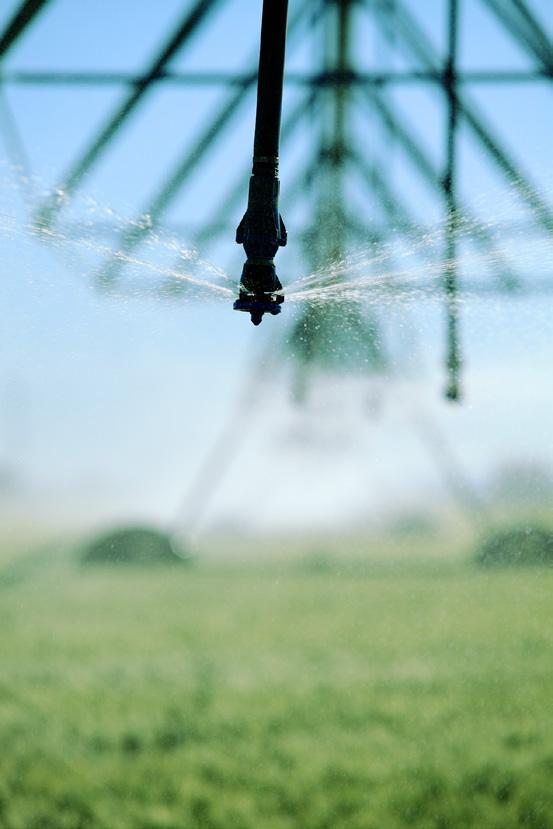

DISCOVER what is POSSIBLE

CONNECT with INSPIRATION



COME with a problem, LEAVE WITH A SOLUTION GAIN a competitive EDGE
REGISTER NOW >


World‘s first “Clawless Crawler”
• Lower and raise the crawler in and out of manholes with unprecedented ease and safety using only the camera cable
• Always lands rear wheels first
• Ideal for drop junctions
• No more wasted hours trying to locate and retrieve from deep manholes
• No more broken lenses or damaged heads
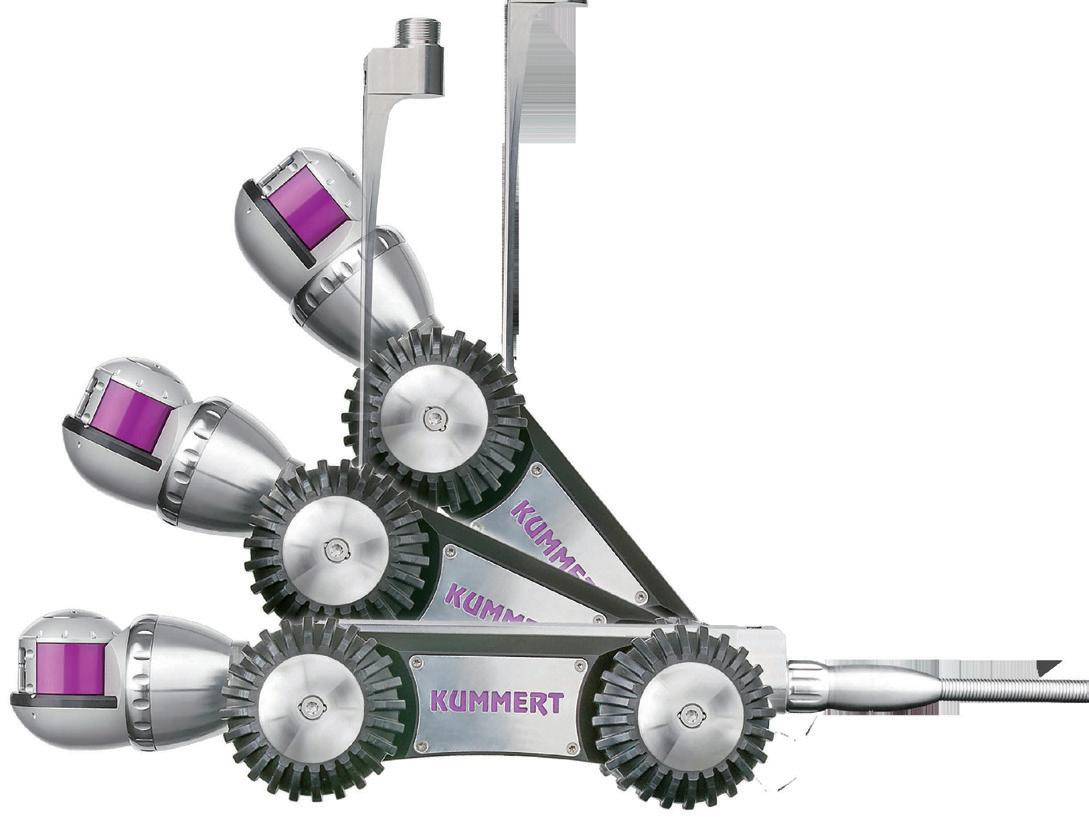

Austeck for an obligation free Quote & Demonstration A 11/77 Bourke Road, Alexandria NSW 2015 W austeck.com E info@austeck.com
287 835
F-100 CRAWLER Contact
1800





















































































































































































 JOHN GRIMES.
JOHN GRIMES.








































































































































































